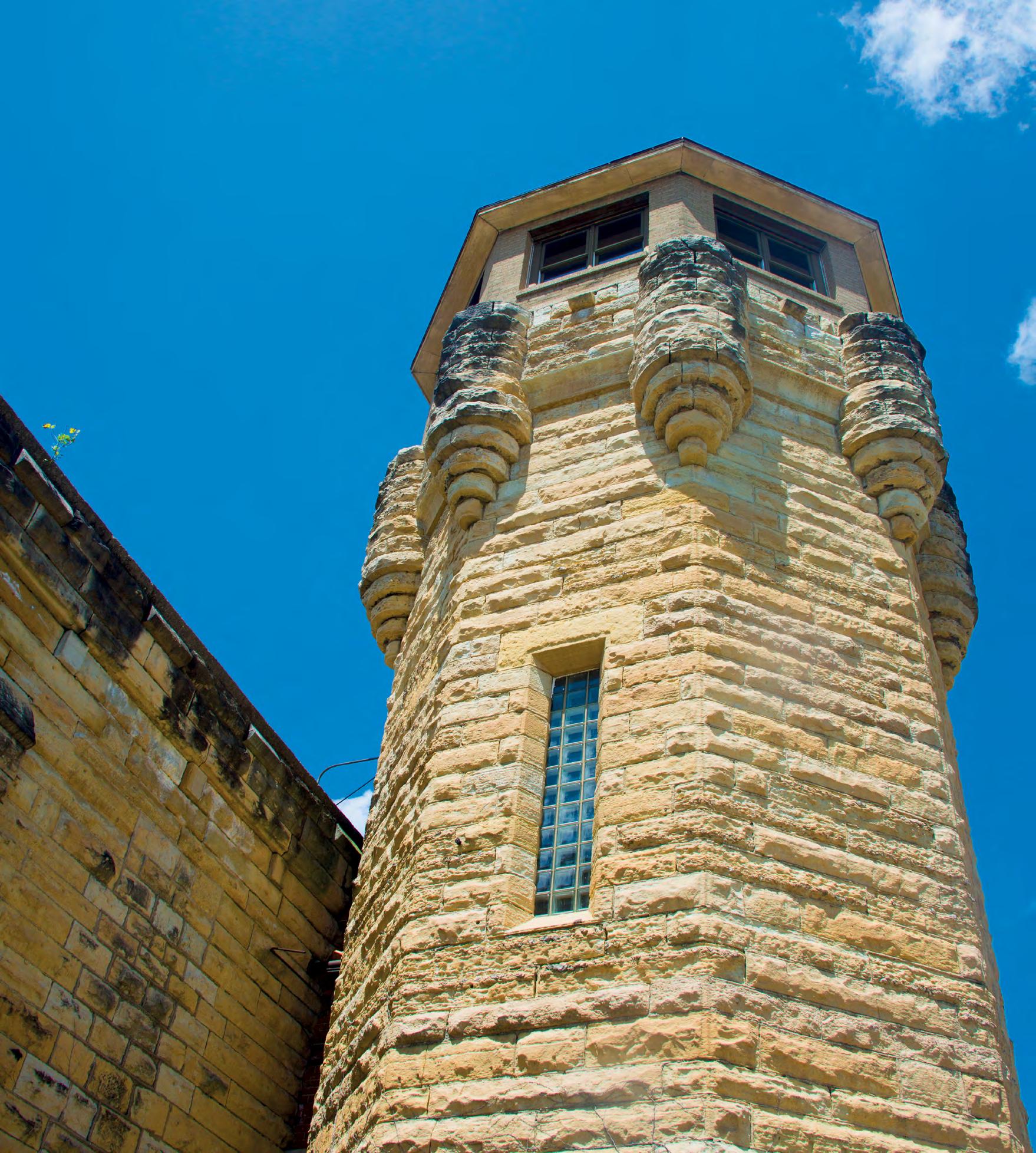June/July 2023
$7.99
Magazine

AMERICA’S MOST FAMOUS GHOST TOWN
WHERE IN THE WORLD IS HACKBERRY, ARIZONA? KEEPING TULSA QUIRKY
WHERE ROCK & ROLL STILL LIVES PROUD ON 66 +


June/July 2023
$7.99
Magazine

AMERICA’S MOST FAMOUS GHOST TOWN
WHERE IN THE WORLD IS HACKBERRY, ARIZONA? KEEPING TULSA QUIRKY
WHERE ROCK & ROLL STILL LIVES PROUD ON 66 +

Whether it’s classic cars, old fashioned burgers or a museum that brings history to life, you can relive the glory days of Route 66 in its birthplace. We love our city and know the best places to eat, drink and play. Get your kicks at the Birthplace of Route 66 Festival, August 10–12, 2023.
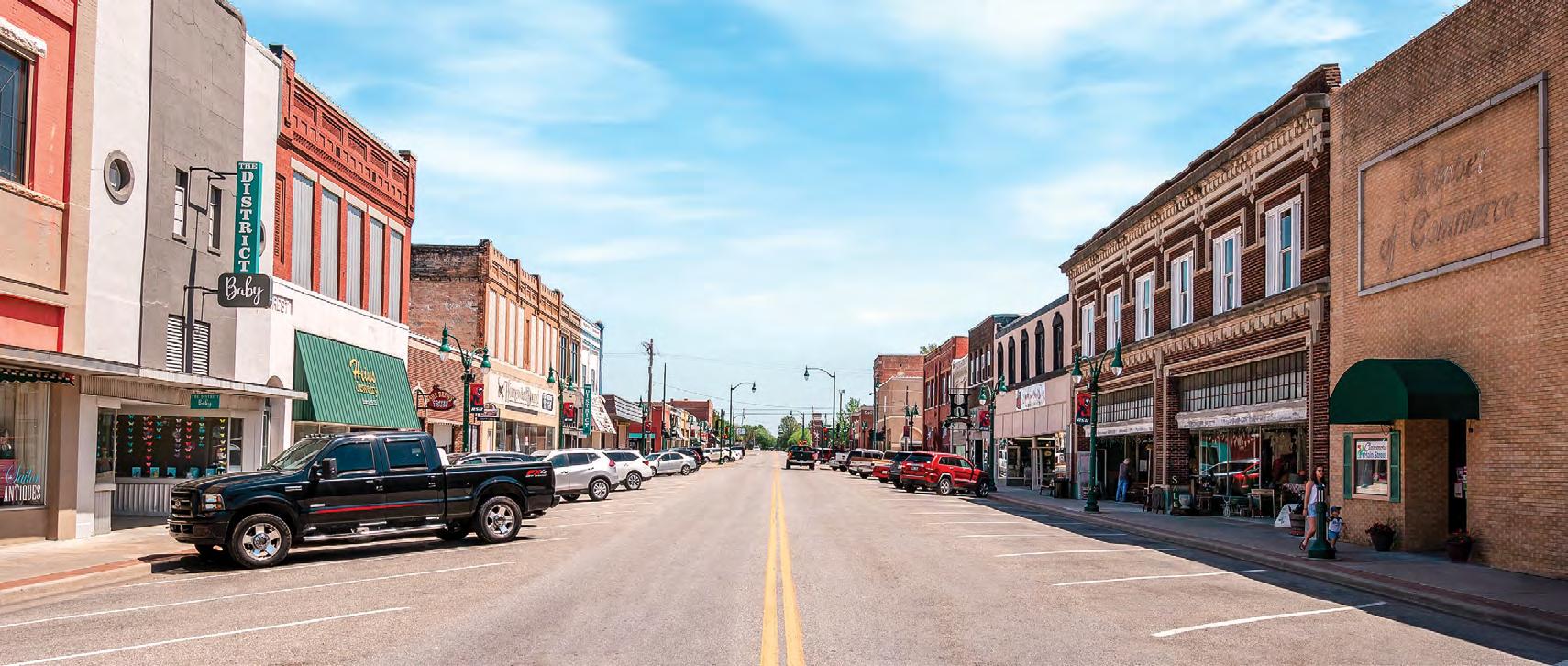

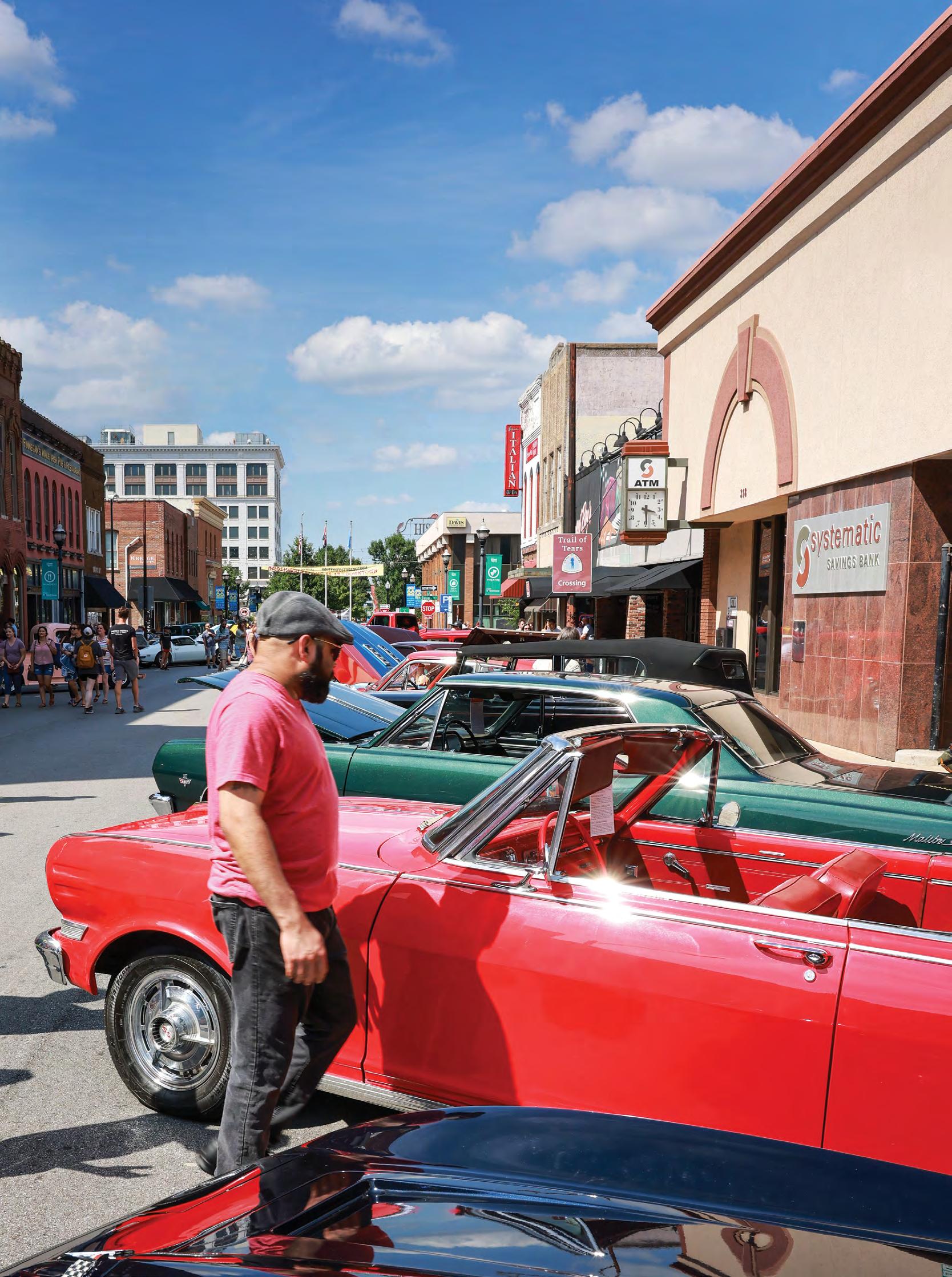



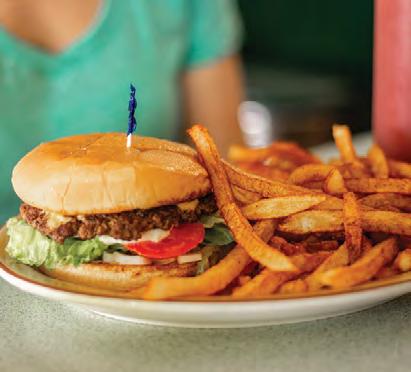




Here, a tropical conservatory bridges 15 acres of botanical beauty. Homegrown produce shines in homemade courses, where farm to table meets fine dining. Just off Route 66, a rustic lodge welcomes you to wine country. And a transplanted Ferris wheel offers breathtaking views of the Oklahoma River after decades of California dreaming.
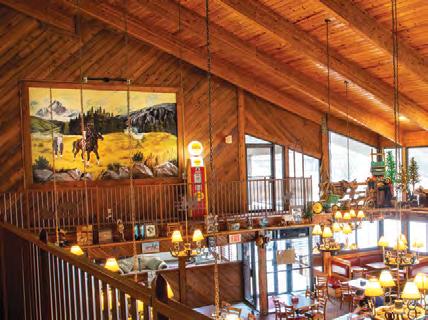

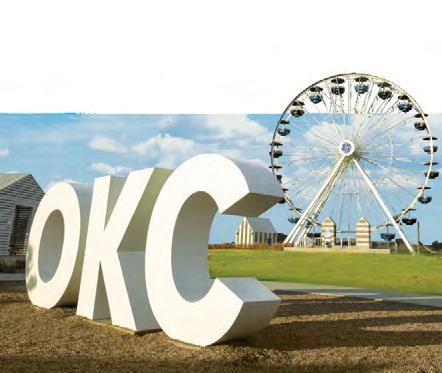



































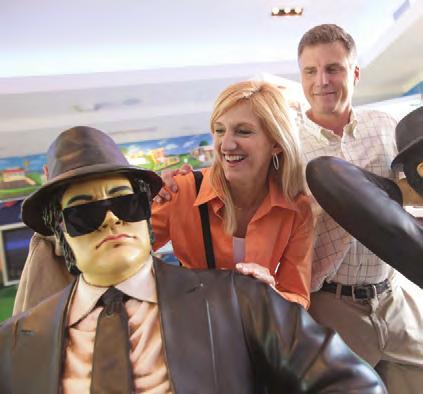






















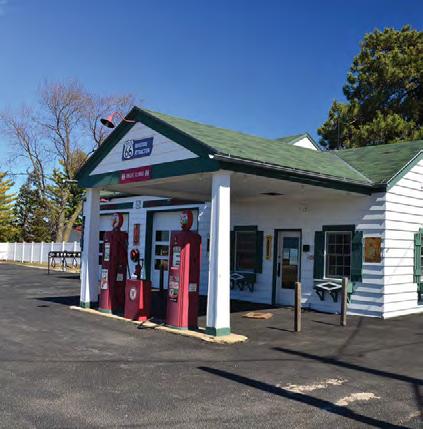






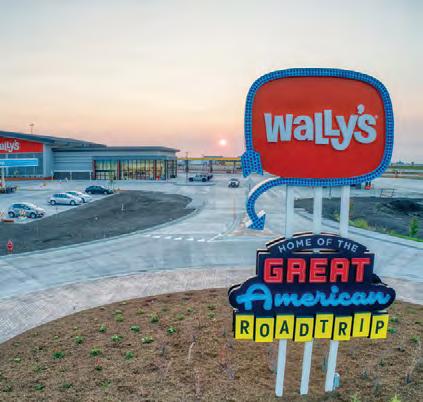






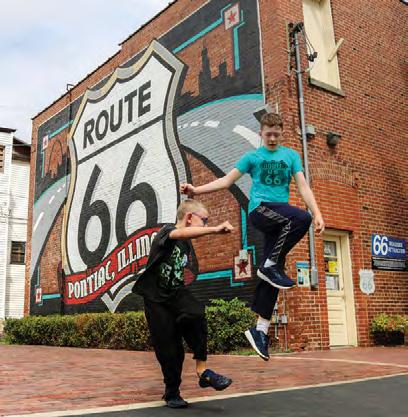








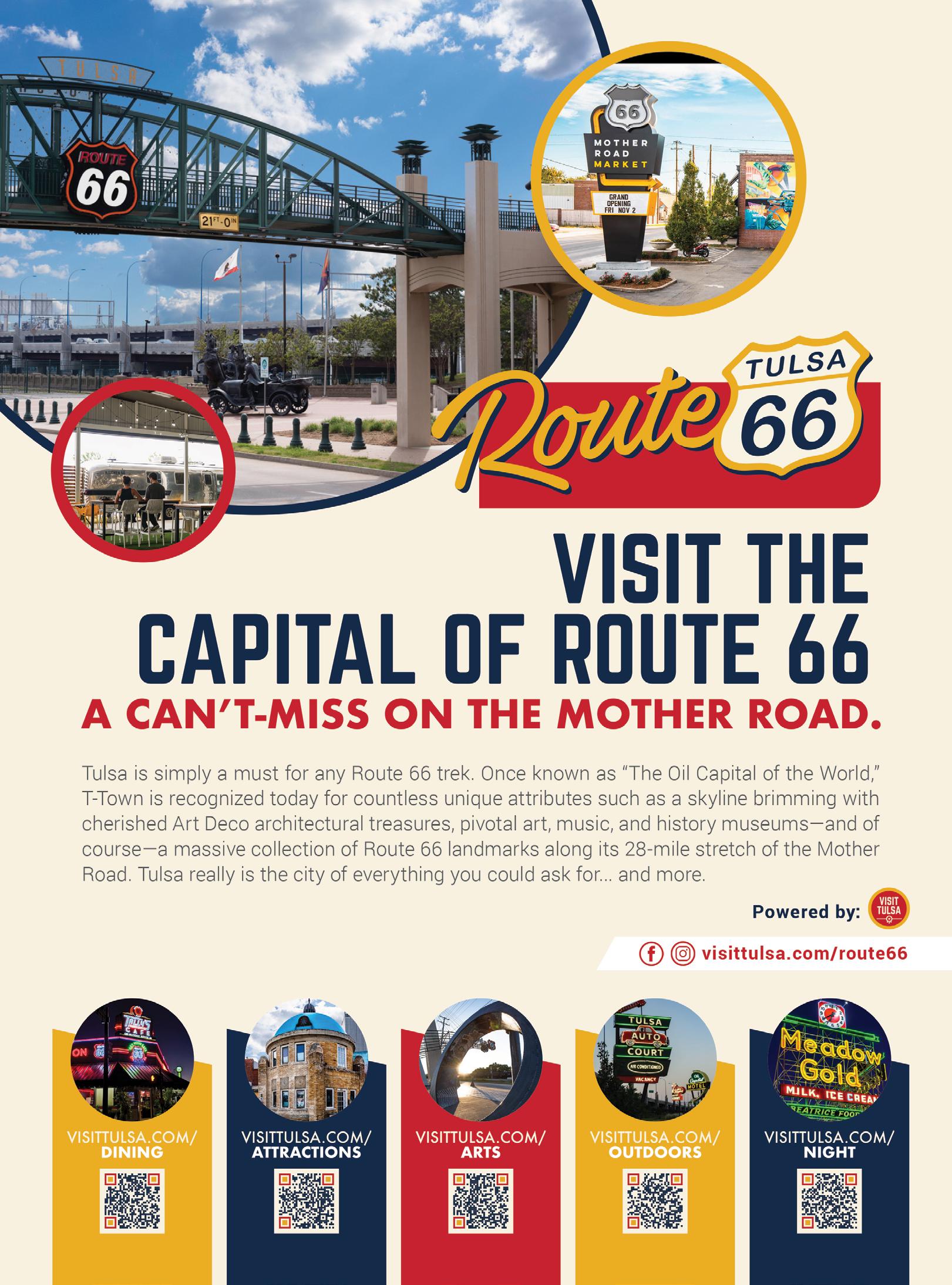
The Route 66 East Gateway is located on the north side of E. 11th Street just east of I-44. It has an LED Route 66 shield and lights up by night.
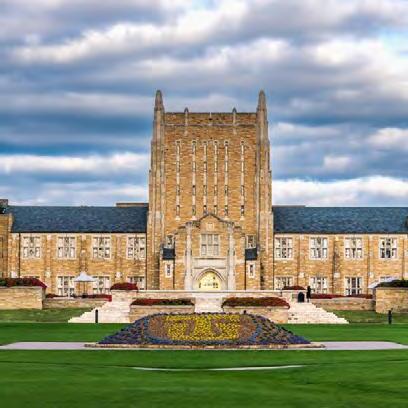
The University of Tulsa campus on historic Route 66 offers pre-statehood roots. TU boasts Division I athletics, manicured gardens, Collegiate Gothic architecture, and more.



A one-of-a-kind 70-feet by 30-feet structure from artist Eric F. Garcia dedicated in 2019. This massive installation draws inspiration from the Dust Bowl-era Depression, as well as the Mother Road’s beacon of hope.



Circle Cinema is Tulsa’s oldeststanding movie theatre that originally opened in 1928 and now operates 365 days a year as the only nonprofit cinema in the area.
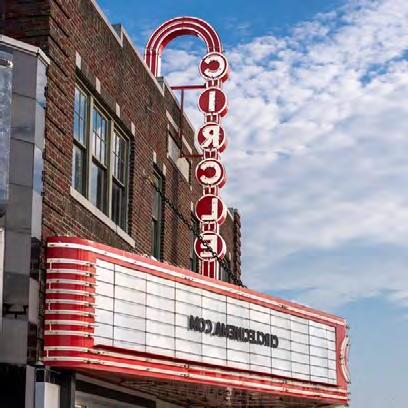
Buck Atom is a hard-to-miss 21-foottall space cowboy muffler man who stands outside of Buck Atom’s Cosmic Curios–a shop celebrating the magic of the Mother Road.
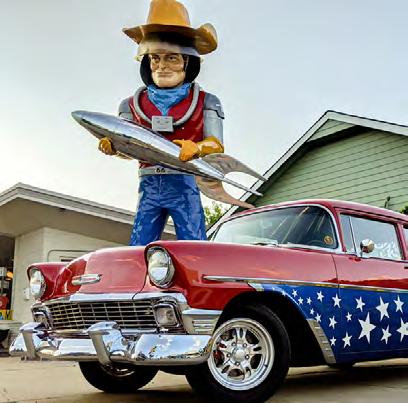




This open-air museum educates visitors about Tulsa’s history in the oil, refining, and transportation industries. Pop inside their Visitor’s Center – a replica Phillips 66 Station!

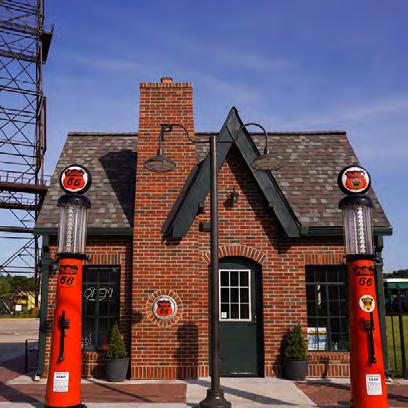
A plaza on Southwest Blvd. and Riverside Dr. featuring bronze statues, a skywalk and pedestrian bridge all honoring the father of Route 66, Cyrus Avery.
The namesake of the Blue Dome Entertainment District, the Blue Dome in downtown Tulsa was once a 1920s-era Gulf Oil station on the original Route 66 path.
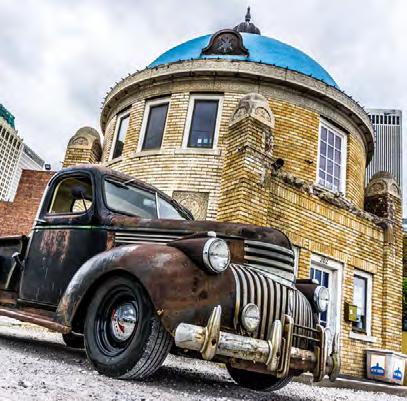









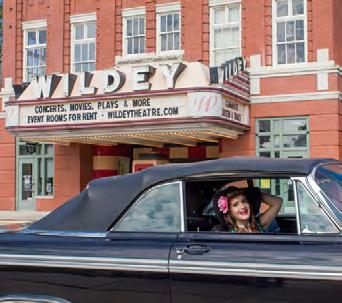


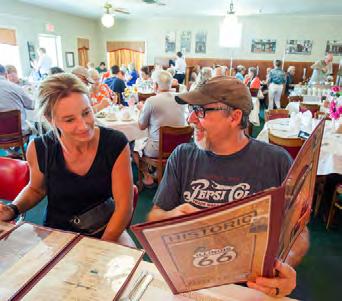





























































































Discover Springfield, Illinois - one of the most iconic stops on historic Route 66. The road comes through our “Living Legends & Landmarks” Explorer Passport with 14 stops to engage all of your senses! Plan your road trip, meet the legends face-to-face, marvel at the landmarks, snap some pics, and create your own Route 66 memories!






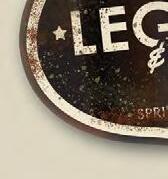




Pontiac, Illinois, is a real Route
Few places in St. Louis, Missouri, get as much Mother Road fanfare as Ted Drewes. Show up any night of the week and expect to join a large crowd of hungry, enthusiastic patrons thrilled to experience one of Route 66’s most beloved destinations.

Once owned by Mother Road icon Bob Waldmire, this “middle of nowhere” destination comes up on unsuspecting travelers quite unexpectedly and few fail to stop. This Arizona desert stop has garnered quite the global following but not many know the store’s layered history.
Huey Lewis sang about the heart of Rock & Roll being in Cleveland, but down in Joliet, Illinois, right on the Main Street of America, is a new museum making waves and urging people to take a unique musical journey through the decades of Rock & Roll.
Family-owned businesses have always been an important part of the Mother Road. They make up the backbone for which the spirit of the road has been formed. In Tulsa, Oklahoma, one neon laced restaurant embodies the essence of America’s roadside diner in spades.
At one point in time, the Whiting Brothers gas station brand ruled the highway. Today, the sole survivor stands in the tiny town of Moriarty, NM. This is its story.
Ghost towns are part and parcel of the Southwest’s empty landscape and road travelers have been keen on discovering and exploring them since their first inception. Up in northern California rests the granddaddy of them all — Bodie — a ghost town truly frozen in time.
As the first Hilton Hotel outside of Texas, the Hotel Andaluz in Albuquerque, New Mexico has quite the storied past, spanning decades, several owners and some spooky tales thrown in. Truly worth a visit.
Stewart’s Petrified Wood, Holbrook, AZ.
Photograph by David J. SchwartzPics On Route 66.

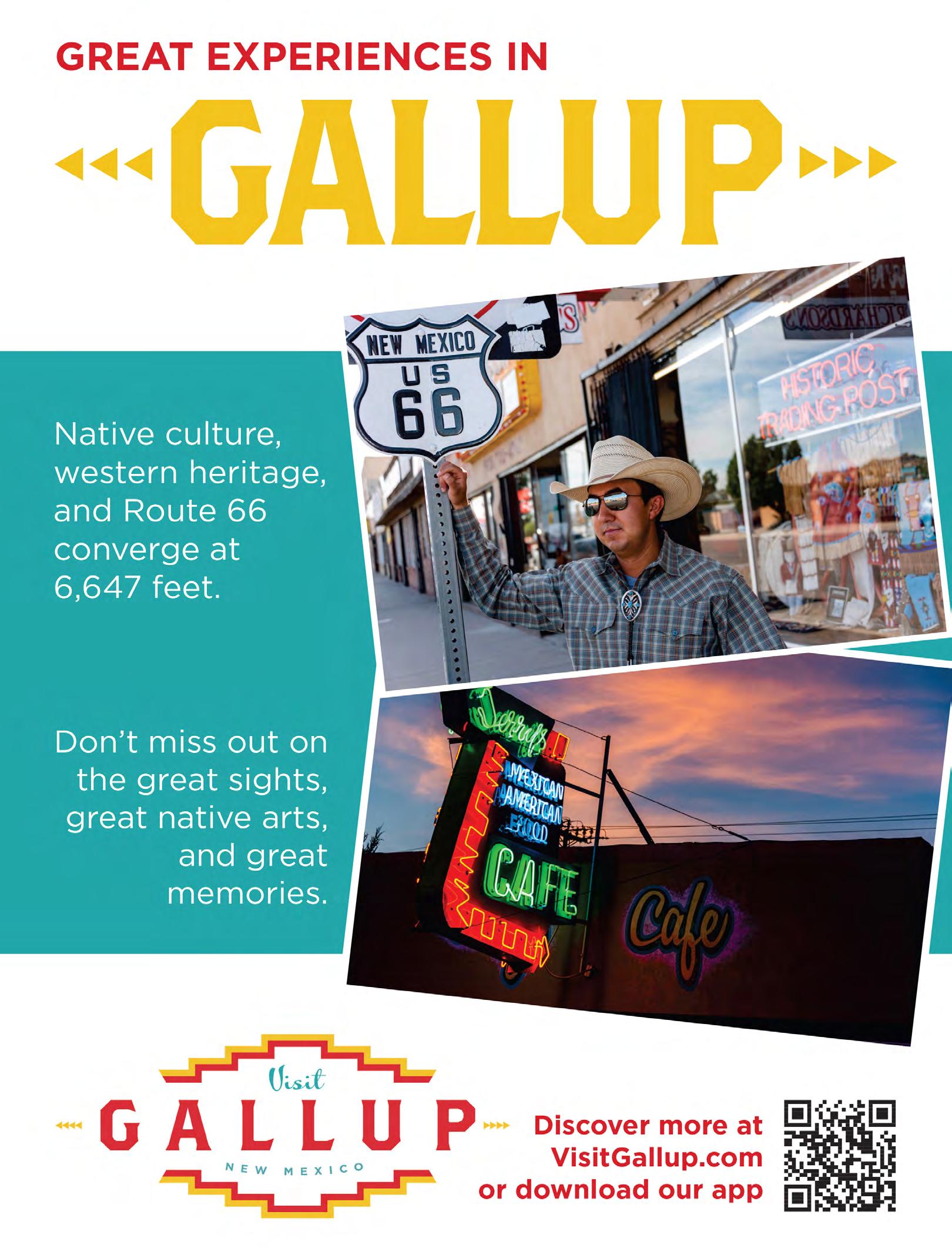
I’ve been reading Andrew McCarthy’s new book, Walking with Sam , about a recent trek that he took along the Camino de Santiago with his eldest son, 19-year-old Sam. The 500-mile walking adventure across one of Spain’s most beloved scenic routes showcases not only the diverse culture and beauty that can be found along “The Way” but also the very ability of such an arduous trip to influence and impact our relationships and our own perspectives and attitude. I worked with McCarthy for the April/May 2023 issue, and we had a wonderful time together but diving into this new book I feel like I understand him better and appreciate his personal journey as a man and a father more.
Yet, what really impacts me when reading this book is the realization that my own road trips with my son Thembi were very likely doing more to shape his young mind and spirit than he ever lets on. I mean, of course I’ve always held firmly to the belief that travel opens minds and expands horizons… blah, blah, blah, but most of us do not stop and really analyse how this is practically happening in our lives and in the personality and very soul of our children. Often, they don’t really show it. “Are you having a good trip?” “Yeah, it’s fun.” “What do you think you’ve enjoyed the most so far?” After they rattle off a short list, we usually feel affirmed and go back to living our own trip. But likely, there is much more going on inside of their hearts and minds than we bother to pay attention to; even they are not aware. It is our responsibility to nurture and cultivate it.
This June we are starting our eleventh trip down the Mother Road. We first discovered the historic highway when Thembi was eight and we had just moved to Canada from Kenya. The road trip was not only enjoyable and eye opening, but it hugely impacted our appreciation for and understanding of America. It broadened our worldview and created space in our minds for more ideas and ways of life. This year, I am especially interested in engaging with my son as he is now 15 and more likely to embrace the journey on his own terms. Regardless, I know that his love of roadside Americana and appreciation for the diversity of American history and personalities along Route 66 is undeniable. I’ve listened over the years as he tries to explain his experiences to his friends, but few seem to care or understand. Most of them have lived a life of airplane travel and resort-based “vacations.” I am grateful that Thembi has a lifelong tapestry of travel that is not only unique, but it has been off the grid, and it continues to make him a fuller, deeper, more passionate young man. Really, is there any better gift that we can give our children?
In this issue, we bring you the story behind some of the most iconic stops along Route 66. The roadside oasis in the Arizona desert of Hackberry General Store has long been a traveler favorite. Motorists out exploring the iconic highway, especially those from Europe, have been placing Hackberry General Store at the top of their must-see list for decades and the quaint, unassuming little shop has developed its own story along the way. Multiple owners, numerous names, and various visions for the store have created an unconventional experience for visitors: sometimes spooky and silent, sometimes energetic and jubilant. This destination has a fascinating tale to tell. If there is one thing that is unique to American travel, it is the ability to visit ghost towns, once bustling settlements that have long gone silent, left to decay in the march of time. And perhaps the most famous and well intact destination is the northern Californian town of Bodie. Many ghost town enthusiasts will have either visited Bodie or have it on their bucket list, but how many know the true and intriguing story behind it?
These and so many other stories fill this special summer issue. As you get out on the road this season, and if you are traveling with your children or grandchildren, slow down and take a moment to soak in the importance of the journey.
This month, I will be in Tulsa, Oklahoma, for some book signings. Join me on June 24th at Magic City Books and/or June 25th at the AAA Road Fest. I will also be at 21c Museum Hotel in OKC on July 1st for a book signing. Pick up your copy of Miles to Go: An African Family in Search of America Along Route 66 , today and bring it to get signed or grab a copy at any of these venues. I would love to meet you and get an opportunity to talk a little more in-person. So, come and join us as we showcase my new book and celebrate the Great American Road Trip and Route 66 together. Make sure to visit us online daily for news and updates and new stories not found in the magazine and follow us on Facebook, Twitter, and Instagram. And of course, subscribe now and never miss another amazing issue of ROUTE Magazine!
Blessings, Brennen Matthews EditorPUBLISHER
Thin Tread Media
EDITOR
Brennen Matthews
DEPUTY EDITOR
Kate Wambui
EDITOR-AT-LARGE
Nick Gerlich
LEAD EDITORIAL PHOTOGRAPHER
David J. Schwartz
LAYOUT AND DESIGN
Tom Heffron
DIGITAL
Matheus Alves
ILLUSTRATOR
Jennifer Mallon
EDITORIAL INTERN
Aaron Garza
Kristy Gillespie
CONTRIBUTORS AND PHOTOGRAPHERS
Chandler O’Leary
Cheryl Eichar Jett
Efren Lopez/Route66Images
Ellen E. Proctor
Greater Arizona Collection
Greg Disch
Jarrod Lopiccolo
Jim Luning
Jimmy Pack Jr.
Joseph L. Roberts
Juankr
Kelli Smith
Linda Doyne
Marianna Civitillo
Mia Goulart
Mitch Brown
Oscar Vasquez
Shannon Driscoll
Editorial submissions should be sent to brennen@routemagazine.us
To subscribe or purchase available back issues visit us at www.routemagazine.us.
Advertising inquiries should be sent to advertising@routemagazine.us or call 905 399 9912.
ROUTE is published six times per year by Thin Tread Media. No part of this publication may be copied or reprinted without the written consent of the Publisher. The views expressed by the contributors are not necessarily those of the Publisher, Editor, or service contractors. Every effort has been made to maintain the accuracy of the information presented in this publication. No responsibility is assumed for errors, changes or omissions. The Publisher does not take any responsibility for unsolicited manuscripts or photography.
21c Oklahoma City is the perfect road trip destination for the curious traveler. Explore our latest multi-media art exhibition, The SuperNatural, indulge in creative cuisine at Mary Eddy’s Dining Room or Pool Bar and Bodega, and make a night of it in one of our stylish and light-filled rooms.
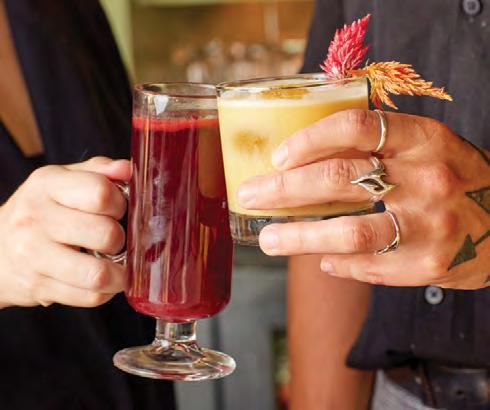

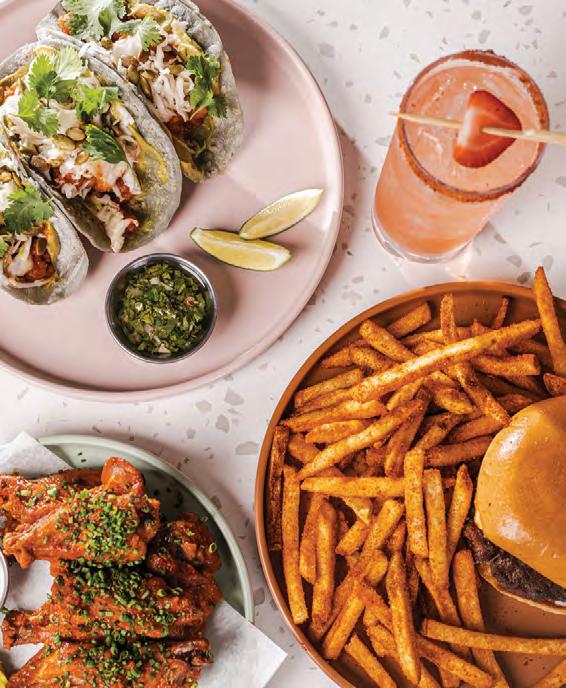





Two worn-down roads run parallel to one another on the edge of Broadwell, Illinois. Surrounded by fields of corn, a motel, and the Lincoln AG Center, there’s a sign that stands tall, and it’s not the ‘Welcome to Broadwell.’ This is the sign of the Pig Hip restaurant, and it, along with a plaque, is all that remains of the classic local diner that fed the people of both Broadwell and tourists driving through Route 66 for decades. But while gone, it has not been forgotten!
Back in 1937, a young Ernest L. Edwards Jr. — Ernie, to those who knew him — bought the Wolf’s Inn and changed the name to Harbor Inn due to the nautical wallpaper that invoked images of anchors and boats. He obtained the funding thanks to a $150 loan from his father, Ernest Sr., a factory worker who believed in the rewarding nature of being a self-made man and didn’t want his son to follow the same career path that he did. Ernie Jr. had plenty of experience working in food service, working in hot dog and popcorn stands at fairs and at Bea’s Ice Cream in much larger Springfield.
And it would not take him long to leave his mark with the famous Pig Hip sandwich, which would eventually, by 1939, become the restaurant’s namesake. As is commonly known by those who visited, Ernie only ever used one of the hips of pigs.
“You only take meat from the left leg because the meat wasn’t as tough as the meat on the right leg. It was because of which leg they stood on a hill or something silly like that,” said John Weiss, Chairman of the Route 66 Association of Illinois Preservation Committee. “Someone came in and said, ‘Give me a slice of that pig hip,’ that they saw hanging in the kitchen, and that’s what gave Ernie the idea to change the name.”
Soon, Ernie Jr. earned some minor celebrity as the owner of the restaurant, gaining the moniker of ‘The Old Coot on Route 66’ after the release of an article in the Chicago Tribune written by Mike Royko, that mentioned
a conversation he had with Ernie about Emil Verban, second baseman for the Chicago Cubs. Royko referred to Ernie Jr. as the ‘Old Coot in the Rocking Chair,’ and Ernie Jr. liked the sound of it so much that if he ever autographed a piece of paper, that’s how he would sign it. Being a self-starter became something of a family trade. While he ran the restaurant, his brother Joe ran their Phillips 66 filling station, and his sister Bonnie operated the Pioneer’s Rest Motel. All three businesses were on the same property, but today, only the latter remains, but not as a functioning motel. And in a true testament to Route 66, Pig Hip stayed open for decades, longer than the average business on Route 66, after the Mother Road was decommissioned. However, by the late 1980s, it had become too overwhelming for Ernie Jr.
“It was just too much work,” said Weiss. “He and his wife Frances, who was a waitress at the restaurant, felt it was time to retire. Business wasn’t nearly as good being on the outskirts of I-55, and you can’t make it strictly on tourism.” So, in 1991, Ernie Jr. closed Pig Hip’s doors as a restaurant and opened them as a museum, where it remained open for seventeen years. That’s until March 5, 2007, when a fire occurred.
“One day, he went to the store, and when he came back, the place was on fire,” said Weiss. “It was in the attic. So, we assume that a squirrel chewed through some wires, and by the time he got back from the store, the fire was already engulfing it, because no one could spot it sooner, and by the time the fire department got there, it was too late to save anything.”
Today, all that remains of the Pig Hip restaurant is the restored road sign, a commemorative plaque on a boulder where the building previously stood, and a few surviving artifacts that reside at The Mill Museum on Route 66 in Lincoln, Illinois. Ernie Edwards passed away in 2012 at age 94, but he left behind a remarkable life and a career at a restaurant that became something of a legend on the historic Mother Road.
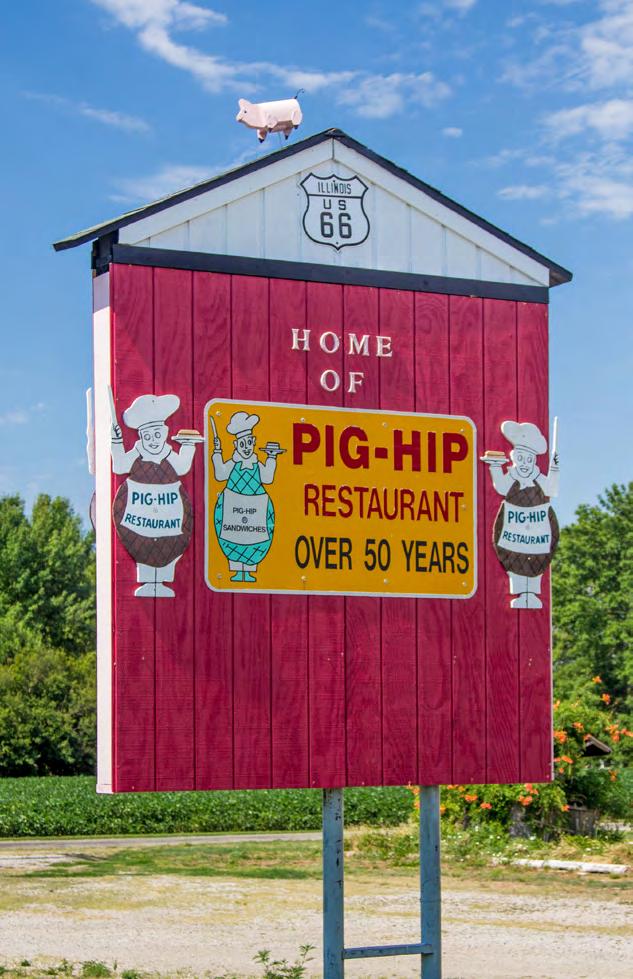


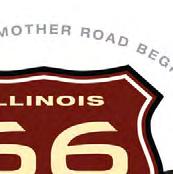



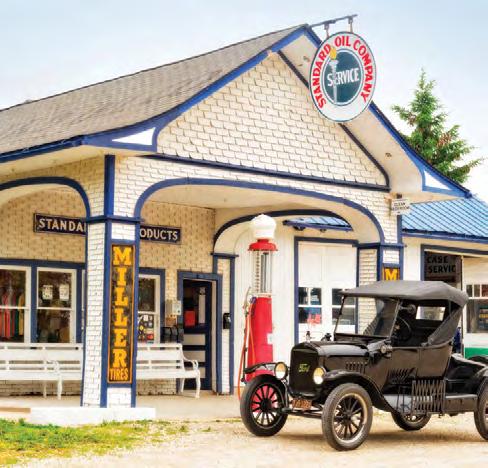
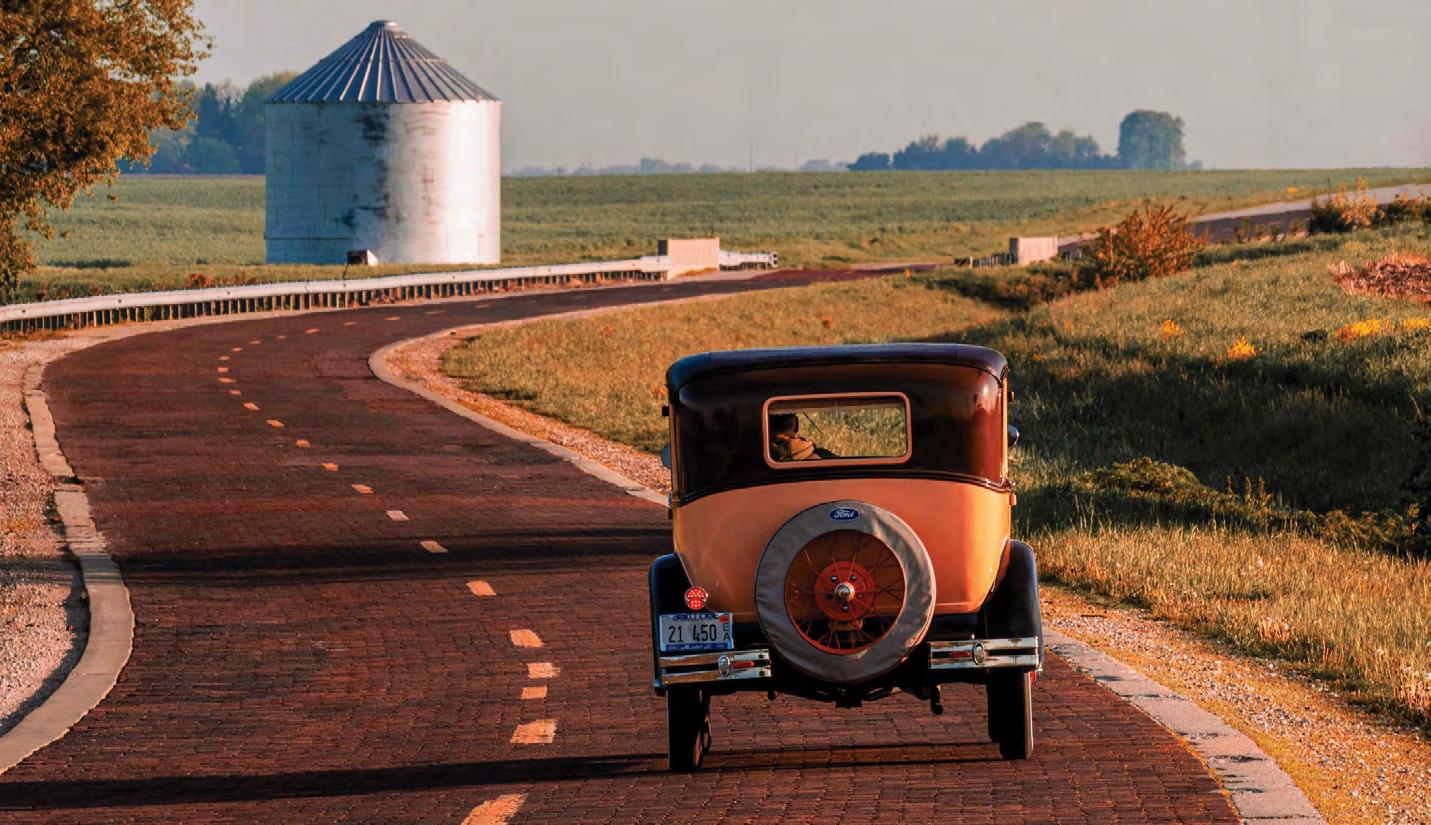
It’s March 1907, and John Melville Bayless, an entrepreneur, and businessman in the area, breaks ground in Claremore, Oklahoma. He’s building a home for his family to settle into, and the groundwork for the house is laid in Indian Territory. But in eight months, it will rest in Oklahoma, one month after President Roosevelt issues Presidential Proclamation 780, declaring it the forty-eighth state. The Victorian, Painted Lady-style mansion will stand three stories tall, be framed with four towers, and even have woodwork shipped from the St. Louis World’s Fair. It’s the Belvidere Mansion, and with time, it will become known as the Belle of Rogers County.
During his time in Claremore, Bayless was sure to leave his mark and show his worth. Having moved his family from Cassville, Missouri, to Sulphur, Oklahoma, and finally to Claremore in 1900, Bayless saw financial opportunities in the Indian Territories due to the presence of the railroads.
“He was a banker from over in Missouri; he also acquired the right of way for railroads,” said John Cary, volunteer director of the Belvidere Mansion. “If a town didn’t have a railroad, but it needed a short spur [line] built, he would acquire the right of way, and if he thought it was a good deal, he’d basically hang onto part ownership of it in exchange for his work acquiring the right of way. Otherwise, he would just ask for payment. But anything real estate related, or anything bank related, he was involved in.”
He chose Claremore over Tulsa because it had two railroads instead of Tulsa’s one.
Upon arriving in Claremore, he already had the construction of the Cassville & Western and the Arkansas & Oklahoma Railroads under his belt. Along with the development of Belvidere Mansion, which cost him somewhere between $25,000 and $50,000, or roughly $800,000 to $1.5 million when adjusted for inflation, he would also go on to build the Windsor Opera House, the Claremore Athletic Association, and the Sequoyah Hotel, which housed the Bank of Claremore. Out of all of these structures, the mansion is the only one to remain fully intact today. The tragic irony is that Bayless wouldn’t live to see his home completed. In June 1907, he suffered a fatal Appendicitis attack and died
prematurely. His wife, Mary Melissa, and their seven children would, however, go on to live in the mansion until 1919. By 1926, the mansion would house new residents when the Bell family purchased it. The 9,000-square-foot building was repurposed into a complex with twelve apartments on the second and third floors. However, when most of the family who owned it passed away, and the rent from the tenants wasn’t enough to keep it going, the mansion fell into disrepair in the 1980s and by the 1990s, it was all but deserted. Fortunately, in 1991, the Rogers County Historical Society, led by President Wanda Moore, purchased the property and began restorations.
“She saw the building and decided that it was a building that needed to be saved. She was a local dynamo who was able to find people who were interested in helping her,” said Cary. “We had a local pediatrician who headed up the effort and cosigned a mortgage to borrow money to buy it for $75,000. It was in very poor condition. We don’t get any federal, state, or local funds. All of the money we’ve been putting into the building [is from] donations and fundraising; some people have even left money to the Belvidere Historical Society in their wills.”
The Belvidere Mansion — aptly named “Belvedere” meaning a building with a view — currently rests on the corner of 4th Street and Chickasaw Avenue in historic Claremore and is safely listed on the National Register of Historic Places. Because of its age, maintenance is a constant priority. Upkeep and maintenance gets paid thanks to donations from people around the community, especially those who donate following the daily free tours around the glamorous home. The third-floor ballroom is rented out monthly for special events like proms and weddings, and the first floor is rented out to a restaurant called The Pink House, which has been voted “Best Place to Have Lunch in Claremore’’ by the Claremore Daily Progress.
John Melville Bayless did not get to enjoy the fruit of his vision, and his family only resided at the home for a little more than a decade, but sometimes, if we are lucky, our work and dreams live on beyond us. Over a century later, the mansion continues to overlook the city of Claremore, and is a reminder of one industrious man and his short time in Oklahoma.



Photographs by David J. Schwartz - Pics On Route 66

om-and-pop businesses were once the backbone of the communities dotted along American highways. Most of them opened and closed with the cycle of the owners’ lives or the popularity of the throughway along which they stood. A few survived threats like generational change, highway bypasses, chain venues popping up next door, and the changing tastes of the motoring public to become legendary must-stops.
And so, it’s rare — but not unheard of — when a momand-pop business, begun on a shoestring and intended simply as a means to eke out a living, endures through multiple generations and rises to a level of popularity that makes it a given, the absolute go-to place, after baseball games, the theater, or a visit to the zoo. It’s even more uncommon when that modest family business rises to the iconic status of being mentioned in the same breath as the city’s legendary baseball team or outdoor theater.
But so it is in the City of St. Louis. Cardinals baseball, The Muny in Forest Park, the Gateway Arch, Ted Drewes. Yes, Ted Drewes Frozen Custard is one of those places that visitors and tourists make a beeline for. Its iconic status is known well beyond St. Louis’ environs, and it’s most definitely on the Route 66 bucket list. “The one thing everybody can agree on is that they love Ted Drewes,” said Joe Sonderman, Route 66 author and St. Louis radio personality. “You go to Cardinals games, and every time the Cubs [play] here, you can go back to Ted Drewes and there’ll be the Cubs fans with their blue caps and the Cardinals fans with their red caps standing in line at Ted Drewes, and they can share the experience. It’s the great melting pot — all ages, all demographics, all lifestyles. Everybody’s welcome at Ted Drewes.”
Truly, the Ted Drewes story is a unique one, involving not just tasty custard and a catchy slogan (“it really is good guys...and gals”), but professional tennis, carnival stands, Christmas trees from Nova Scotia, and three generations of a St. Louis family. This tale is one for the history books, and St. Louisans love to tell the story.

The Ted Drewes story began in 1898, when Ted R. Drewes (Sr.) was born in Hannibal, Missouri, to Reverend Christopher and Laura (Motz) Drewes. In 1905, Reverend Drewes took a call to Bethany Lutheran Church, a St. Louis congregation, and the family, including little Ted and his older brother Walter and sister Laura, moved to the big city. The Reverend became a well-known pastor and leader in the Missouri Synod Lutheran organization. But his son, Ted R. Drewes (Sr.), became famous for his winning tennis skills. The boy began playing tennis at age 11, often playing on the city’s Forest Park courts, and he became a well-known player, winning the Municipal Association title fifteen times (between 1916-1935); four consecutive National Public Parks
Mchampionships (beginning in 1924); and The Muny title twelve times (1924-1935). As a young adult, when he wasn’t playing in St. Louis, he played in Florida during the winters. But when he was in St. Louis, he alternately taught tennis at Concordia seminary, worked as a newspaper sports reporter for the St. Louis Star, and was employed as a clerk by Wagner Electric. In the early 1920s, between one job or another, he married Mildred Schaefer, who, like Ted, was from a German immigrant family.
During one of his trips to Florida, Ted was introduced by a friend to the idea of making money from the increasing popularity of frozen custard stands. Ted bought a custard-making machine and a recipe, and in between tennis tournaments, earned income traveling with a carnival, setting up a small stand, and selling frozen custard. In 1929, he opened up his first fixed location custard stand at St. Petersburg, Florida.
The next year, he opened what would be the first of several St. Louis locations, on Natural Bridge Road. There, his stand was on a 50-foot lot, sandwiched in between Sam the Watermelon Man and Balsano’s Shell Station. In the early ‘30s, Ted opened a second location at 4224 S. Grand Boulevard. Meanwhile, his wife Mildred let Ted know that it was time for him to quit “commuting” between St. Louis and Florida, what with two St. Louis business locations and also four children.
Ted apparently paid attention to Mildred’s admonition, and in 1941, the Drewes family would make what many would argue as the most propitious move of their business. The St. Louis Hills neighborhood, created by developer Cyrus Crane Willmore, was growing rapidly, and through it came U.S. Highway 66 and the promise of many business opportunities. So, the Drewes family fortuitously took advantage of that promise with a new location on Chippewa Street.
Many years later, in a 2019 interview, Ted’s son, Ted Drewes Jr., shared his memory of his mother excitedly telling him that their new store location would be on the famous Route 66. “I knew it was special and I never forgot that,” Ted Jr. said. There, in St. Louis Hills, the new Ted Drewes Frozen Custard location at 6726 Chippewa would grow to be the most important and famous one in the group.
Ted Drewes Jr. grew up knowing how to work hard. He once said in an interview that his father got him his first job picking up trash in the neighborhood. As he grew up, young Ted had a role model. Ted Sr. consistently worked additional jobs during the winter months to pay the bills when the custard stand was closed — he managed an archery range, he ran a combination swimming pool and roller rink, and sold pastries.
Ted Jr. got married in 1950 to his sweetheart, Dottie, one of the Ted Drewes carhops, and started a family of his own, while Ted Sr. thought about retiring — but kept on working. Mulling over the family’s assortment of additional jobs, Ted Jr. hit upon the idea of selling Christmas trees from their custard stand lot to bring in income during the custard business off-season.
“So, Ted Jr. said, ‘Dad, we got to get an income for the wintertime.’ They did all kinds of things — Fuller Brush salesman, door-to-door sales, owned a roller rink — but they really struggled in the winner because there was no income,” explained Travis Dillon, son-in-law of Ted Drewes Jr. and the third generation to operate the frozen custard stand. “So, he convinced his father to get some Christmas trees from Nova Scotia. They actually went to Nova Scotia and then shipped them down by railroad. And those trees started selling — they were the most beautiful Canadian Balsam Firs. [Most] Christmas trees at that time were basically domestically grown — Scotch Pines grown in the Midwest — and they look nice. But boy, when you saw these beautiful Balsam Firs from Canada — we were the only place selling [them] in 1956.”
The 1950s saw two other changes to the business. Due to crime and declining sales, the family made the decision to close the location on Natural Bridge Road. And, more importantly, the famous frozen treat known as the
“Concrete” was born! The way the story goes, a boy in the neighborhood kept after Ted Jr. to make a thicker shake — as thick as possible. Ted Jr. took on the challenge and made a shake without the milk. Presenting a thick upside-down shake to the boy who started it all, the youth said that it was “like concrete” and the name stuck.
Another change that Ted Jr. made was to begin advertising in St. Louis media. With his upside-down Concrete to show how thick it was, to his slogan — “it really is good guys — and gals,” Ted Jr. became a beloved spokesperson on St. Louis TV channels. Between the Christmas tree sales in the winter and the catchy advertising, Ted Jr. is credited with growing the business into a St. Louis icon and making it a viable long-term family business. By about 1980, it’s clear from newspaper articles that Ted Drewes Frozen Custard had really arrived and was an accepted element of St. Louis culture.
“If it wasn’t for Ted Jr., my father-in-law, I’m not sure what would have happened, because he was the instigator of starting to advertise the frozen custard,” said Dillon. “Before that, the business was just barely getting by, because there’s so much competition. He really had to push him [Ted Sr.] to start advertising. But then Ted Jr. became such a fantastic, outgoing spokesperson for the business.”
However, when Ted Sr. died at the age of 70 in 1968, he was still known more for tennis than for frozen custard.

A newspaper article began, “Theodore R. (Ted) Drewes, one of the greatest tennis players developed in St. Louis, died early today...” After enumerating his tennis awards and honors in several paragraphs, the article stated, “Drewes had a far-flung Christmas tree business and operated two frozen custard stands in south St. Louis.”
But Ted Jr. successfully switched up the focus from tennis to custard. With Ted Jr.’s smiling face on TV touting custard and good times, and St. Louisans lining up at the lot in December for some of the best Christmas trees in town, the business moved up to iconic status. After sports games and concerts and theater, for birthdays and anniversaries and just because, locals lined up ten deep at the wooden windows to order special Ted Drewes custard concoctions. And it didn’t hurt anything that its Chippewa location was right on iconic Route 66. In 1985, to accommodate the growing crowds, they expanded from five serving windows to an impressive twelve. By then, just the two South Side stands — South Grand and Chippewa — remained, and they stayed busy.
“The Hill and South [locations] really remain stuck in the ‘40s and ‘50s. It’s still a tight-knit, clean neighborhood, and Ted Drewes is a part of that,” said Sonderman. “When you step into the [neighborhood], you’re taking a trip back in time. I think people take comfort in knowing that the concrete you had in 1959 is the same [now].”
Ted Jr.’s daughter Christy, no stranger to working at the custard stand, met and dated Travis Dillon while they were both in college in the ‘70s. “When my wife and I got married in 1977, I was working for a CPA firm after college,” explained Dillon. “The accounting business was just fine for me, but, after a while, Ted would ask me to help out a little bit. I was happy to do that. I went in for maybe one time a week at first and it grew to three or four nights a week, and I was still working for that CPA. Then Ted came to us and
said, ‘I could really use your help, Travis.’ He was working so many hours and we were feeling sorry for him. He asked me to go full-time, and my wife agreed with me that if I’m going to work this many hours anyway, I may as well do it.”
Travis and Christy are still there as co-owners and operators of the business, some 45 years later, and it seems to have worked out just fine for everyone. “We’re just tickled pink that we’re still able to hang in here,” quipped Dillon. “I think it’s fun. In what other business can you see your customers walk away smiling from ear to ear?”
Ted Drewes Frozen Custard celebrated 90 years in the business by hosting a celebration on April 25, 2019. Attended by local celebrities and politicians, former employees and longtime customers also turned out en masse. Even Fredbird, the St. Louis Cardinals mascot, showed up. Unfortunately, a drenching rain fell for a good share of the day, but Ted Jr. and Dottie presided over greetings and congratulations under the protective canvas of a tent. “And so, the hundredth [anniversary] is on our mind; we are wondering what we’re going to do,” Dillon mulled.
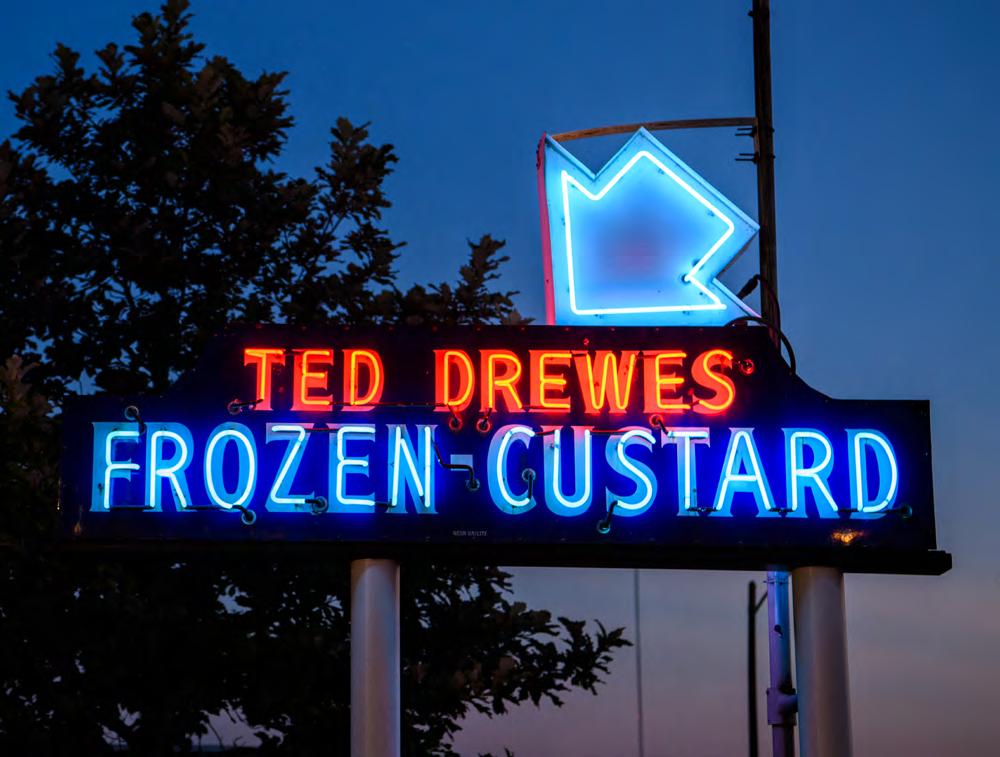
It’s still a family affair, with Travis and Christy Dillon at the helm, and on special occasions, Ted Jr., with Dottie by his side, still appearing as the beloved spokesperson. “It’s really good, guys, because Ted is St. Louis through and through, because he’s from here, he was born and raised here, and he’s proud of it and of Route 66 and the TV commercials,” said Sonderman. “The man always has a twinkle in his eye and a smile when he talks about Route 66.”
Approaching the century mark, the family still has no plans whatsoever to franchise the custard. “He [Ted Jr.] always said that if you want a business to run well, you have to be there and pay attention to the details. If you franchise it, you’re giving your business away to someone else to keep your name in quality,” said Dillon. But Ted Drewes products are available in the St. Louis area at Dierbergs, Shop ‘n Save, Schnucks, and Walgreens stores, plus in vending machines at Lambert-St. Louis International Airport. The recipe remains unchanged and is a closely guarded secret, although it’s a given that it’s mostly eggs, cream, vanilla, and honey — with no preservatives. One of the favorite variations is still the “Dottie” — your choice of a concrete or a sundae with mint, chocolate, and macadamia nuts. And just like frozen custard in the warmer months, the Ted Drewes Christmas Trees are undeniably still a holiday tradition.
“St. Louis is very big on sharing things from generation to generation. With Drewes, three generations have now grown up in the neighborhood, having the same experience for 90 some odd years now,” said Sonderman. “That’s why remembering these people is important now. Who will be the person who says, ‘Hey, there was this guy who sold frozen custard from a building trimmed with wooden icicles that you should know about, and you should know what an icon he was, and how important to St. Louis he was, and how his place anchored not just the neighborhood, but our region.’ And I think it’s kind of up to us to make sure people hear that story.”
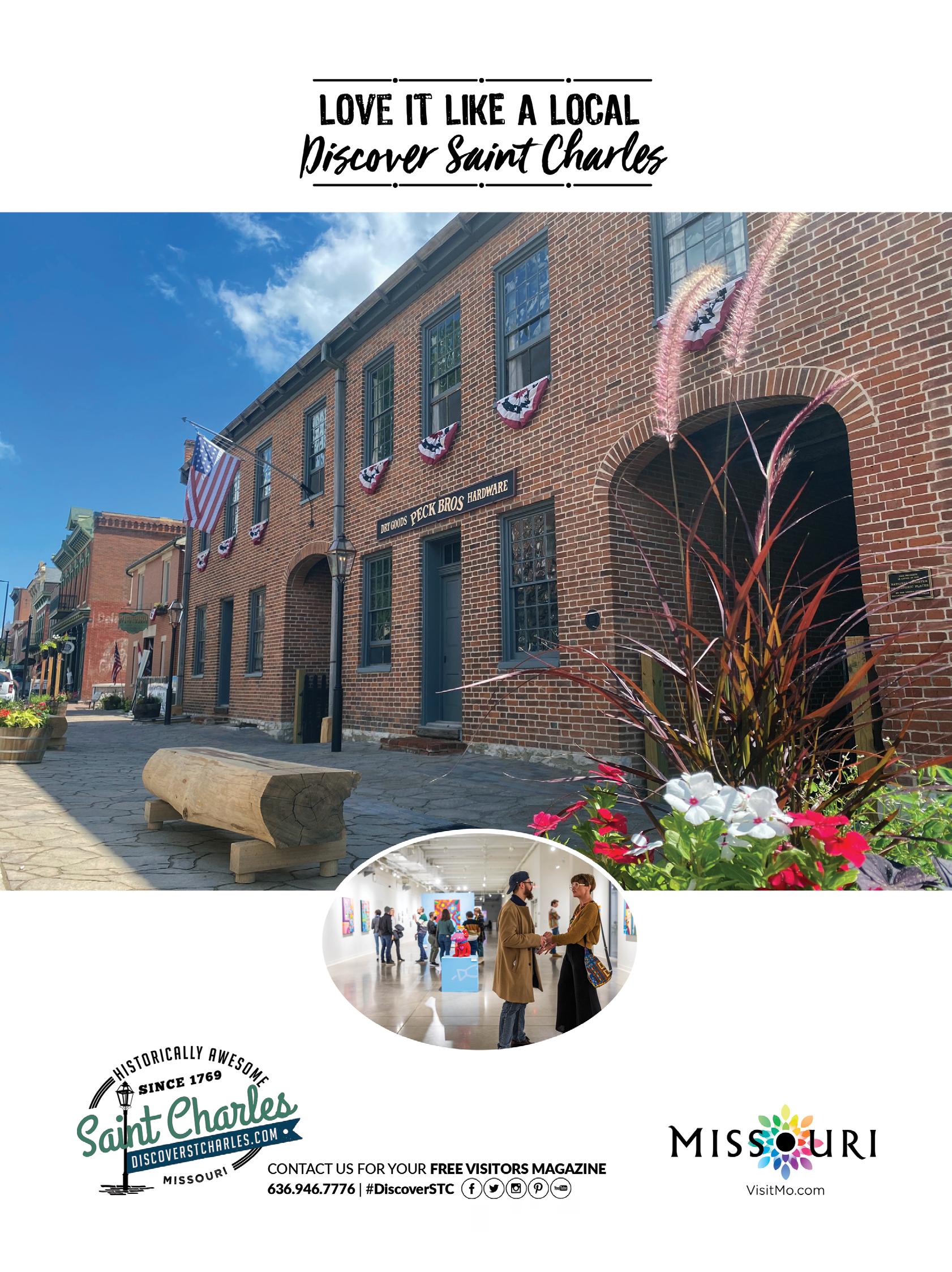
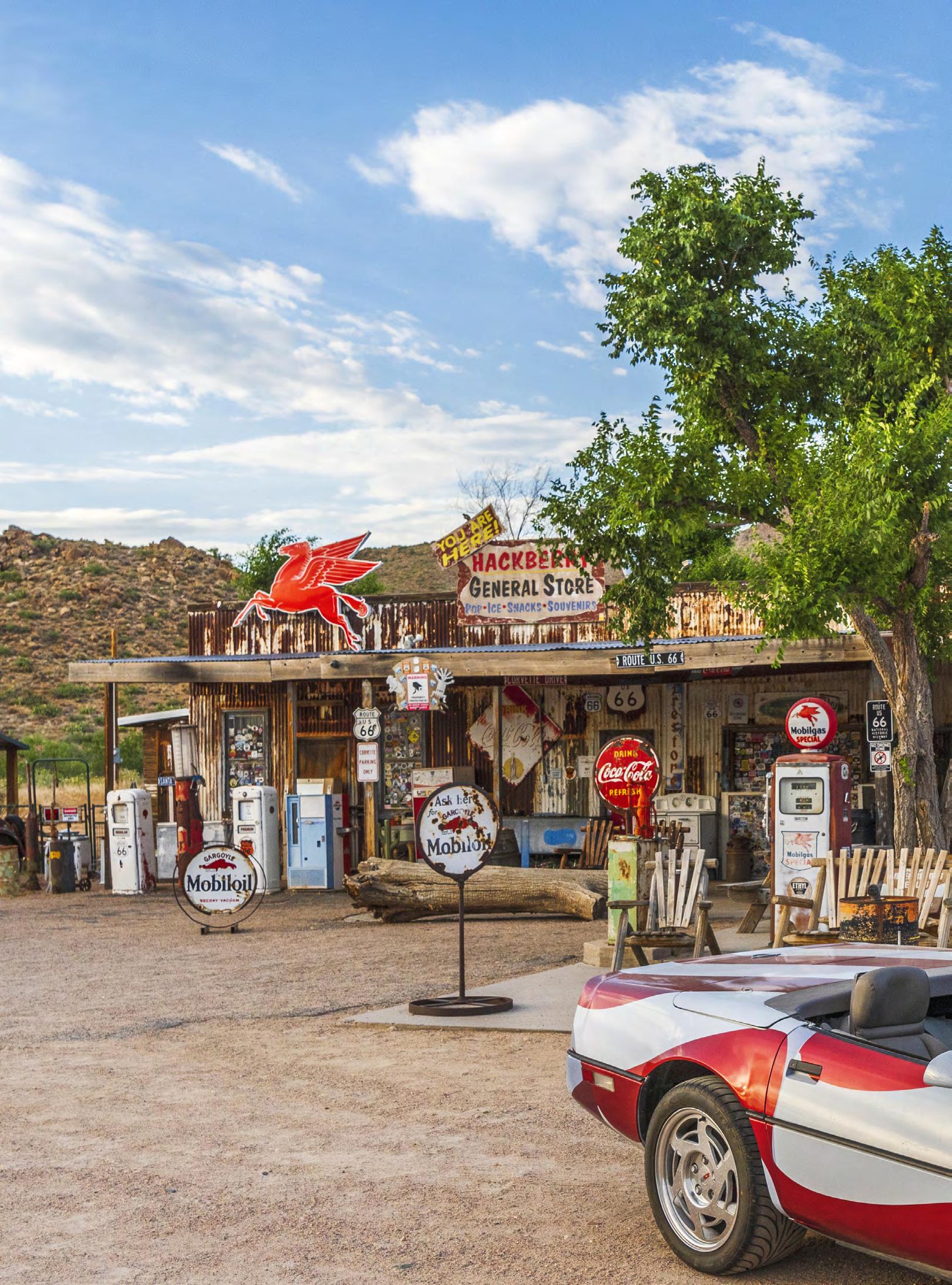 Roberts
and Joseph L.
Photographs by Efren Lopez/Route66Images
Roberts
and Joseph L.
Photographs by Efren Lopez/Route66Images
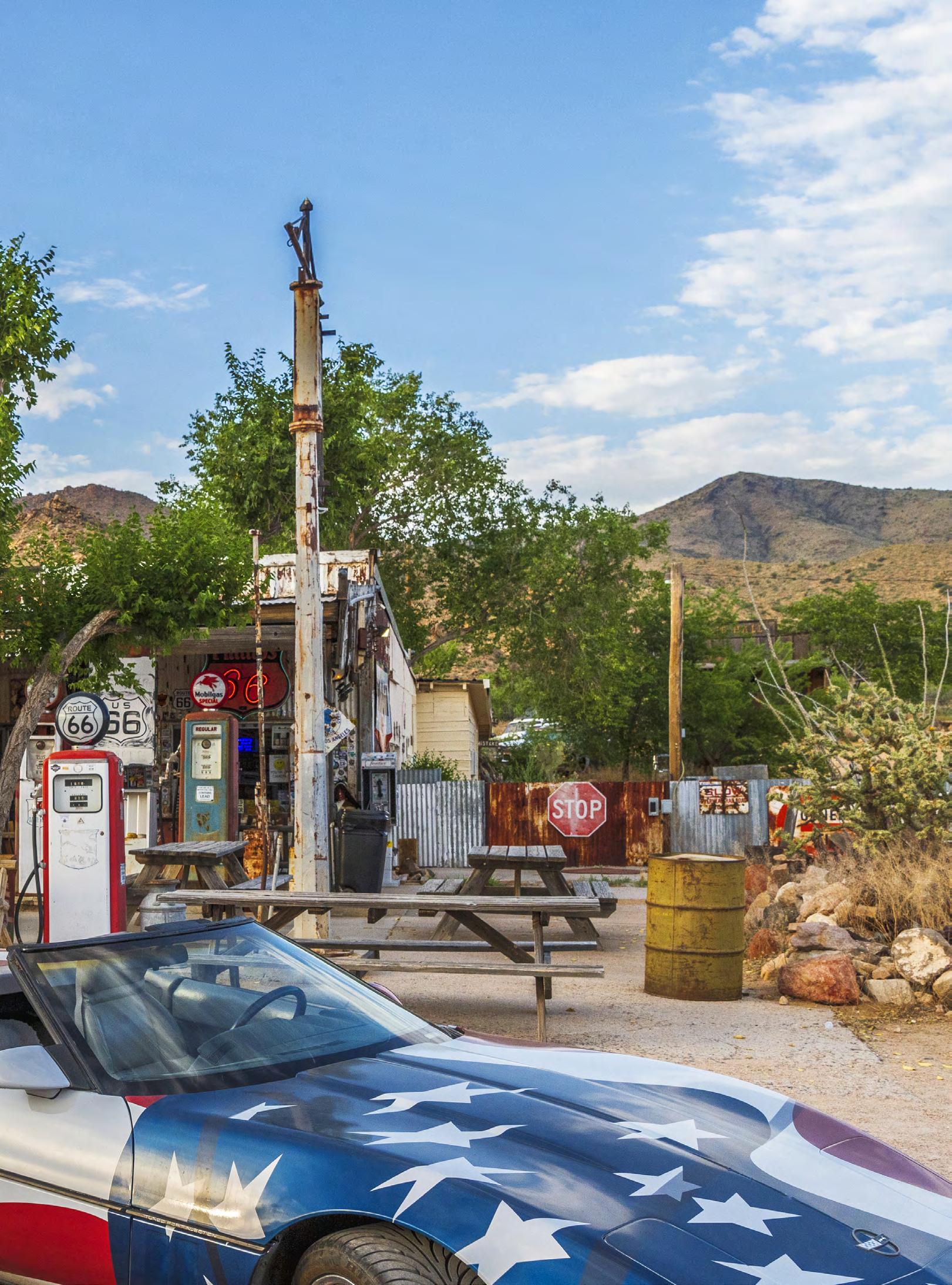
wenty-plus miles north of Kingman, Arizona, where the original Route 66 forms a parabola, rests the only natural pass through the mountains of Mohave County between the towns of Hackberry and Valentine. The canyon area is known for its colorful rocks and rough terrain. Western yarrow, desert grass, and Arizona cottontop line the road. It seems like the only living things out here are the flora and fauna that call this place home.
Yet as you round a slight curve, a large, silver water tower stands on the right, announcing that the landmark Hackberry General Store is just ahead. A phalanx of antique gas pumps and retail signs stand facing 66; a sign above an awning announces, “YOU ARE HERE! HACKBERRY GENERAL STORE.”
Located less than a half mile as the crow flies from the “town” of Hackberry, the eponymously named General Store welcomes travelers with an outdoor area that is filled with Americana. Inside awaits the expected selection of t-shirts, souvenirs, and refreshments. Hackberry, located only 35 minutes northeast of Kingman along Old 66, is unincorporated. This means that there is no local government, but for most, that’s okay. The residents are an off-the-grid type of folk who cherish the land and enjoy their solitude — just like those who were there long before them.
In 1857, Lt. Edward Fitzgerald Beale, an Indian Affairs Superintendent and the big-man-in-charge of the Camel Corps, had been tasked by President James Buchanan to carve out a wagon road from Fort Defiance, Arizona, to the Colorado River. He used a team of camels to navigate the desert.
By the 1860s, the Mormons were using the old road to head west, sometimes setting up camp in Hackberry. By the 1870s, prospectors had been picking at the area for years, with a man named Jim Music helping to establish the Hackberry Silver Mine in 1875. It is one of the oldest mines along the Mother Road. The mine and the area are named after a hardy variety of tree known as the Netleaf Hackberry that grows across western Arizona and into the Sonoran Desert.
The original camp caught fire in 1879, burning all records of early settlement. Yet, because the area was so rich in silver, camps continued to pop up all over, and the Atlantic & Pacific Railroad established a station in Hackberry in 1882. There, miners and local ranchers could ship out their goods. But by 1919, claims were being disputed and the ore was running out; Hackberry was briefly deserted. That is, until Route 66 was established.
John Grigg, whose relatives still call the town of Hackberry home to this day, was born there in 1897. He set up a Union 76 service station in the 1920s, which he ran until he died in 1967. The only other businesses in town were the Northside Grocery Store and its conjoined Conoco Station. The store
Tand station opened in 1934, but by the time it closed in 1978, it was known as the Hackberry General Store. Details on the store during this span of its life are conflicting, but it possibly went through a series of owners before it folded.
The closure forced those who lived in the area to venture down Route 66 to Kingman for goods and sundries. In 1980, Interstate 40 was completed, connecting Seligman to Kingman, a development that further sealed the fate of Hackberry residents and their now-local Route 66, as both were suddenly isolated from longdistance traffic. However, things were about to take a turn for the brighter.
Early in 1992, famed Route 66 artist Bob Waldmire, an Illinois native whose heart beat for the open, rugged land of Arizona, was looking for somewhere to settle down after years of wandering 66. “He’d always been a rolling stone, ever since before his first day of high school,” said Buz Waldmire, Bob’s older brother. “He’d been driving the road for three or four years, but he eventually burned out from driving so much.”

Bob’s first interest for a place to settle had been the abandoned gas station at Cool Springs, about 45 miles southwest, but then he turned his attention to the Hackberry General Store. There, the remoteness inspired him. Paying a visit one day, he discovered no one at home so stuck a make-shift business card with his parents’ phone number in the crack of the door and headed off. A few days later, the owners, Bill and Lois Roan of Kingman, who had spent five years making improvements, contacted him. The timing was good, they were interested in selling the 22-acre property. Bob met with Bill, who named a price. Unsure, Bob called his mother for advice, and heard his father in the background saying, “Buy it! Buy it!”
So, Bob did buy it, and found his new home. In his Old Route 66 Dispatch newsletter he wrote, “Here that the edges of two great bioregions meet: The Colorado Plateau & the Basin & Range Province. Being a lover of the desert since my first visit (1962), this is my idea of ‘paradise’.” By early 1993, he was creating what he originally called the “International Bioregional Old Route 66 Visitor Center,” which was reduced to the Route 66 Visitors’ Center for breath’s sake.
He established himself in the vintage building and its surroundings, his iconic Route 66 bus and VW camper van parked outside. Using the area as his art studio, he spent much time creating hand-drawn and hand-written Old 66 Dispatch newsletters, postcards, and sketches of places up and down the Mother Road.
Inside, he offered visitors an opportunity to enjoy and purchase his own artwork and a sampling of what the road had to offer, including Funks Grove Maple Sirup and Cabin Creek pecans. In homage to his father, creator and owner of the Cozy Dog Drive-In in Springfield, Illinois, was a bookcase holding the “peace library.” Outside, visitors could view a cactus garden and wander a nature path. For Bob,
his Visitor Center was a place to commune with nature and gather one’s thoughts.
But Bob was not the predictable type, and the Visitors’ Center wasn’t always open. He did much of his work at night and slept during the day. Sometimes, to catch up on rest, he’d sleep for two or three days, which meant that those who visited him in the early morning could sometimes be bothersome, and Bob was not always overly welcoming. One day a group of visitors arrived at 8AM for a look around and left a note and a contribution to support the shop’s efforts. Unimpressed, Bob burned the money in his wood stove.
“He told that story on and off to other people, how he felt really bad,” said Buz. “It was one of the ways he knew that he would not be a good caretaker for visitors. He loved people, but he also loved his alone time.”
By 1998, Bob was one of a few residents of Hackberry who were angry at the quarrying going on in Crozier Canyon, an activity that was disturbing the area’s natural beauty and ecosystem. “It’s just more of the same as far as erasing nature and selling it off… I’m an old hippie nature lover,” said Bob to the Arizona Daily Star newspaper in September that year. “There is opposition to the quarrying around here, and it will continue after I leave, but I didn’t start it.”
The environmental and aesthetic impact of the quarrying simply added to Bob’s feeling of being encroached upon.
He needed his space. After six years of ownership, he was ready for his next move. He sold the Visitors’ Center and settled into retirement on the eastern slope of the Chiricahua Mountains in Portal, Arizona, where he had often spent winter months building a camp.

On August 12, 1998, Bob was visited by a couple, John and Kerry Pritchard, from Tacoma, Washington. It was their first visit with Bob, but it was at least their two-dozenth time driving by the Hackberry store on their way to and from their vacation home in Lake Havasu City. Each time, they fell more in love with the place that they knew would be perfect to display their lifetime collection of roadside memorabilia. Bob was ready to sell, and it turned out that John and Kerry were ready to buy. For Bob it was an escape; for the Pritchards, it was a motive to retire and move to Hackberry with their two sons. After some negotiation, the deal was made, and on December 1, 1998, the Pritchards took over. Bob headed back to Illinois to tie up some loose ends and prepare for retirement at his camp near Portal. He would bounce back and forth between Arizona and Illinois for the next eight years, but by 2006, it was clear that Bob was ill. He had the same symptoms of colon cancer that his father
and grandfather each experienced before dying from the disease. Bob moved back to the family farm in Rochester, Illinois, where he spent the next three years, surrounded by family and friends, before passing away in December 2009. The old road had lost a beloved ambassador.
Meanwhile, the Pritchards restored the name of the place to the Hackberry General Store and spent years curating their collection of Route 66 memorabilia and Americana. Bob’s bioregional center morphed into a popular souvenir shop selling Route 66 trinkets on the inside and offering photo ops of the Pritchards’ massive collection outside.
A bright red Pegasus in mid-flight — a vintage promotional display featuring Mobil Oil’s former mascot — still crowns the building. Elsewhere, an old Greyhound Bus stop sign, a neon Phillips 66 shield, a faded red water pump, the shell of a rusted Ford Model-T, sun-bleached steer skulls, and metal advertising signs hawking everything from Diamond Tires to Clabber Girl Baking Powder, are scattered about.
The Pritchards’ additions gave new life to a valuable travel stop. They employed their rescue dog, Max, and a donkey named Rudy as unofficial greeters and kept the business open all day. It was a viable destination once again.
Ultimately, Bob was not happy with what had happened to his International Bioregional Old Route 66 Visitor Center. “Bob left Hackberry on kind of a sour note,” said Buz. “Because what they did was turn it into a rather thriving tourist stop where people would come in, look around, take a few pictures, buy some Chinese-made goods, which offended [Bob], and [then] leave. So, he didn’t like what his store had become — very commercialized.”
In 2016, the Pritchards were also ready to retire. They had hoped their son would take ownership of the place, but he had no interest. But then Amy Franklin, an employee who had been there ten years — plenty of time to fall in love with the place, as the Pritchards had done — asked John not to close the shop.
“I said, ‘John, you can’t do that. This place is historic. It’s known all over the world,’” Amy explained. The next day, Amy, who moved to Hackberry in 1999 to escape city life in Chicago, asked Pritchard if he would consider selling it to her. Her question took him by surprise, and he told her that he would discuss it with his wife. “And the very next day, he said, ‘I’d like to make a deal,’” she said.
Prior to her employment in Hackberry, Amy had visited the Mojave and had fallen in love with the idea of the warm, arid desert. It contrasted sharply in her mind with the lake-effect winds and cold of Chicago. When she did visit, a friend who worked at the General Store said that she was leaving her position and asked her if she was looking for something to do. “I thought, ‘Why not?’ I’ve never looked back,” Amy said. “I’m so glad I took it over and am able to keep it going.”
Her daily mantra for the future: “Keep it open. Pay my bills. Add to the collection.”
Once she started running the show, Franklin didn’t want to disappoint visitors hoping to see a Corvette grace the entrance of the store, so in an unofficial representation of new ownership, she parked a 1990 Corvette in front of the gas pumps. It might not be a ’57 Corvette like the Pritchards owned and displayed, but it was still considered an antique. Alas, that Corvette was causing problems of its own. “I sold that ‘Vette. It was nickel and diming me,” she added. “It had a computer problem. It was the first year the Corvette had a computer. Even my good mechanic was chasing his tail all the time on something electrical. A guy who is 78 years old and always wanted a Corvette saw this one. He lives in Kingman and fell in love with it. I gave it to somebody who not only loved it but fixed it.”
Amy waxed philosophic about her decision to buy the store. “With me, it was very important. And really, if I hadn’t taken it over, it would have just been closed up,” she stated emphatically. “People would be disappointed. After seeing hundreds of pictures online of the Hackberry General Store, and they come here and go, ‘What happened?’ I couldn’t do that.”
In addition to a handful of locals who regularly stop by, the Hackberry General Store attracts many Route 66 travelers, and is a highlight of their journey. “Hundreds of visitors come by the Hackberry Store and say, ‘I came all the way to the U.S. to visit your store.’ I say, ‘Are you kidding me?’ They say, ‘No, this is the coolest place in the whole United States,’ and they just saw the Grand Canyon!”
But when each group of tourists leaves, it’s just Amy Franklin and the flora and fauna that survive in the rocky quiet that is Hackberry. The store and surrounding area take on a lonely mood again and the once busy tarmac just out front bakes silently in the desert sun, alone with its memories. That is, until the next carloads arrive.

HISTORY YOU CAN TOUCH.
VISIT TUCUMCARI NM.COM
#tucumcariproud
Come explore Tucumcari’s four iconic interactive museums which showcase the town’s old west history, Route 66 Americana heritage, railroad roots, and its role in the ‘Age of Dinosaurs’.
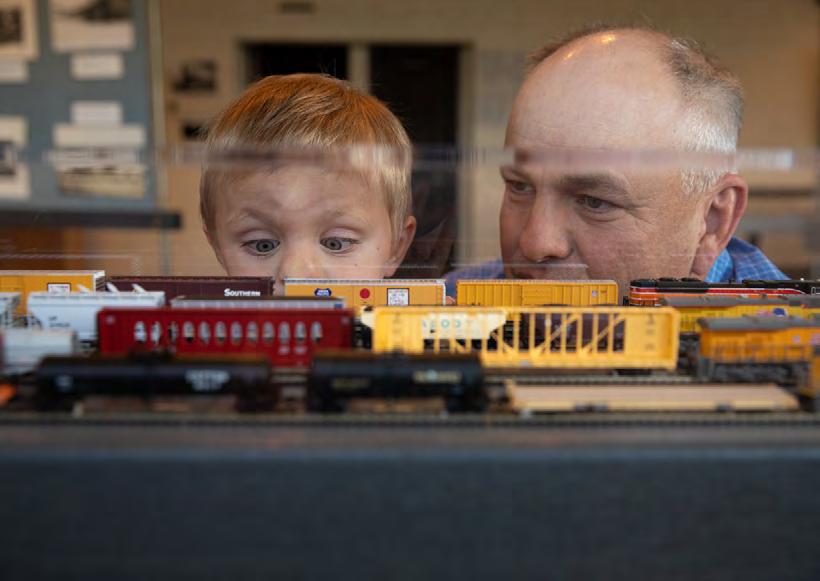
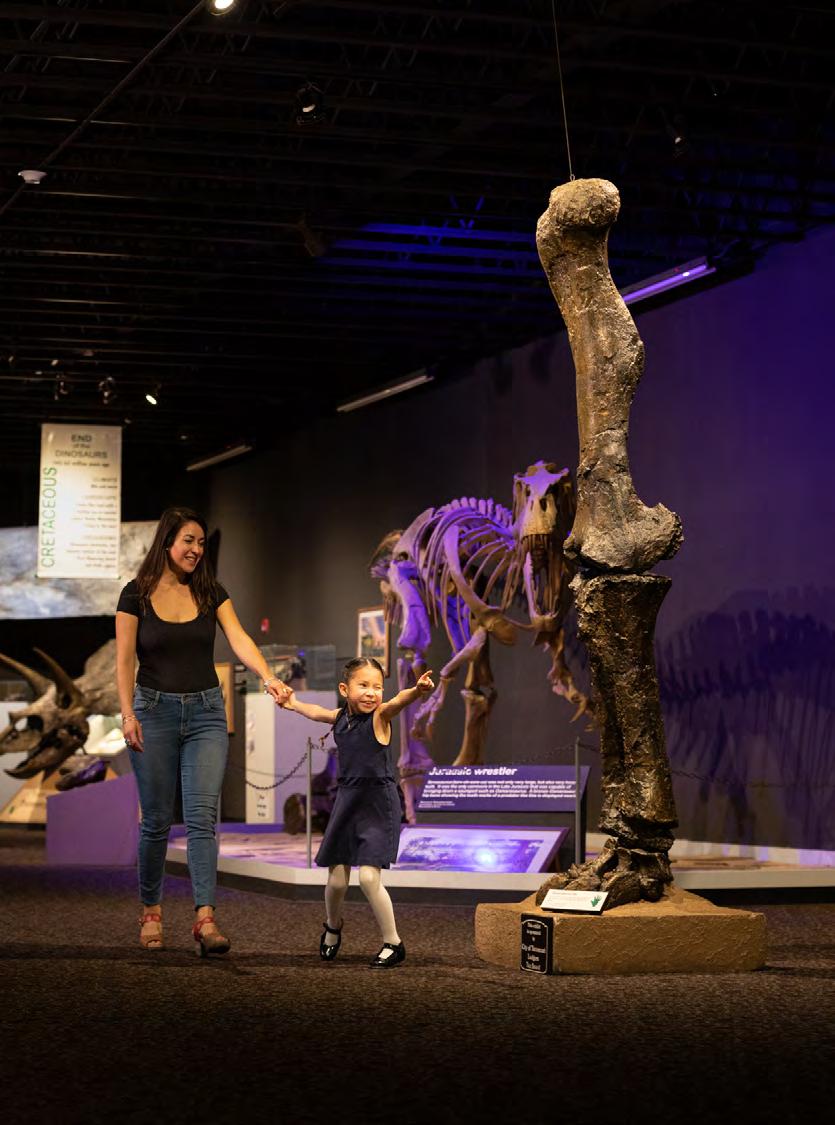


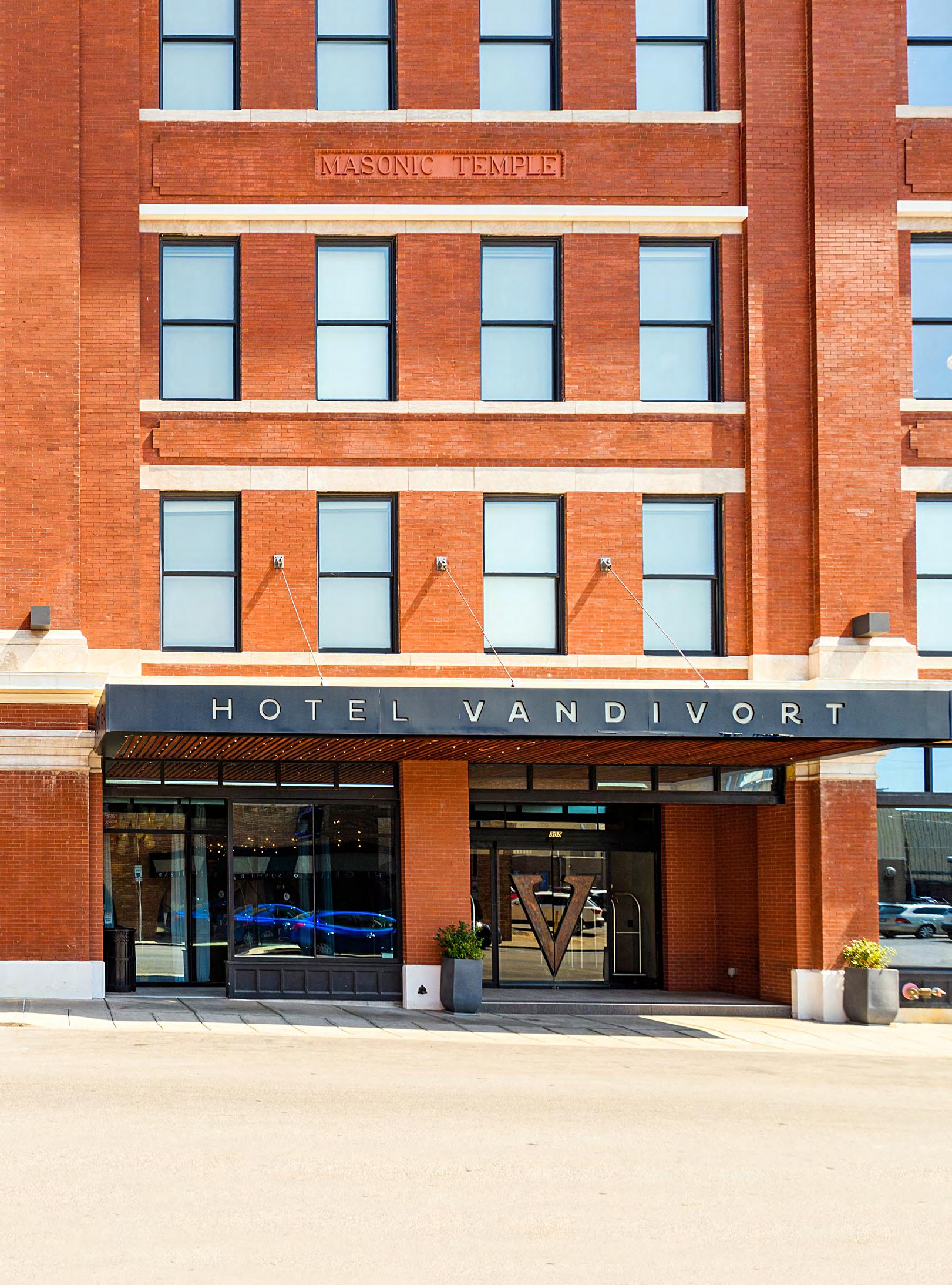 Photograph by David J. Schwartz - Pics On Route 66
Photograph by David J. Schwartz - Pics On Route 66
Heritage travelers run the gamut in tastes and preferences. Among those traveling Route 66, many opt for the mid-century mom-and-pop motel experience, especially since it perhaps best captures the hive mind’s memories of what the old road once was like. After all, the 1950s was a period of unprecedented economic growth, and large numbers of America’s families were hitting the road. Although chain motels were busy getting their start back then, roadside lodging was still dominated by independent properties, accounting for a wide range of amenities — or a lack thereof.
But Route 66’s origins date back another three decades or so from that mid-century point, and when the Mother Road and all the others were christened with their federal numbers in 1926, lodging was either in city center hotels or tourist camps, a highly bifurcated Rich v. Poor scenario. While the motel had its birth in 1925, it took many years for them to be commonplace along American highways. And while those aging motels are still popular — some prefer the vintage venue — others like modern twists on what was considered proper lodging. The Hotel Vandivort in Springfield, Missouri, is a perfect example of the latter.
Tucked neatly in the downtown district, only a couple of blocks off Route 66, Hotel Vandivort — named years ago for Springfield Little Theatre volunteer Francis Vandivort — occupies a decades-old historic building that wore many hats throughout its lifetime.
“The historic structure was originally built in 1906 as a Masonic Temple, [and] offered up 40,000 square feet of floor space with a spacious auditorium on the fourth floor,” said Hannah Dingman, Marketing Manager. “The center played host to local Masons for more than 75 years.”
And then, like many historic buildings, it underwent a transition. “The Vandivort went through a prolific renovation in the 1980s, with most of the space divided into offices. Unfortunately, the drop ceilings and drywall hid much of the building’s original charm,” Dingman continued. “During this time, it was placed on the Springfield Historic Sites Register and the National Register of Historic Places.” In recent years, the building had even served as home to the Springfield Contemporary Theatre. It’s had a lot of faces over the decades.
The building was reimagined again when brothers Billy and John McQueary, veterans of a century-old Springfield family business and of the tech world, shook their own world a bit in 2012 by buying the four-story red brick building. The brothers took the structure’s classic architectural ornamentation and methodically transformed the empty space into the selfproclaimed “first urban boutique hotel of Springfield.” After a $13.5-million conversion, Hotel Vandivort opened on July 13, 2015, initially offering 50 guest rooms. In 2019, the hotel increased its guest rooms by an additional 48 via an expansion, located directly across from Hotel Vandivort.
“The need for an upscale boutique hotel in the heart of downtown inspired the McQueary brothers to purchase the Vandivort building with its rich history and prime location,” said Dingman. “They began reclaiming the building’s history and original beauty, while creating a thriving and social hospitality venue.”
Because the hotel was fashioned from an existing building, rooms are not cookie-cutter like at many other newer properties. High ceilings and exposed brick from the original structure were intentionally incorporated into the design whenever possible to mix well with the sleek and well-
appointed contemporary decor. However, technologically up-to-date room amenities include in-ceiling speakers and the option of controlling audio and lighting via a guest’s mobile devices.
The first floor boasts The Order, a sophisticated restaurant that serves a modern take on Missouri cuisine. By incorporating the building’s key elements such as the brick wall and wood accents, while introducing contemporary touches such as the 92 luminescent glass bulbs atop the dining area’s tall ceiling — hand-blown specifically for the restaurant by local artisans — The Order presents a beautiful juxtaposition of old and new. Another historical piece of note is the stunning 2,800 square-foot Vandivort Ballroom located on the building’s top floor, which has been hosting events for more than 100 years.
Over at the V2 (the new addition) is the casual-attire Vantage Conservatory & Lounge, a rooftop bar featuring creative cocktails and other adult beverages. The elevated rooftop offers stunning views of the city’s skyline, and it is not impossible for patrons to catch a glimpse of where Route 66 passes through city center, or to spot the awesome History Museum on the Square sign. But it is the 70 seats in The Order, along with 80 more in the lobby, that the developers hope will entice locals to mingle with out-of-towners staying and dining there.
The Vandivort is a pleasant alternative from both midcentury motels and historic hotel renovations in that it is purely a 21st Century interpretation of how upscale lodging should be. The interior design features modern aesthetics to balance the history of the building, often relying on glass globes, greenery, and negative space to add ambience. The McQuearys’ efforts paid off handsomely in 2016 when they were awarded the Boutique Hotel of the Year award by the Boutique & Lifestyle Lodging Association.
Social media buzz has been a mainstay of Hotel Vandivort’s marketing efforts. The story goes that the designers installed just the right kind of lighting in the first-floor restrooms to make everyone look like a cover model, airbrushed and all. And in 2016, patrons were encouraged to post photos from the restrooms, using the hashtag #HotelVandivortBathroomSelfie. And post they did. Along the way, the Vandivort became the only hotel in Springfield to earn the Four Diamond rating from the American Automobile Association. This prestigious award places the hotel in the Top 5% of more than 28,000 properties in the U.S.
Springfield, Missouri, is famous for many things: it’s the birthplace of Route 66, where Cyrus Avery, John Woodruff, and others agreed on April 30, 1926, to the Route 66 moniker for the road that they had envisioned, it is the site of the historic Wild Bill Hickok-Tutt shootout that created a legend, and it is known lovingly as the Queen City of the Ozarks. The city has increasingly become a favorite Route 66 layover because of its history, numerous attractions, dining, vintage neon signs, breweries, and a number of previous alignments of the highway.
Today’s Route 66 travelers are arguably different from those from past decades, largely due to their higher level of cultural exposure and their discerning nature. They are keen to explore and experience, but they want to enjoy some creature comforts, too. And down in Springfield, the Birthplace of the Mother Road, Hotel Vandivort and venues like it are doing what Route 66 businesses have always done: rising up to meet the traveler and offering them exactly what they want.
A trip down the Mother Road through Pulaski County, MO, is a journey through time. These 33 miles of Historic Route 66 carve through the rolling Ozark hills that pioneers and pilgrims throughout history have called home. Witness both natural beauty and engineering marvels at the scenic overlooks of Devils Elbow. Catch a rare glimpse at the well-preserved, 19th-century structures around Downtown Waynesville. Pay tribute to the many men and women who passed through Fort Leonard Wood in service of our country at our patriotic memorials and museums. With so many sites to see, you won’t regret making this time-traveling excursion an overnighter.
Plan your trip at visitpulaskicounty.org/roadtrip.

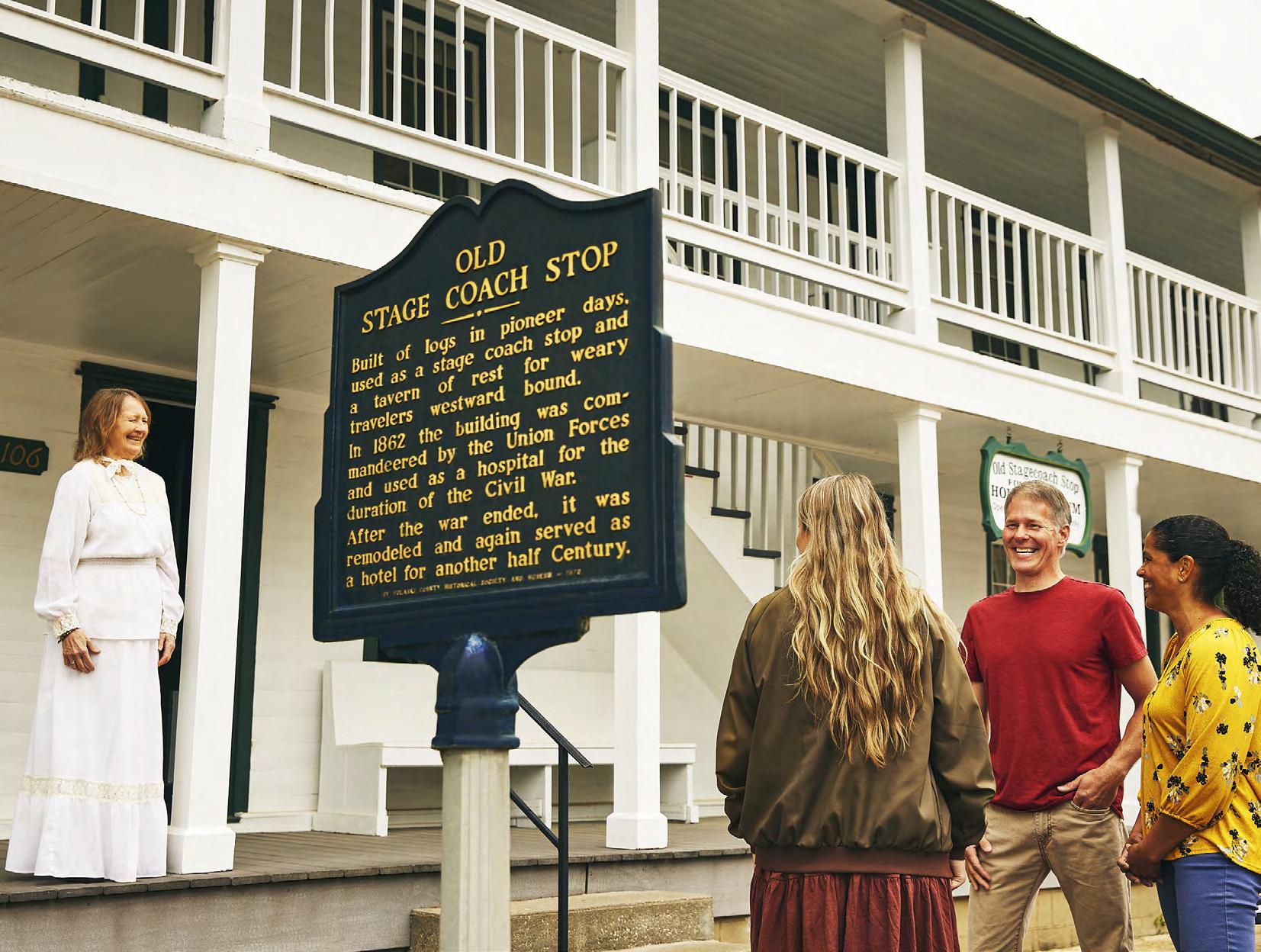
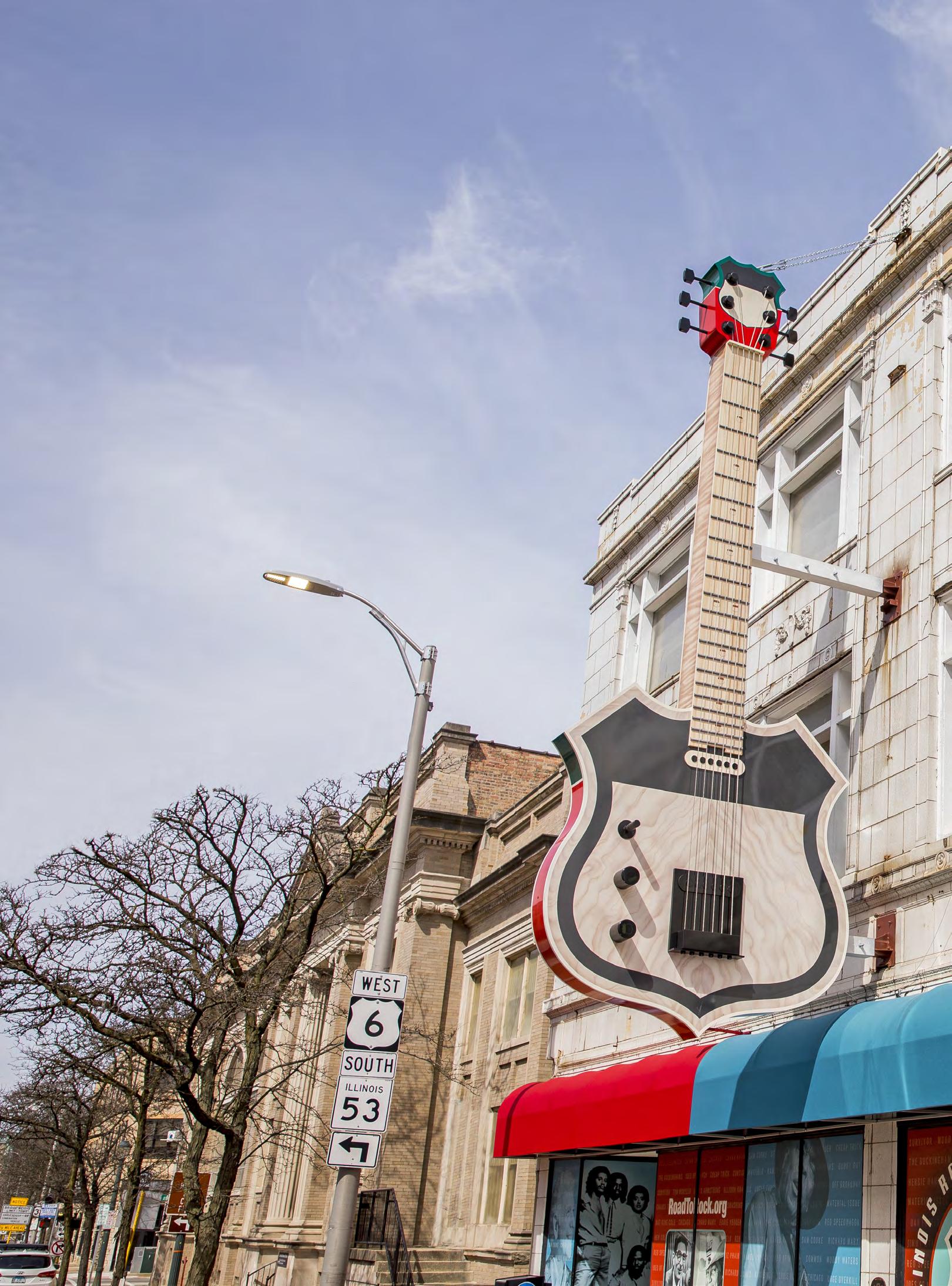 Photographs by Jim Luning
Photographs by Jim Luning

on Romero had a dream. His entire life had been filled with music. His grandmother, who was born in Mexico, instilled a love of music into the family dynamic with her playing the piano, classical guitar, and violin. Grandma Romero died at the ripe old age of 103, leaving behind a legacy for her children and grandchildren to follow. And they did just as their grandmother would have wanted. Romero embraced the art of creating and enjoying music, and a path was made.
“My father, Robert, picked up and played jazz. He taught himself how to play clarinet, flute, and other instruments. My brother played piano and guitar. My mom would perk up and say, ‘I played the radio,’” said Ron with a chuckle. She did not share the family’s musical abilities.
Robert Romero supplied his family with space and with instruments. At the family home a separate building was created that was specifically designed for performing everything from classical music to rock and roll. Nearly every instrument, including a radio, had a home in that special space.

Ron attended Joliet Junior College and earned certificates in fields such as Audio and Video Technical Specialist and Event Production Management. He was previously employed as Director of Events for Encore Productions at the Hyatt at McCormack Place, and in 2000, he became the owner of Stage Right Productions, a live event production company. And through him a new attraction along the Mother Road would eventually be born — the Illinois Rock & Roll Museum — and its journey has been anything but ordinary.
They say that behind every successful man is a strong woman. Ron was quick to recognize this truth when he met his wife, Patti, in 2009. She reached out and introduced herself to him. Being a quick thinker, he asked if he could put her on the band’s mailing list. There was no band and there was no mailing list, but the request got him the information that he needed to stay in contact with her. Before he had a chance to call her though, she called him. They married four years later and now have three daughters and three grandchildren.
As time went on, Ron developed a foothold in the music industry, one that was satisfying and profitable, but something was missing. He wanted to pass on his love and knowledge of music to other people. He wanted to do more than just take the records off the shelf and enjoy the beats. Performing was not enough. But he wasn’t sure how to make that dream a reality. So, in an effort to find some clarity, he traveled around the country, visiting music museums. He found some fulfillment and borrowed some useful ideas, but he still didn’t know exactly what he could do to share his enthusiasm for music in a unique and effective way. That was until he attended an exhibit in California and a spark was lit.
R“In 2013, Rick Nielsen’s Cheap Trick had an exhibit at the Berkeley Museum. While attending the exhibit, I was pushed over the edge of amazement because there were people from around the world who came to see that exhibit. I loved Cheap Trick; they were one of my favorite bands. But I wondered, what could I do if I opened my own museum and added other performers like REO [Speedwagon], Styx, Buddy Guy, and Muddy Waters? A light came on and I knew what I wanted to do. I would open my own museum.” He began looking for the place that would bring his dream to life.
Illinois has deep roots in the history of rock and roll, with a long list of iconic rockers hailing from the state. Folks like Sam Cooke, Muddy Waters, Earth, Wind and Fire, Miles Davis, and Cheap Trick, to name a few.
“The influence of Illinois rock and roll can be seen in these examples: The Rolling Stones got their name from a song by Muddy Waters called Rollin’ Stone ; The Rolling Stones also sang a song called (I Can’t Get No) Satisfaction , and Muddy Waters wrote a song called I Can’t Be Satisfied; and Led Zeppelin’s first album primarily used Willie Dixon songs,” exclaimed Ron.
The town of Joliet is the home of the country’s first Dairy Queen. But besides luscious dairy treats, Joliet, just 35 miles southwest of Chicago on coveted Route 66, is also the home of the Rialto Square Theatre. Opened in May 1926, the theatre has been nicknamed the “Jewel of Joliet.” It has played host to fashion shows, plays, and many amazing performers, including the Marx Brothers, Chuck Berry, Sam Cooke, Buddy Guy, and others. Joliet was not just a place musicians passed through while traveling on Route 66 to their next gig, it was THE gig. Anyone who was anyone in the entertainment world aimed for a show date at the Rialto in Joliet.
For Ron, the rich rock and roll history made the town the perfect location for his museum. “Joliet is the third largest city in Illinois and connects with Routes 80, 55, 66, and U.S.30 (Lincoln Highway). There is a new train station, and the city is undergoing a rejuvenation. I wanted the museum to be a part of that synergy. Joliet is fast becoming a ‘music city.’ Besides, you don’t have to fight the Chicago traffic problems in Joliet.”
With the decision made on where he would house his museum, Ron Romero now had to find the right brick and mortar that his museum could call home.
It was 1929 and Jackson Jarvis Cohen was in search of a larger space for his dry goods store. He found it at 9
West Cass Street in Joliet. A three-story, Beaux-Arts/ Sullivanesque-style commercial building caught his eye. The location was central to town merchants and, as a bonus, it was just down the street from the Rialto Square Theatre where theatergoers would pass by the store and gaze at the merchandise in his windows.
Cohen made his deal with the developer, Dr. J.J. Coady of Minooka, and leased the entire space for $10,000 annually. At the direction of Mr. Cohen, the building was painted white in correlation to the name of the store being the “White Store.” By 1937, the White Store had outgrown the space and moved to another location, but the building would continue to be known as the White Store.
The building changed hands several times, once to Goldblatt Brothers Department Store and then to The Silver Dollar Store. In 1977, the building once again changed hands making it the Buy-Rite Furniture Store with Jack’s Gym occupying the entire third floor. When Buy-Rite Furniture closed, the building was briefly considered a tear down, for a newer, more modern building, but that idea was short-lived.
When Ron discovered the store, he knew that he had found just the right building to become the museum’s home.
“I decided on the White Store because it was the right size, had the right space, and was in the right location. I could envision what the building could be with the right renovations. Besides, it is directly across the street from the Forge Theatre and a few blocks away from the Rialto Theatre,” said Ron. The White Store was exactly what he needed.
In 2019, with funds garnered from grants and donations, he was able to purchase the building under the Illinois Rock & Roll Museum on Route 66 organization.
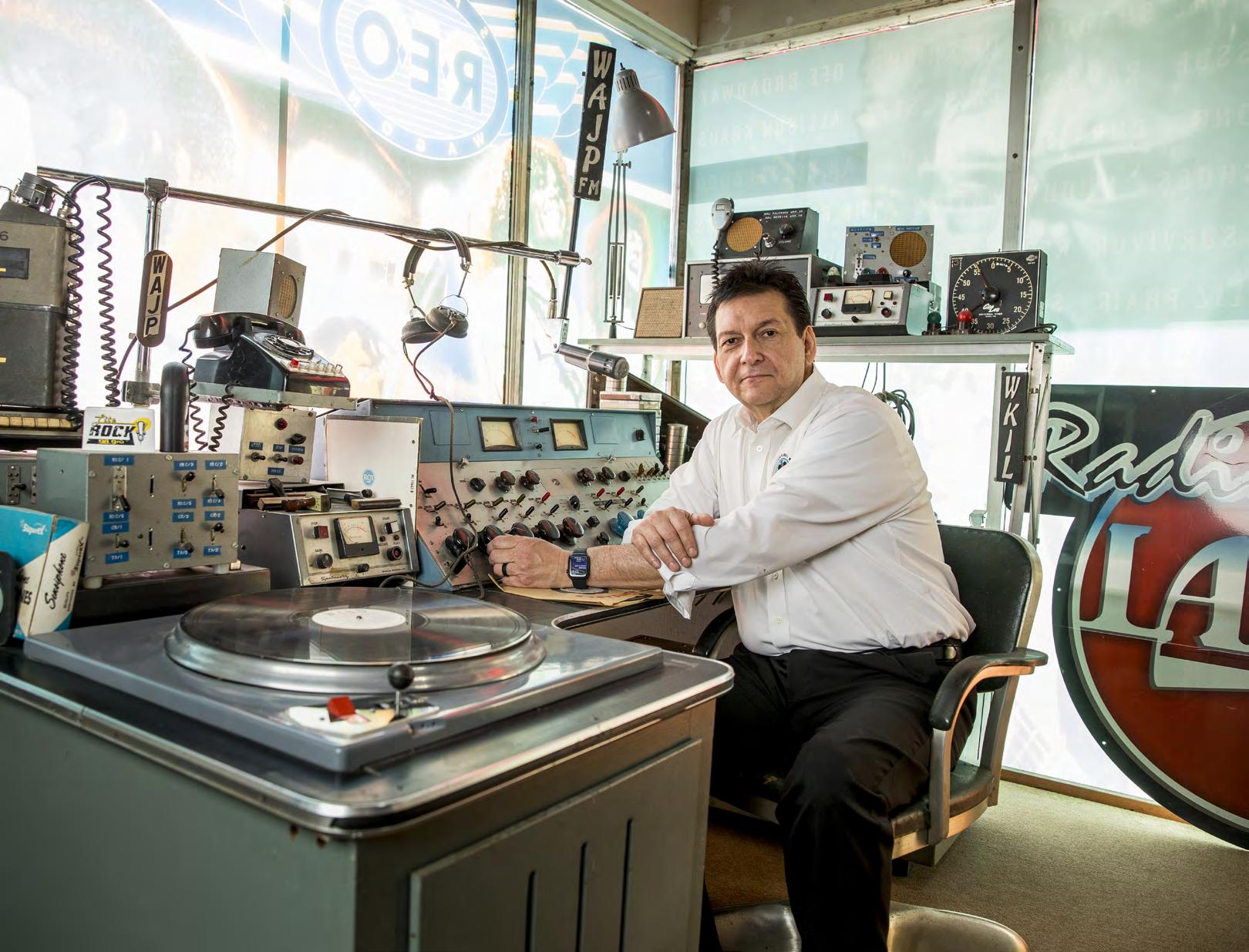
It would take three years to refurbish and renovate the multi-level building, and the process is still ongoing. Besides the necessity of bringing it up to code, the space had to be reconfigured to meet the museum’s needs.
The first level of the museum focuses on the educational aspects of music. Students can take classes in a variety of musical instruments, but what makes the program unique is its offering of classes on music as a business. Students learn how to make money making music.
“Not everyone is going to be a recording star. Other people are going to be a part of services, like a sound engineer, light engineer, business manager, tour manager, and we want to be able to show these opportunities to the students.”
The museum also works with two local colleges that offer music programs. Students of all ages and backgrounds can get their feet wet in all aspects of the music industry through the museum. There is also a program that works with economically challenged students by helping them obtain instruments through donations from the public.
The second level is an exhibit space that begins with Blues, Jazz, and Gospel music and evolves into what we now call Rock and Roll.
The majority of the third level is exhibit and Hall of Fame space, but there is also event space.
There are two radio stations, one showcasing the 19601970s era which is for display only, and the other is a working station that is visible from both the street and inside the building. Also, on that level is a small concert area for student performances.
While the museum is not ‘officially open’, on September 2, 2021, it celebrated its inaugural inductees into the Hall of Fame. Performers included Buddy Guy, Chicago, Cheap Trick, REO Speedwagon, Muddy Waters, The Buckinghams, The Ides of March, and DJs Dick Biondi and Larry Lujack. The second Hall of Fame inauguration happened on June 5th, 2022. While the museum was still not officially opened, the inductees included Styx, Chuck Berry, Sam Cooke, Dan Fogelberg, New Colony Six, Dennis DeYoung, and Jim Peterik. John Records Landecker was inducted into the DJ category.
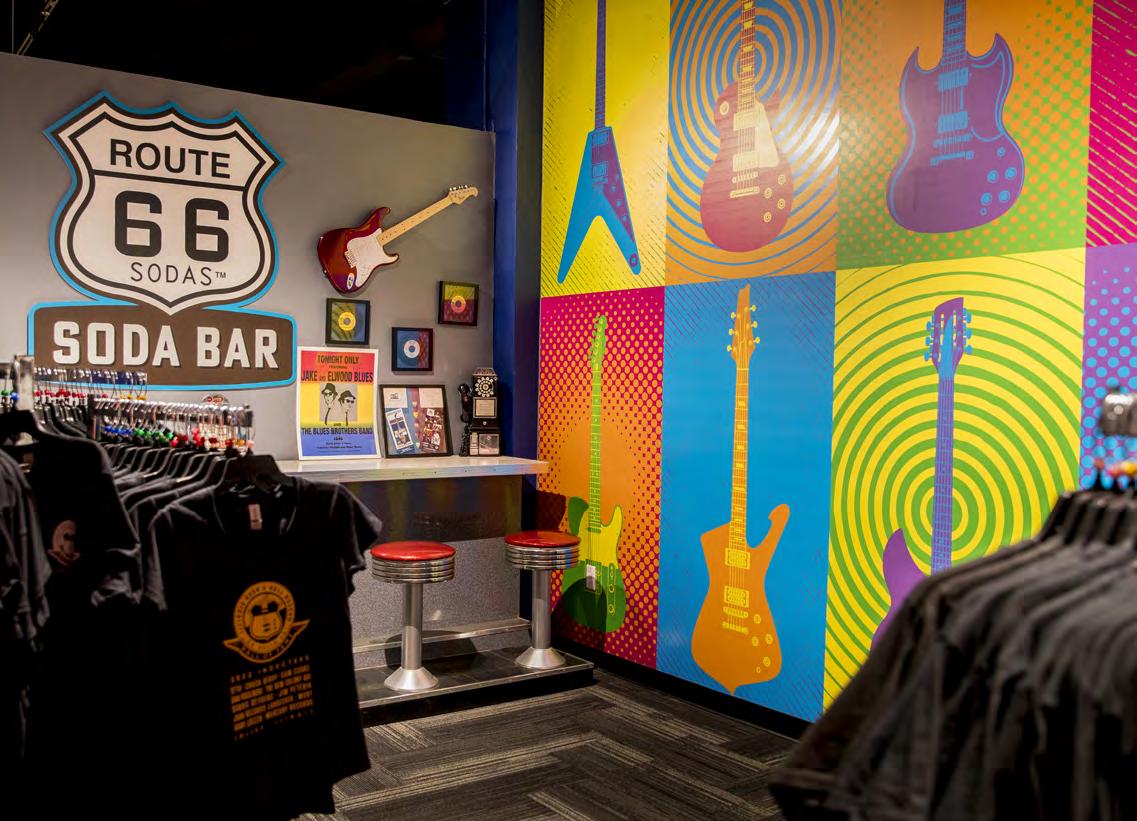
“We do all sorts of events,” said Ron, “from concerts, car shows, Hall of Fame induction ceremonies. They are all fundraisers for us. We are not officially open, but we are very active in the completed spaces that we have available.”
Yet, with all that he has going on in his historical structure, the big white building still needed something unique to set it apart. Shannon MacDonald, known as the World’s Best Beatles Artist , was commissioned to create a 24-foot-tall guitar sculpture to be mounted on the outside front of the building. With assistance from the Heritage Corridor Convention and Visitors Bureau, the museum was able to secure a grant from the Illinois Department of Commerce and Economic Opportunity. Together with help from other sponsors, the impressive ornamentation designating that you have arrived at Illinois Rock & Roll Museum on Route 66 became a reality. MacDonald named the guitar “Gigantar.”
On January 14, 2023, Gigantar was loaded onto a Legacy Express Trucking flatbed trailer in Freehold, New Jersey, and began the 800+ mile trek to 9 W Cass Street in Joliet, Illinois. The event was commemorated with a celebrity launch party at The Stone Pony in Asbury Park, New Jersey. Upon entering the state of Illinois, many stops were made to allow photo opportunities for fans and supporters who were lined up along the route and hoping to catch a glimpse of Gigantar.
On January 20, 2023, nearly 500 people attended a celebratory lighting ceremony as Gigantar, the largest guitar structure in the world, got mounted onto the front of the vintage building on Route 66. Rick Nielsen from Cheap Trick flipped the switch illuminating the giant structure.
Ron Romero continues to perform. His father and grandmother’s musical influence is still in him. “I am a lifelong musician and still play in bands. I perform in the Illinois Rock & Roll Museum Band and have played with some of the inductees into our Hall of Fame.”
With the missing piece to Ron’s career satisfaction now in place, the real work begins. He is the Executive Director and the museum’s Chairman of the Board. It is his full-time job now.
The establishment of the museum is just one more stop in the never-ending entertainment on Route 66. Where else but Route 66 will you find Arcadia: America’s Playable Arcade Museum, the World’s Largest Laundromat, the Pink Elephant Antique Mall, or Henry’s Rabbit Ranch? For a road that has ceased to exist as a United States highway since 1985, the Mother Road is still a hugely beloved route for those who enjoy stepping out of their interstate highway comfort box. Just like the song goes, “Get Your Kicks On Route 66 ,” new kicks are popping up every day, and with all the old and brand new attractions and businesses to be discovered and enjoyed, there are lots of “kicks” still to be had.
On Museum Square in Downtown Bloomington, the Cruisin’ with Lincoln on 66 Visitors Center is located on the ground floor of the nationally accredited McLean County Museum of History.
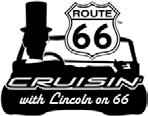
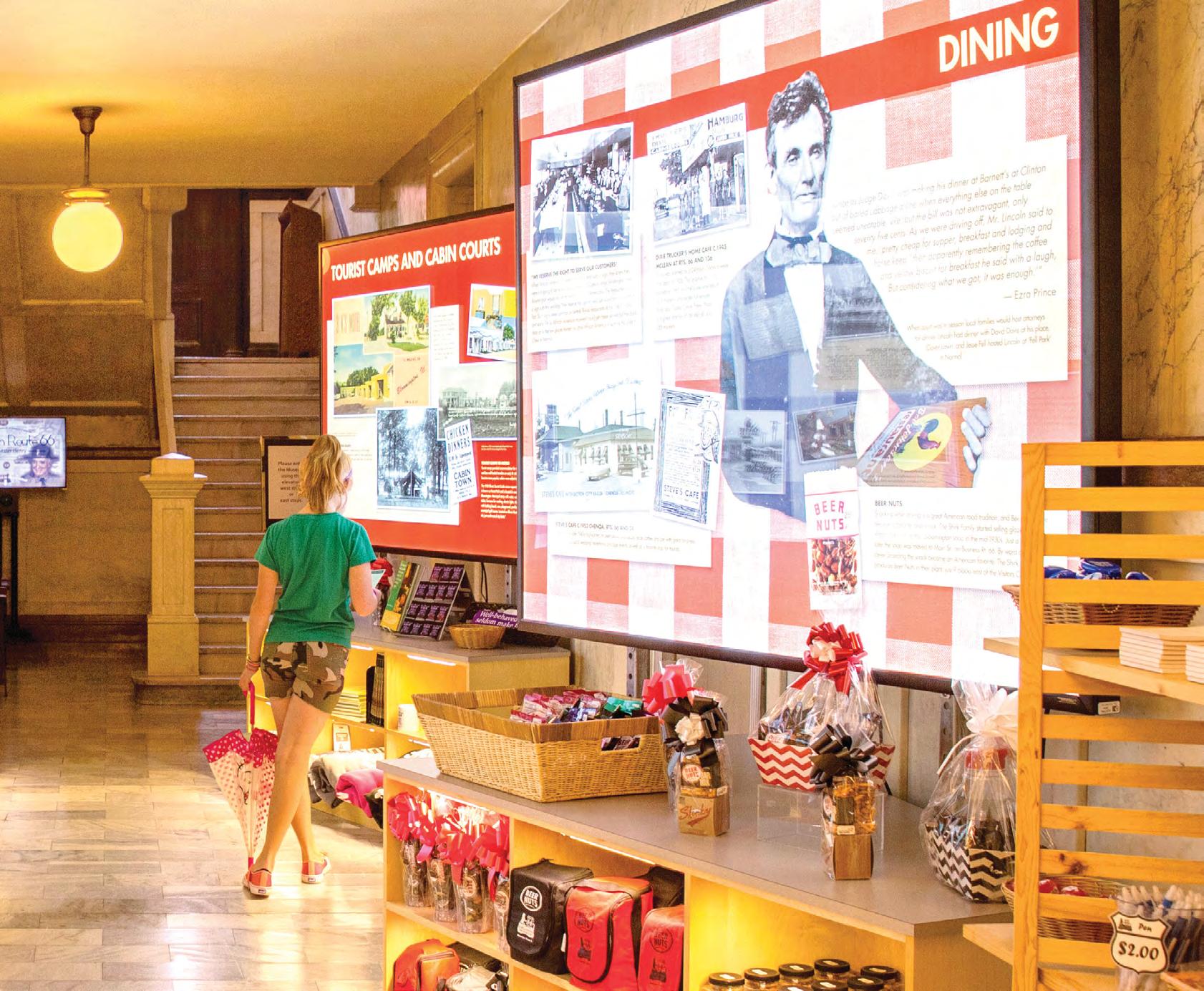
The Visitors Center is a Route 66 gateway. Discover Route 66 history through an interpretive exhibit, and shop for unique local gift items, maps, and publications. A travel kiosk allows visitors to explore all the things to see and do in the area as well as plan their next stop on Route 66.
CRUISIN’ WITH LINCOLN ON 66 VISITORS CENTER
Open Monday–Saturday 9 a.m.–5 p.m. Free Admission on Tuesdays until 8 p.m. 200 N. Main Street, Bloomington, IL 61701 309.827.0428 / CruisinwithLincolnon66.org
*10% o gift purchases


At the corner of Central Avenue and Fifth Street in Downtown Albuquerque, New Mexico, the KiMo Theatre has screened motion pictures and hosted live performances since its opening on September 19, 1927, earning its place among the extravagant, palatial movie theaters of the 1920s. But to tell the whole story, one must start from the beginning.
In 1885, ItalianAmerican entrepreneur Oreste Bachechi began his career with a modest business in a tent near the railroad tracks in Albuquerque. Over time, as the city expanded, so did his portfolio of odd jobs, which included peddling alcohol, owning a grocery store, and, in partnership with Joe Barnett, running the Pastime Theatre — but that wasn’t enough. Bachechi dreamed of his own film house to join the pinnacle of movie magic and, in 1925, decided to get to work on building a venue that would stand out from others of its kind.
Soon, Bachechi enlisted Carl Boller of Kansas City-based Boller Brothers, a firm that specialized in theater design in the Midwestern United States, to bring his vision to life. Boller, along with Carl Von Hassler, one of the region’s most popular painters, embarked on a tour of New Mexico, exploring the Pueblos of Acoma and Isleta, as well as the Navajo Nation, to draw inspiration in designing a relic that honored tradition while infusing bits of 1920s Art Deco America. Following months of research, Boller presented Bachechi with a watercolor rendering that met his approval — a pioneering amalgamation of American Indian and Art Deco, dubbed “Pueblo Deco,” and each aspect of the resulting three-story brick-stucco building, both inside and out, was chosen with significance, even its name, which means “king of its kind” in the language of the nearby Isleta Pueblo.
The interior design featured plaster ceiling beams textured to resemble logs and adorned with culturally specific imagery. Air vents were cleverly disguised as Navajo rugs, while chandeliers were shaped like war drums and Native American funeral canoes. A wrought-iron bird motif descended the stairs, along with rows of buffalo skulls adorned with garlands and eerie, glowing amber eyes. Of particular note was the use of the swastika, a cultural symbol of life, freedom and happiness, which has remained unaltered, despite its nownegative — and ironic — connotations.
pLike its symbols, color also played an important role in the design. The space is splashed with warm hues of orange, yellow, white, and red in a blend of both regional heritage and the opulent, Old Hollywood aesthetic of the 1920s.
The theater, which cost $150,000, was completed in less than a year, with an extra $18,000 for the Wurlitzer pipe organ to accompany the silent films. Dr. Shelle Sanchez, Director of the Department of Arts & Culture for the City of Albuquerque, who has been dedicated to KiMo in her current position since 2018, said the design is like nothing she’s seen before.
“It’s magical and a little surprising for its mix of imagery and materials,” Sanchez said. “You can spend the ten minutes waiting for a show to start just looking at the architecture and the murals painted into the space.”
Oreste Bachechi died just one year after the theater opened its doors, leaving its management to his sons, but the theater continued to be beloved by visitors until the early 1960s when a massive fire nearly consumed the building. Neglect set in, accelerated by the exodus from downtown, experienced by many cities during that time period, as the public focused their gaze on “newer” attractions, like the various malls and entertainment centers popping up on the outskirts of the city, so different from the grandiose picture palaces enjoyed for forty years prior.
Slated for destruction, KiMo was saved in 1977 when a group of city activists, historians and residents voted to purchase and restore it, and today, it remains a registered historic site and continues to operate as a popular attraction for entertainment seekers both near and far, collecting tickets from roughly 78,000 each year.
“It’s a popular place, and it’s photographed every day by people who pass [by],” Sanchez said. “Regardless of whether or not people travel specifically to see it, its eye-catching façade and big marquee captures the attention of everyone who passes, and I can only hope that the KiMo will remain a place of magic in the community for another hundred years.”
So, if you find yourself in the audience waiting for the curtain to open, take a moment to appreciate the legacy of the KiMo Theatre—a funky little landmark just as iconic as the road it calls home.
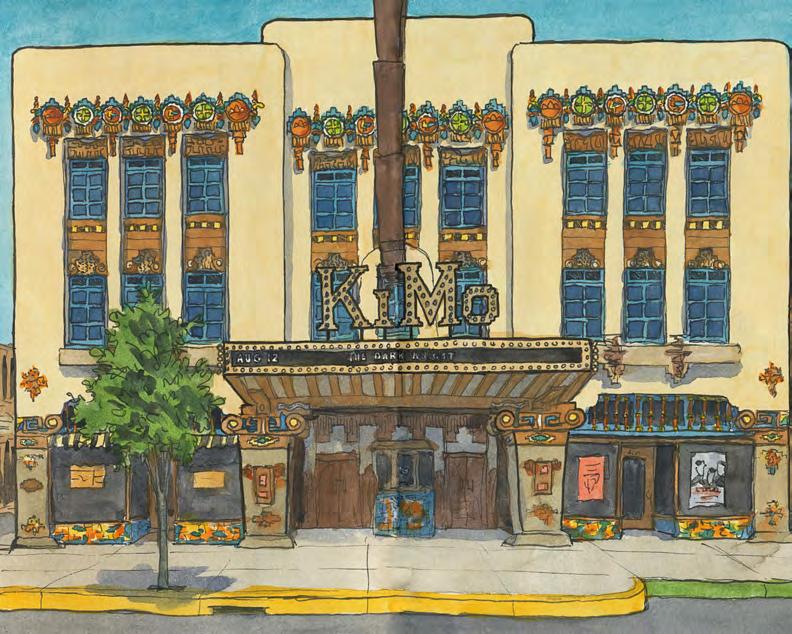










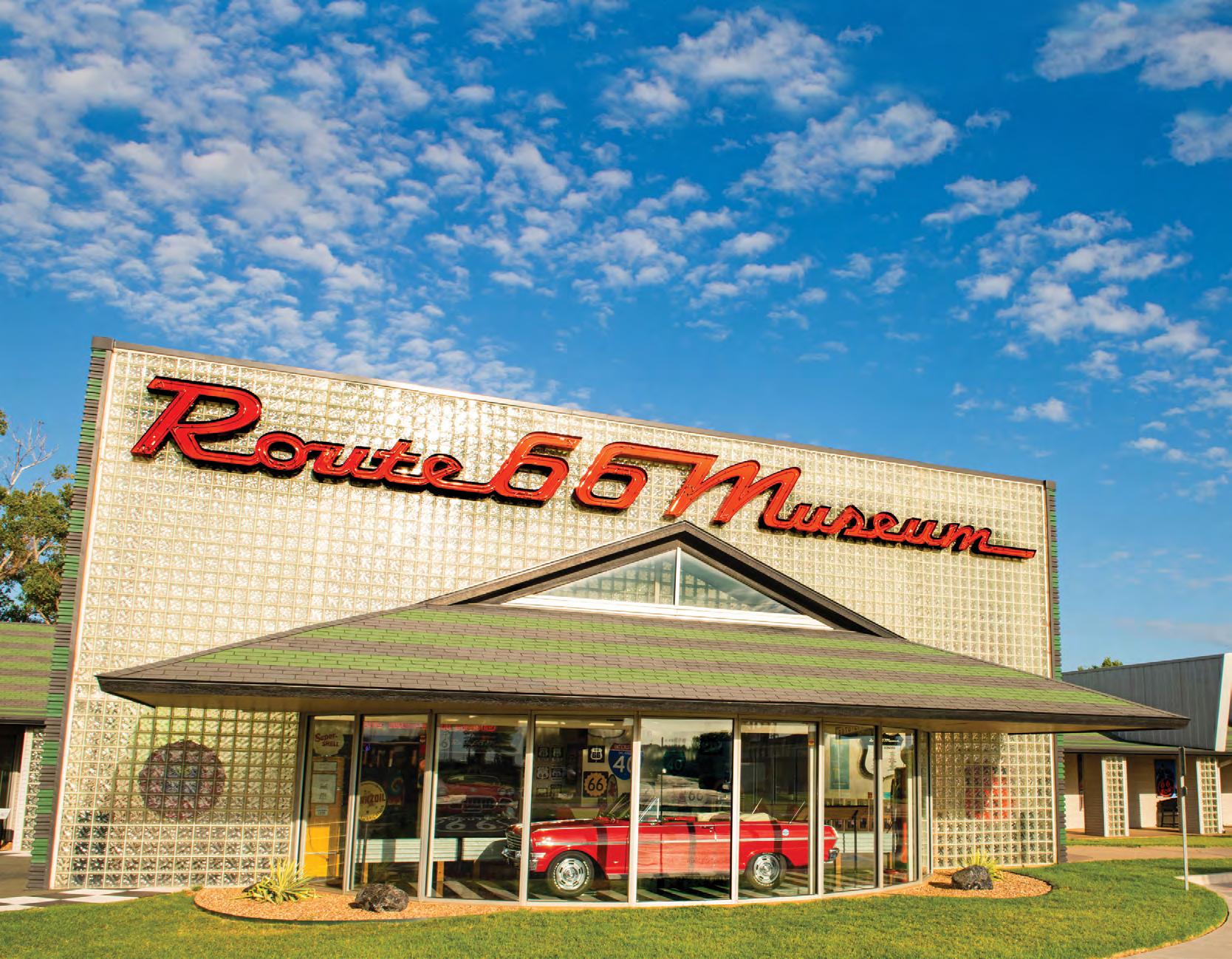
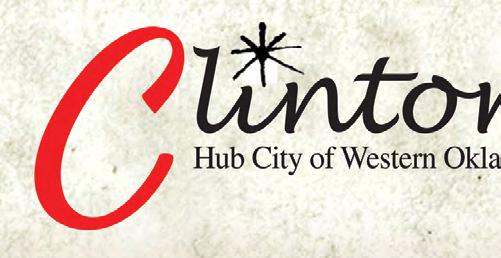

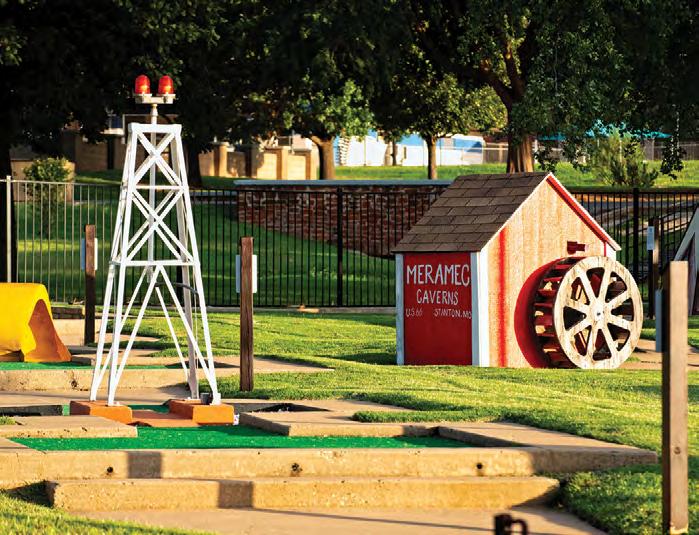




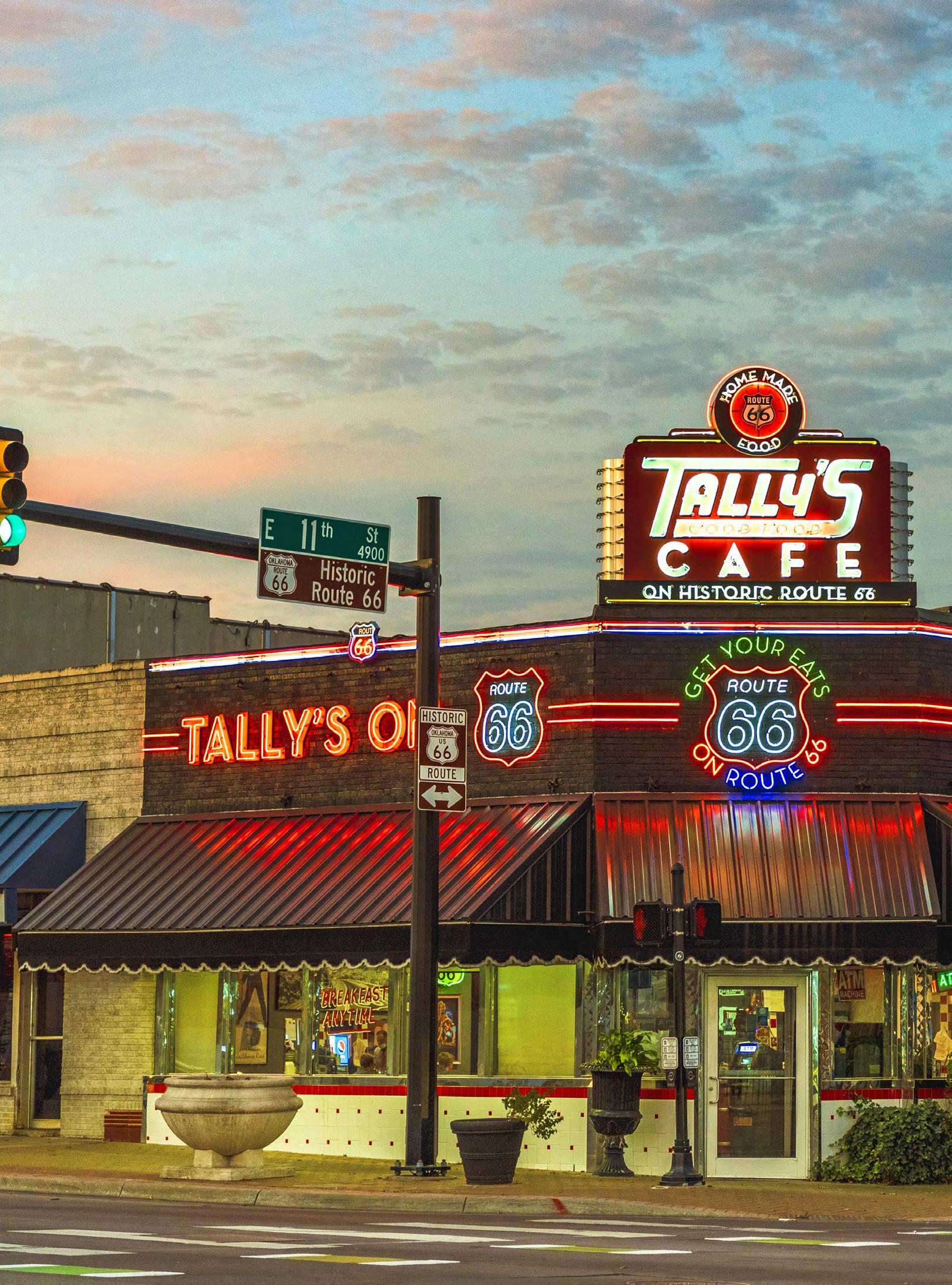
 By Ellen Proctor
Photographs by Efren Lopez/Route66Images
By Ellen Proctor
Photographs by Efren Lopez/Route66Images
Just say the name of this state in a crowded room and chances are that someone will break into song. “Oklahoma! Where the wind comes sweepin’ down the plain.” Route 66 sweeps across the Sooner State in the longest stretch of original roadway that is still drivable today. Truly America’s Main Street, Oklahoma’s section of the Mother Road is home to a plethora of charming roadside diners and eateries. But there is one diner, located at the intersection of 11th Street (Route 66) and Yale Avenue in Tulsa, Oklahoma, that is not only an iconic realization of the American Dream, but has been a successful part of the Tulsa restaurant scene for 36 years, Tally’s Good Food Cafe.
The year was 1987, and Mark & Mary’s, a local restaurant chain in Tulsa, was closing one of their locations. The eatery, opened just four years prior, had been put up for sale and it needed a lot of work, but the Route 66 location made it an ideal spot.

“I jumped on it,” said Tally Alame. “It was really just one room with a small kitchen.”
As with many locations along America’s most famous highway, background information on the building itself is scarce, but it is believed that the location was once a grocery store. The old terrazzo floor is still intact.
The thirteenth of November fell on a Friday in 1987, but there was nothing unlucky about it for Alame. That was the day that he first opened the doors of his new restaurant. “I’m just going to open — I’m not going to believe in superstitious stuff,” Alame remembered. “It was Mark & Mary’s Good Food Diner, and I kept the name for two months.” He thought that keeping the old name would help him keep the old, already established customers. But he soon found out that wasn’t the case. It appeared that the name carried with it a not so positive reputation associated with uncleanliness among other things. But Alame was not one to stay idle for long. He decided on a new name. “I changed to Tally’s Good Food Cafe, and that changed the whole ballgame.”
One of the first things that he did after opening for business was to give food away. Yes, he decided that it would be a good practice to help his new community. The fourth Thursday in November is Thanksgiving, and though he hadn’t been open for a full two weeks, he made the local papers as one of five Tulsa restaurants giving away a free dinner. Tally’s not only provided a meal, but also offered free delivery to people who were described as “shut-ins,” or invalids, people who weren’t able to eat in the restaurant. And he has continued the tradition for 36 years.
“Thanksgiving is my favorite day of the year, because it’s about being thankful and about sharing with others. Everyone is welcome, and it’s all free,” Alame shared. “I open the doors and feed more than 1200 people.”
Alame’s journey to becoming a successful restaurateur wasn’t an easy one. He is one of ten children — five boys and five girls. In 1979, they were living in the city of Beirut, in Lebanon. A civil war was raging, and it was impossible to get a good education there at the time. So, when Alame was 19, his family sent him to Tulsa.
One of Alame’s brothers was already living in the area, having come to the U.S. two years before, and he also had cousins in town who owned Jamil’s Steakhouse. Originally opened in 1945, the steakhouse is considered the oldest Lebanese Steakhouse in Tulsa. The Lebanese community in Oklahoma has deep roots. Even before the region attained statehood, Oklahoma historians note that early Middle Eastern immigrants who settled in Oklahoma came mainly from Jediedat Marjeoun (Judaidet Marjayoun), a small town in southeastern Lebanon. One early immigrant’s success story would inspire more to follow in his footsteps, and soon entire extended families would be a part of the growing and vibrant Lebanese-American community of Tulsa and across the region. In fact, the character of peddler Ali Hakim in the Rodgers and Hammerstein musical Oklahoma is based on one of these early Middle Eastern settlers.
Alame settled right into his new life in Tulsa, first attending the University of Tulsa English Institute where he learned English as a third language, his native language and French being the first two. He later enrolled at Oklahoma State University in Stillwater to pursue a major in business management and marketing. Alame had a natural love of cooking that had been nurtured at home, so while he studied, he also worked at his cousin’s restaurant during the weekends, getting his first taste of the local hospitality industry.
“My lovely mother is the best cook ever,” Alame said. “She would cook everything in a big pot. She would ask me to help her in the kitchen. She’d ask me to cut cilantro, to dice garlic. She was a great example.”
After graduating from college, Alame worked at various restaurants in Oklahoma and Texas developing his dream
of one day owning his own business. “I learned concepts and ideals, learned a lot about hospitality — good service, making eye contact. Good food, good atmosphere. If you cook it, they’ll come to you.” At the age of 26, everything fell into place when he noticed that a certain property on 1102 South Yale Avenue was for sale.
Alame developed a set of basic principles by which he runs his business and posts them proudly on his restaurant’s website: treat every person who enters the diner just as you would like to be treated; serve plenty of good wholesome food at a reasonable price; and never use anything but the highest quality of food available. He makes his own batter, serving up homemade onion rings, dinner rolls, pancakes, and cinnamon rolls. While he does have some traditional Lebanese food — cabbage rolls on special, homemade chicken kabobs — he quickly learned that in the late 1980s, his clientele didn’t want food such as hummus or tabbouleh. The menu is mainly authentic diner food, with a full breakfast menu available all day and a wide variety of entrees served in a classic old-style diner atmosphere.
By 1990, just three years after he opened his doors, business was brisk enough that he needed more seating.
One of his business neighbors on the block was a beautician who was getting ready to retire. Alame offered her $5000 and he took over the space, knocked out a wall, and opened a second dining room in the building. When another shop owner in the building was also retiring, Alame acquired his space as well, which he converted into a full bar and banquet room that seats 50 people.
Stepping into Tally’s is a time warp back to the happy days of the 1950s. Red vinyl booths and counter stools glow beneath a ruby red neon stripe that runs along the perimeter of the ceiling. “Everyone knows I am a neon fanatic,” Alame offered. And his love for neon shines through both indoors and outdoors. A neon border surrounds the bar and banquet room as well, but in bright pink. “These days you cannot find the ruby red glass. Most neon is clear glass with the colored gas inside, but this glass is stained red. If one piece breaks, it can’t be replaced.”
Tally’s brings the spirit of the roadside American diner to life in a real and authentic way. The walls are decorated

with 1950s memorabilia, the iconic Route 66 shield emblem, brilliantly lit neon accents and pictures of 1950s and 1960s celebrities, including Elvis Presley and Marilyn Monroe. There is even a stained-glass clock gracing the walls.

“I bought the clock while on vacation in Vegas,” said Alame. “It says, ‘Get Your Eats On Route 66,’ every letter a different color, and it was hanging on the wall of a gift shop in the hotel. The man told me he didn’t have a box for it. It was $3,500, but since there was no box, he took $500 off and shipped it back to Tulsa.” It has kept time, running constantly, for 20 years.
Out front, the eye-catching neon above the diner’s glowing red awning has undergone changes over the years. When Alame first opened, there was no neon at all. But once again, he had a vision. “The diner was not complete without neon.” He added a red neon border and a new awning when he changed the business name to Tally’s.
In 2007, Alame added chrome siding to the exterior of the building, evoking even more of the classic diner aesthetic. But he wasn’t finished with his improvements. He had a design made for a new neon sign in 2014, but the design sat on the shelf for five years. When the Tulsa Route 66 Commission initiated a project in 2019 for businesses along the route by which they could receive assistance in funding restorations for existing neon signs or adding new ones, Alame applied right away. Tulsa’s Route 66 Neon Sign Restoration grant program awarded him $10,000 — the maximum grant amount — toward the total required to complete the project.
He took the design to a neon company and paid them $36,000 to manufacture the new sign. The grant money thankfully covered a little over 25% of the cost.
On October 21, 2019, the completed design lit up the front of the diner for the first time. He has kept the outdoor neon lit 24/7 ever since — until the end of April 2023 that is. “I kept calling a repairman week after week with a problem. Some letters kept going out. Then he asked me, ‘Why do you keep it on all the time when you can’t really see it during the
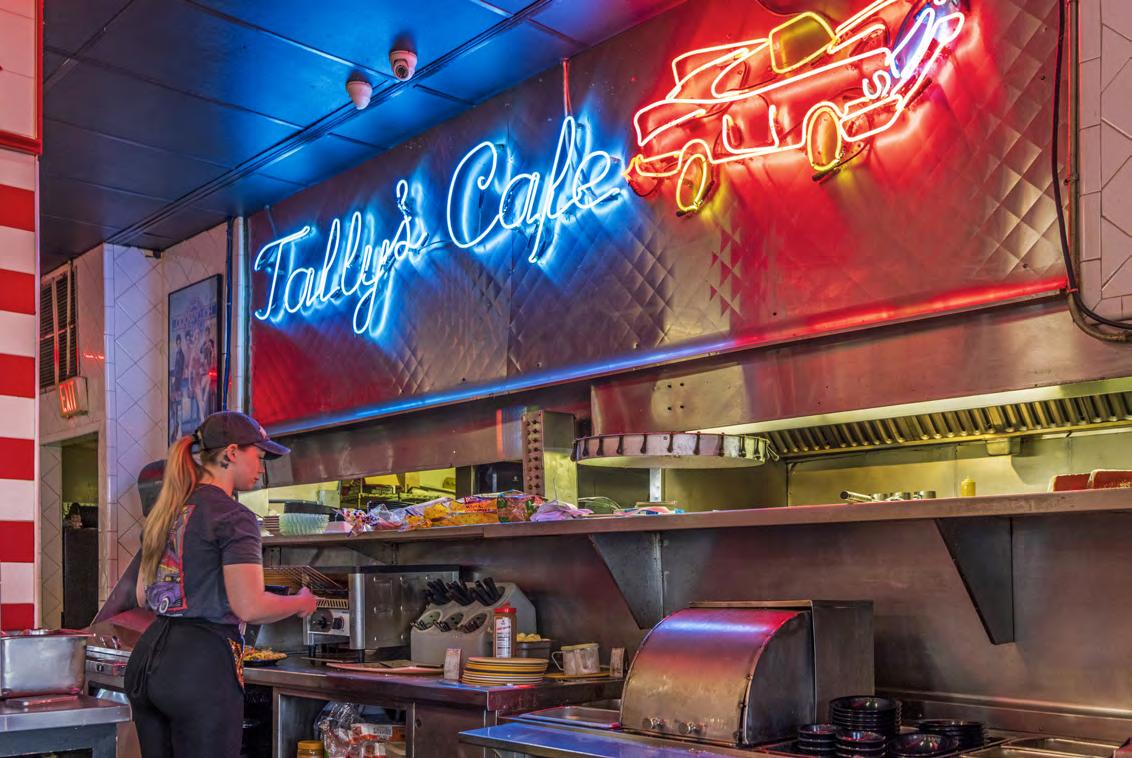
day?’ So, he set it up for me. Now it’s on a timer.”
The updated signage improves on the original by adding even more eyecatching color. The glowing blue neon of “Tally’s Good Food Cafe on Historic Route 66,” with the words “Good Food” glowing in red, and the shield with “Get Your Eats” in green and “On Route 66” in blue and white, against the backdrop of a dark Oklahoma night, is a sight to behold.
“I took the old, little bitty sign and moved it to the back parking lot,” mused Alame.
Alame’s son, James, took the helm of a second location across town at 61st Street on the south side of Tulsa in 2017. But after a few years James took his own leap of faith and moved onward to his own new venture, a bar and grill downtown, called The GOAT, leaving his father to run both diner locations. “He’s lucky to have my silver spoon in his mouth,” Alame said. “He’s following his dream, just like his father.”


Alame’s daughter grew up and moved away to Dallas where she works as a real estate lawyer. His wife isn’t involved in the restaurant. “Her hands are shaky, and I tease her,” Alame laughed. “When she would try to carry a cup of coffee across the room, she would tell me not to fill it too full or some would spill.” She stays home and runs the household.
Alame hasn’t taken a day off in seven years, and he likes it that way. As for his plans for the future, Alame is done with expansion. “I don’t think I’m going to stop working, though. I’m going to be running Tally’s until something happens to me.”
Each day he rises and heads off to his two locations, enthused and eager to showcase his food and vision and welcome patrons. But as can be expected, the original café on Route 66 holds a special place in his heart. “This one feels like home. I came here when I was 26, and now I’m almost 63. I’ve spent years walking these terrazzo floors.”
In recent years there has been a resurgence in Tulsa, with many of the city’s districts investing in reinvigorating their history and charm. Luckily, most of them have a lot to work with. As a key part of the town’s growth, the food culture has been a major driving force in bringing people in and getting them out on the town. Tulsa has also latched tightly on to its Route 66 history and ensured that iconic destinations and attractions are preserved and protected. And right in the middle of it all, Tally’s has been a beacon for locals and visitors alike — literally with its fantastic neon — reminding patrons of the good food, good vibes, and welcoming nature that has always been quintessentially Oklahoman.




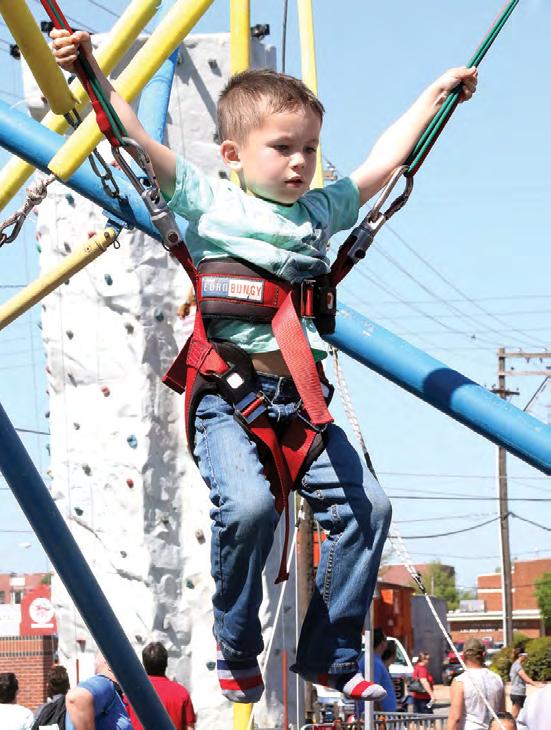


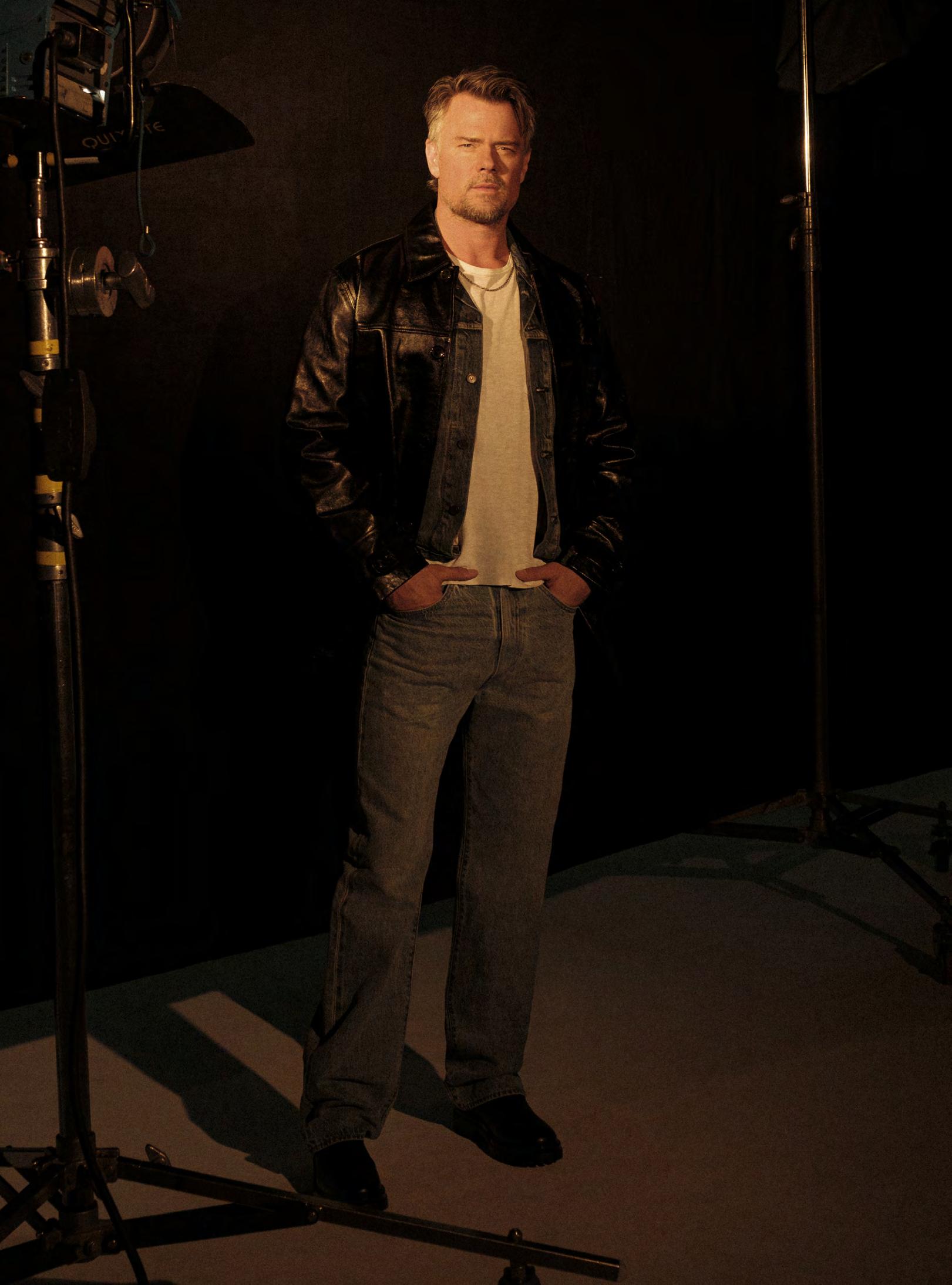
Ask someone to locate the city of Minot, North Dakota, on the map and you may have some time to kill as they labor to find it. However, it is home to the annual Norsk Høstfest — the nation’s largest tribute to the country’s Scandinavian heritage — the Scandinavian Heritage Park, the Dakota Territory Air Museum, and the Old Soo Depot Transportation Museum. The humble city can also boast of being the birthplace of some celebrated talent. But perhaps its most famous son is veteran actor Josh Duhamel.
Born on November 14, 1972, the 6’3” actor initially pursued a dream of becoming a dentist, but with natural charisma and bigger dreams, he wanted something more. He soon found his way into the New York and California entertainment industry and landed himself some highly respected roles in shows like All My Children and Las Vegas before landing the role of a lifetime in 2007’s Transformers and 2013’s Nicholas Sparks film, Safe Haven . But that was just the start.
With more than two decades in the industry, and his star continuing to rise, Duhamel has not forgotten his small town roots and is the kind of celebrity that you’d love to hang out with. Newly into his second marriage, a proud father of a soon-to-be 10-year-old son (from his ex-wife Fergie), his own production company, Dakota Kid Productions, creating the projects that he believes in, and a bunch of new projects in the works, he is at the top of his game.
You grew up in Minot, North Dakota. I reckon that few people are very familiar with the town, let alone the state. What was it like growing up there?
Well, I didn’t know any differently, so for me it was great. I still have a really strong connection to it. I’ve made such great friends that to this day are still my best friends. I have a group of about 20 guys… everyday we’re on a text, talking, sending photos, just in some way or another, we’re all talking. But you know, my parents, the people, just the simplicity of it all, I think is something that I’m really drawn back to more and more as I get older. As a young man, I wanted to get the hell out of there and go and see the world. And I have. I’ve been all over the world, but now, I look most forward to going back home. I feel like for me, it’s peace. My blood pressure drops about 25% every time I go back. That’s North Dakota and it’s also Minnesota. I have a cabin out in Minnesota that I spend a lot of time at. But again, it’s about just keeping it simple these days.
You wanted to be a dentist, but ended up in the entertainment industry. That is a unique route to follow.
I was always very much into the arts growing up. I was always drawing and painting and things like that. So, I knew I wanted to find something within that skill set. And I thought maybe dentistry, because I could use my hands. I thought that the physical actions of what dentists do would be something that I would be good at. I went to school for it, I got my degree, I took the DAT (Dental Admission Test) a couple of times, I was ready to pursue it. But I think deep down, I wanted to do what I am doing now, but I had no idea of how to even begin.
So you moved to California. How did you transition into the entertainment industry?
I started working construction. I worked in a microbrewery. I worked in a stockroom at a GAP in Santa Rosa, California. I worked a lot of construction. Someone approached me to ask if I’d ever thought of being a model, and I was like, what? No, but I can try it. That sounds like fun. At the time I was nose deep in mud and working my a** off. Turns out that I wasn’t very good at it. I did it for about a year, but along the way I got interested in TV commercials. I was terrible at modeling, like posing for pictures, but I felt like if I had something to do in front of the camera, I could be better. So, I took a class for commercial acting. I really fell in love with it and continued to take those classes and eventually convinced somebody to start sending me out on auditions. It was actually by accident.
My roommate at the time… when I moved from Northern California to LA, I had no money, I was completely broke and depressed. I was sleeping on the couch of one of my buddies who lived here. He worked at an agency as a mailroom guy. His partner in the mailroom was sick one day and he invited me to come in and make some cash, so I did. One of the agents asked me if I was an actor. I said, “Yes”. I wasn’t. I wasn’t anywhere near ready to go out and start auditioning for things. And it was not pretty at first. It was so bad that after one audition, after a few weeks of sending me out, the agent asked, “How’d that audition go on Saturday?” I said, “Pretty good.” He said, “Apparently not. You’ve got one more audition on Monday and if it doesn’t go well, we’re probably not going to send you out anymore.” And that’s when it hit home, that if I’m gonna do this, I need to really dedicate myself to it and really dig in. That’s when I started taking it seriously. And that’s when I started getting a little traction. Getting call backs and [finally] ended up getting a job on All My Children about a year later.
What were your parents’ reaction when you decided to go into the arts?
I didn’t even tell my mum the truth at first, when I first started taking classes and pursuing things. I didn’t tell her about it until I got my first job, so she wouldn’t freak out... ‘You’re supposed to be a dentist!’ (Laughs)
Were soap operas as addictive in your household when you were growing up as they were in the rest of the world?
Oh yeah! As far back as I can remember, at my grandmother’s farm out in North Dakota, The Young and The Restless was on. It must have been early days for that show too, because it started in like 1972 or something. It was always a part (of our household). My mum still watches it to this day. So, for me to do All My Children was a big deal.
But I knew that I wanted to do more. I gave myself a three-year window and decided that that was going to be it, no matter what. They (the show) wanted me to stay. They offered me a pretty nice contract to stay, but I just said, you know, I’ve got to stick to my plan. The plan was to try to do movies and prime time TV.
My mom [as] a soap opera fan, couldn’t believe that I left All My Children , because she thought that that was the pinnacle of the entertainment business — soap operas. (Laughs)
In 2007, you got your big break with Transformers . Steven Spielberg personally recommended you for the role, right?
Well, Spielberg was definitely an advocate for me. There’s been a few times in my career that he has sort of tapped me. The first one was Win a Date With Tad Hamilton. It was a Dreamworks movie, and he said, after seeing the screen test, “If I was making this movie, I’d go with him.” And then he did it again on Transformers. He talked to Michael Bay about me for a part on Transformers, because he’d seen some work I’d done on [Las] Vegas. And I’ll never forget, I called Leslee Feldman, his casting director for years, and I was like, “Leslee, that’s the second time he’s advocated for me. Can I write him a letter? Can I send him like a box of cookies or something? How do I thank him?” She goes, “Well, do you want to call him?” I was like, “Do I wanna call him?” “I can put you through to his office.” I was like, “Okay.” She literally patches me through to his office and he picks up the phone and we talk for 20 minutes. I mean, that’s the kind of guy this dude is. He is Steven Spielberg, but he doesn’t act like he’s any more special than anybody else, and that’s what makes him so great. He’s got a humility about him and he’s so smart. I just adore him. He’s never actually cast me in any of his movies, so I’m not sure he’s that big a fan. (Laughs)
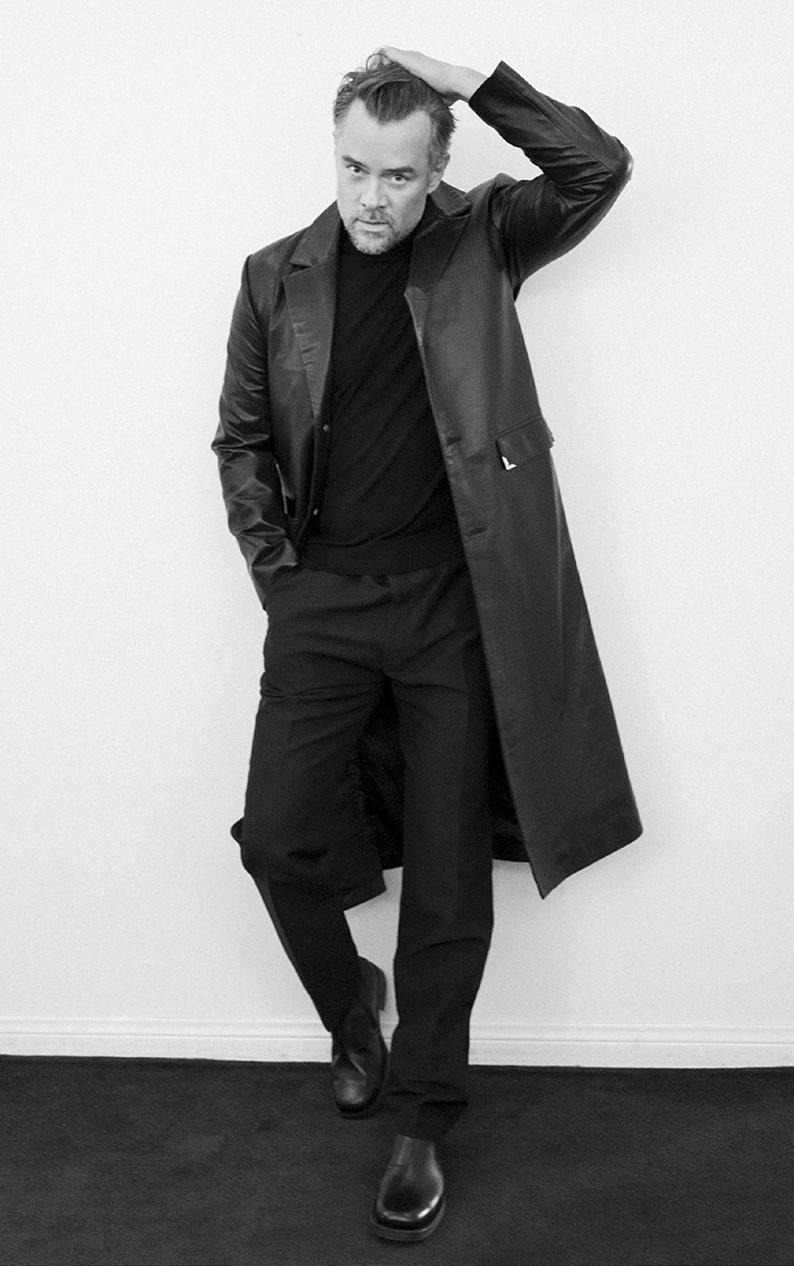
What was the first big ticket item that you bought when you finally made some money?
I bought a 2004 GMC Sierra Denali pickup and I still have it.
You still have it?
I still have it. I bought it after my first year on Las Vegas. I wanted a brand new truck and I went and bought myself one. I loved that truck so much that I kept it.
Your wife Audra is from North Dakota, too. Does that help maintain a sense of “home” so to speak?
Yeah, very much so. I mean, obviously there’s a pretty big age difference [21 years] and that wasn’t really what I was looking for, but when I met her I was like, wow, this girl is like… it took me a long time to reconcile with that idea that, oh man, I’m that dude, the young girl, way too young, you know? But at the time I was like, she’s from my home state. She has a cabin, literally her family has a cabin less than an hour from mine. And we met here, right here, where I’m sitting, four years ago.
I was having a party for the Masters, the golf tournament. We’d talked a little bit because I knew that she was from North Dakota. It wasn’t even really looking to date her at the time. I felt like she was too young. She’s gonna think I’m way too old for her anyway, so I just wanted to welcome a hometown girl back to the house. There were a bunch of people there and then I met her.
First of all, she’s super hot, and we have similar interests and likes, and she’s very much into family and going home. And she’s not in the business, which is another big plus.
I wanted somebody who was not in the business. There’s only room for one super narcissist in this relationship. (Laughs) But she’s fantastic. I’ve gotten over the fact that I’m way too old for her.
Why do you think that there is such a disconnect when the Midwest is portrayed, especially within entertainment? It’s generally portrayed as backward and less sophisticated.
You know what, I’m almost okay with it because I’d rather keep it a secret! It keeps all the riff raff out. You know, you’re right, you’re absolutely right. This is the most beautiful country in the world. There’s just so much from deserts to mountains, to beautiful forests to the lake country. I just love the lakes. There’s something so back to the basics about lake life. It’s so simple, it’s so beautiful, and so much fun. I love going to the beach, but I’d rather have a cabin on the lake in Minnesota than a beachfront property in LA to be honest. Because it’s the quietness, the stillness, the campfires…
Campfires, Busch Light, and bugs. (Laughs) There are a lot, but you just kind of forget about that when you’re out there. I’ll never forget the first time I saw
my property, my dad took me out. He knew that I wanted a place that was really remote. I wanted to be on a lake. I’d never had a lake house before. When I was young, we didn’t have the money to afford it, but I just wanted something like a little log cabin by a lake that I could fix up as I go. So he brought me to this property out in the middle of nowhere on this beautiful little lake. Way in the woods. I’m like, “Oh, wow. I love it!” You had to fight off the horse flies, the mosquitoes, the bees, and everything else, but I was like, “I love it!”
North Dakota is a great state for roadside attractions. It has has some insane giants.
I know, right! In fact, we’ve always talked about it because you know, I’m the face of tourism in North Dakota. And one of the things I’ve always wanted to do was to go to every one of those sites, whether it’s the giant gorilla or the giant Holstein, there’s the giant buffalo outside of Jamestown. There’s a bunch. I wanna go through and do a cool photo shoot next to all of these things. We’re gonna take a road trip through the state sometime this summer for North Dakota Tourism, and just sort of showcase the simple little things that I think people are more interested in now than they have ever been.
You know, people are trying to get away and find some solitude and some peace of mind. And I think that’s what North Dakota is. It’s open roads and beautiful country, especially late in the summer with the sunflower fields, the canola fields, the wheat fields, and little roadside diners and bars. And the people are just incredibly kind.
Your parents divorced when you were young and you stayed with your mom.
They did. I was a fourth grader. Yeah, but it was difficult. They both went through some difficult times right after the divorce, financially. It wasn’t a pretty divorce. We bounced from house to house for a long time. None of us had any money. My dad was trying to get back on his feet. But you know, he has always been a really supportive, loving dad. I have just loved the guy.
Was being a father one day something that was a priority for you?
Oh man, that’s all I’ve ever wanted to be.. To me, you know, it’s so cute, because Axl’s kind of the same way. I see a lot of myself in him when I was his age. I’ve always had this affinity for kids. Holding them, playing with them. And I see my 9-year-old doing the same thing. My dad was always great with kids. And I think my son probably sees it through me. He has even said that to me. I asked him what he wants to be someday and he goes, “A Dad!” How cute is that!
What have been the most rewarding parts of being a father?
You know, there’s just nothing more fulfilling than watching a kid, watching this little helpless infant grow into this little person who grows into a little boy who really is starting to become like a young man. To see the innocence and the excitement and the energy and to see that he’s a really good
kind hearted kid makes me so happy. I’m hoping to have a couple of more. And he’s excited about being a big brother.
Have you found then that your upbringing has informed very much the type of dad that you are?
Oh yeah, definitely. I take the best, I leave the rest. They were both great parents in their own right. But you know, they were much younger than I was when they had me. They were still trying to figure things out themselves. They were both 23 or 24 at the time. I was almost 40 when I had my son. So I had 17 years of experience and had done quite a bit.
The trick is, how do I instill the same things my parents instilled in me, into my son, because we have very different circumstances; North Dakota, Los Angeles, money, no money.
He’s probably more spoiled than I ever was, but, you know, it’s my job. And that’s part of the reason, by the way, that I love taking him out to the lake, because we don’t live a fancy life out there. I’ve got a decent cabin and I’ve got some toys and stuff, but we do a lot. I put him to work and he likes to work out there now. I have him help me do spring cleanup. He’s raking or he’s shoveling. I taught him how to ride a four-wheeler last weekend.
You’ve reached the big 5-0 now.
I know! Believe me, my wife reminds me every day. (Laughs) She keeps me young. I am 50 now. I didn’t want to celebrate it. I didn’t want to talk about it. But it is one of those markers in life where you’re like, holy sh*t, where did all the time go? It’s funny, it was just yesterday I was turning 40. But I’m much further along. I feel better than I did in my midthirties. I’m newly married, hoping to start a new family soon. My son is kicking a**, and life is good. You know, I’m 50, but you know what? I’m happy to be here.
I read that you threw your back out the night before the wedding.
Yeah! Dude, that was scary. I literally threw my back out to the point where I could not get out of bed the morning of the wedding. And I remember doing it. We had a band and they were kicking a**, and everyone was dancing. We got on the party bus afterwards and everyone’s continuing to dance in there. And I try to grab on to the two railings inside the party bus and do one of those gymnast things where you hold on and you stick your legs straight out. And my back went (makes a painful expression) and I was like, “Ooh, that’s not gonna be good.” I was still able to move around, but the next morning I literally could not get out of bed. I had to go to the emergency room, get shot up, take some meds. Miracle of modern medicine. I was just fine all through the wedding.
Really?
Yes, I was dancing that night! The next morning after the wedding day, I couldn’t get out of bed again. It took months to get over it.
That is horrible! That is a memory that will stick with you for some time!
Check out Josh’s new film, Buddy Games 2 , in theatres now.
21c Museum Hotels introduces two food and beverage concepts inside its new St. Louis property, opening this summer.
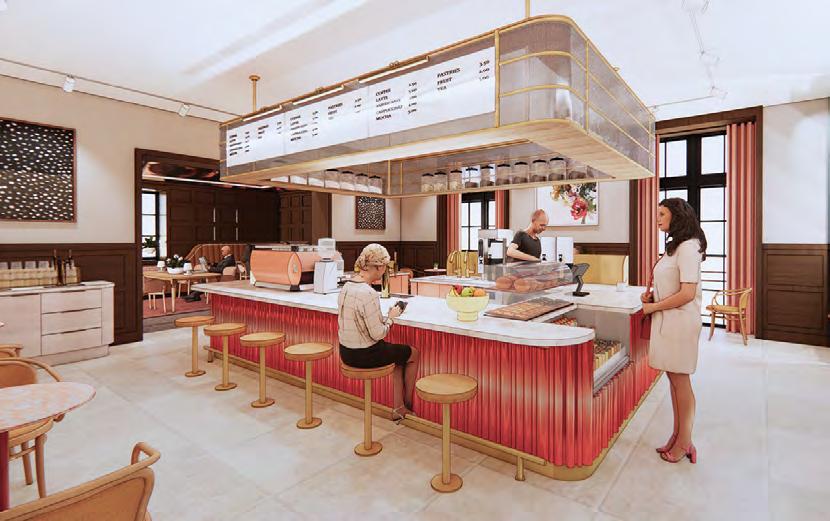
Inspired by the rich culinary traditions of Spain, Idol Wolf takes a playful approach to tapas style dining by combining local and seasonal ingredients with classic Iberian sensibilities.
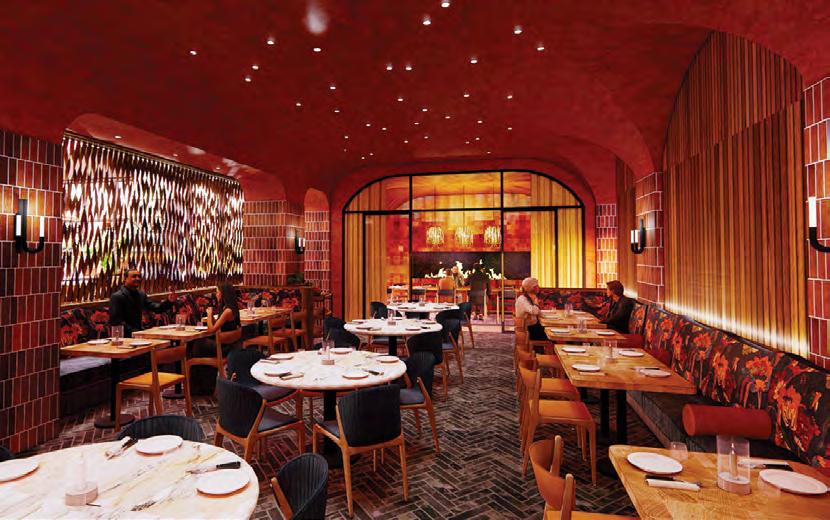

Good Press is downtown St Louis’s next favorite coffee café by utilizing local roasters, growers, and purveyors.
Follow us @21cSTL @IdolWolfSTL @GoodPress.STL 1528 Locust Street, St. Louis, MO
Both restaurants are under the leadership of St. Louis native, Executive Chef Matthew Daughaday and find inspiration in the best ingredients the Midwest has to offer.
> Learn more at 21cStLouis.com

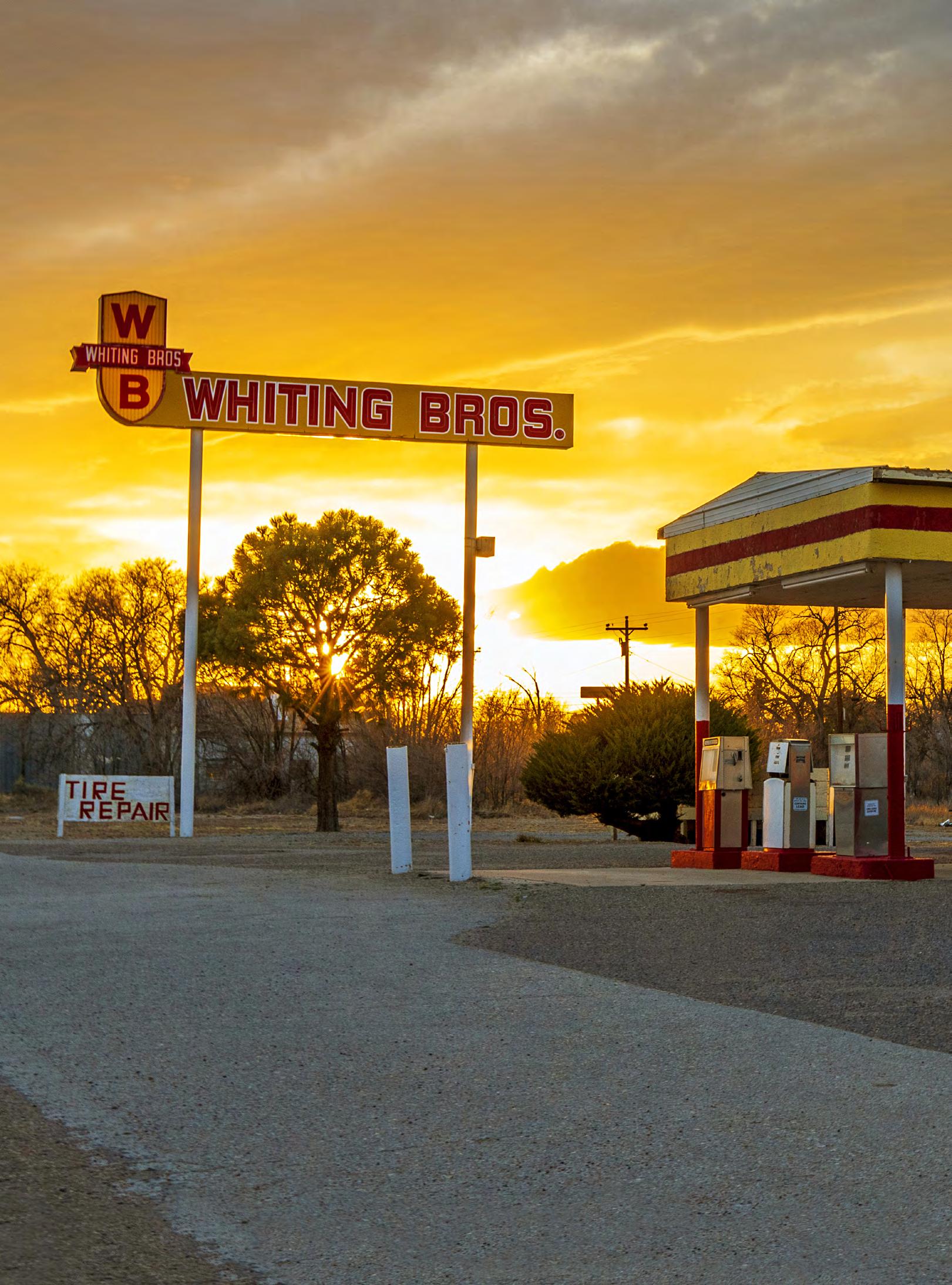
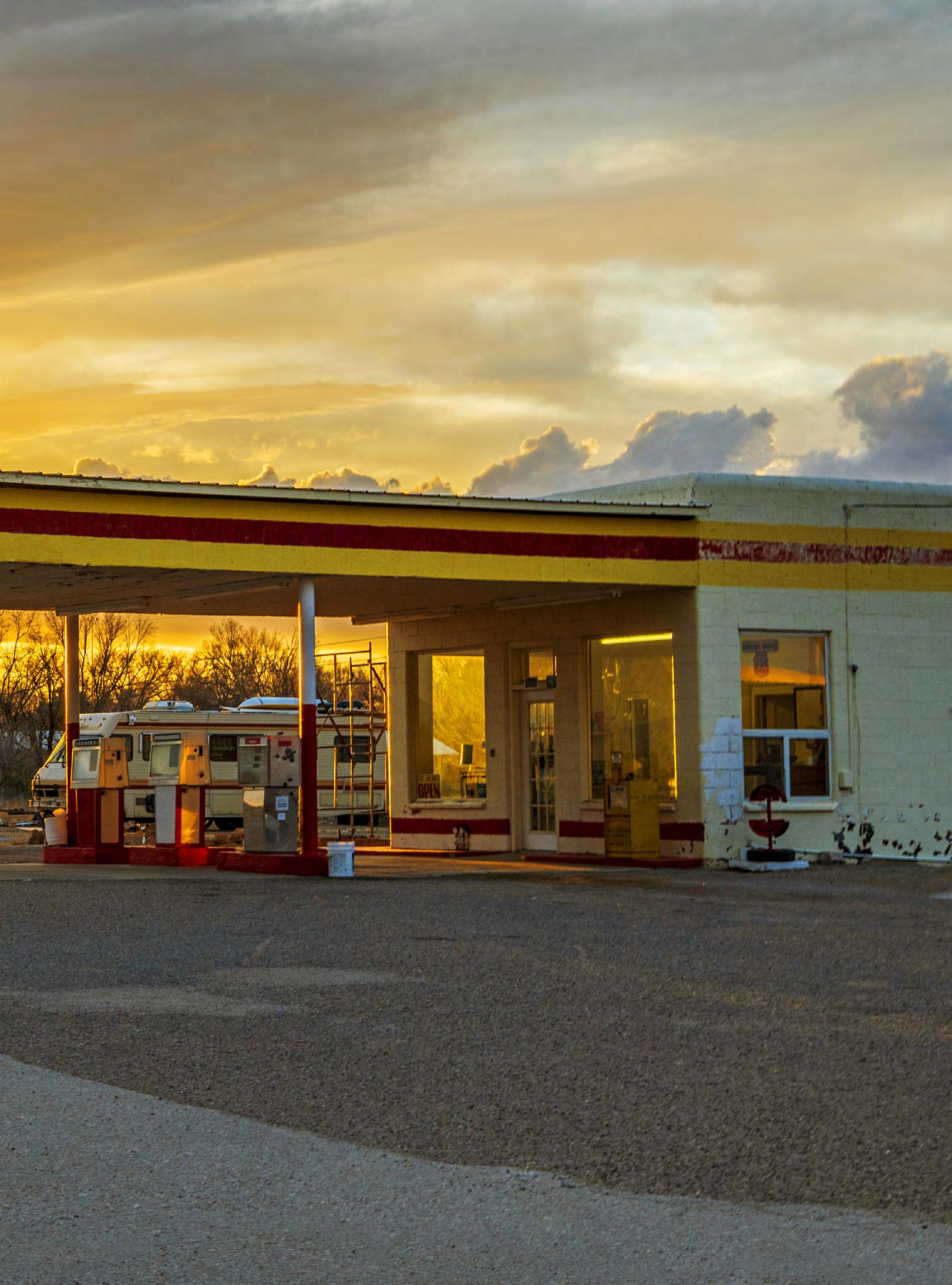 By Marianna Civitillo
Photographs by Efren Lopez/Route66Images
By Marianna Civitillo
Photographs by Efren Lopez/Route66Images
ucked away in the desert landscape of New Mexico, between Albuquerque and the Indian Hills, is the quaint town of Moriarty, a lesser-known destination that early in 1937, got a seat of honor at the Route 66 table. Here, on the east side of the town, a giant, eye-catching sign, erected on the side of the road in an almost palm-tree fashion, beckons travelers from around the country. The marker is neither a gateway nor civic sign. It’s the sign of a vintage gas station, of bright yellow tinge, a vermillion-red frame and font — all the colors that best represent the essence and earnestness of the supple Southwestern state.
Enriched by resilient characteristics, it proudly wears its two letters “WB” in a vertical line, like a badge of honor, and the words “Whiting Bros.” in a horizontal banner. The distinct sign is a testament to the hard work and dedication of the brand’s four founding brothers. This New Mexico station is the last of its kind serving as a special illustration of a forgotten era of an America that once was. The big flaming letters are lit 24/7: they shine, illuminated by the persistent sunbeams by day and make themselves known through electrified tubes of neon glass by night, brightly glowing in the desert’s stark darkness.
Having its start in St. Johns, Arizona, the Whiting Bros. station franchise quickly made its way across the country and grew to over 100 locations. But after five decades of flourishing activity, the iconic WB stations and signs began to be torn down, with many sold and replaced by modern, now-household names such as Shell. By 1990, the Whiting brothers had sold their last gas station and by that time, the surviving ones were most likely being supplied by smaller distributors and kept running at a loss. Today, only one remnant survives, a testimony to the incredible journey that the Whiting Bros. brand has had. A generational journey that takes us back to over 120 years ago.
Edwin Whiting, born on September 9th, 1809, in Massachusetts, was one of 12 children sired by Elisha Whiting Jr., a wagon and chair maker, and Sally Hulet Whiting, a poet. The family moved from Massachusetts to the western frontier of Ohio in 1815 which, with its high supplies of raw materials, better suited Elisha’s trade of which son Edwin later joined and together, established a successful and reputable chair making business.
Edwin, a member of the Church of Jesus Christ of Latterday Saints had already taken on two wives, Elizabeth Tillotson and Almira Meacham and moved from Ohio to Illinois, by the time he wed Mary Elizabeth Cox in 1846. Mary and Edwin’s first born came into the world in 1847, just as they were making their way — heeding their church leader’s call — into the Great Salt Lake region on a long and exhausting journey through vast and unexplored parts of the country.
TThey arrived in Utah in 1849 and Mary thought that the place was the prettiest she’d ever seen, with green trees on the side of the roads and still-blooming orchids. Mary and Edwin settled in, and the family soon expanded with eight more children, including their sixth child, a son named Edwin Marion Whiting, born in 1857. Mary and Edwin and their children enjoyed a long, prosperous, and busy life in Utah with Edwin becoming captain of the militia in the Walker War and then Mayor of Manti, Utah. He died on December 9th, 1890, age 81, and Mary passed away on July 15, 1912.
Edwin Marion Whiting made his first trek into Arizona in 1877 with the early Mormons, settling in present day Winslow. He married Anna Maria Isaacson in 1881, and moved back to Utah, before finally settling in St. Johns, Arizona in 1901 where he established a saw mill as well as a general store. The couple had nine children, five girls and four boys: Edwin Isaacson, Earnest, Ralph and Arthur. And this is where the story of the “Whiting Bros.” really begins.
The Edwin Marion Whiting family were an industrious bunch and soon had a string of diverse enterprises in St. Johns, including Whitings Sawmill and Planning Machinery, Whiting’s Lumber Yard, Whiting’s Feed Stable, and a car dealership among other holdings. In 1914, Edwin Isaacson, along with his father and four brothers, established a small garage business that provided automotive maintenance and repair services. With foresight to growing automobile popularity, they also started selling gasoline in St. Johns in 1917 on the National Old Trails Road. As demand grew, and with the apparent establishment of a diagonal highway connecting Chicago to Los Angeles on the horizon, they opened a second location with modern pump technology in Holbrook, Arizona, which became the company’s headquarters in 1927. Soon, the Whiting Bros. gas station business exploded into Winslow, Flagstaff, and all along Route 66, from Shamrock, Texas, to Barstow, California. As they expanded their business holdings, they added souvenir shops and cafes next door to their stations. In 1955, the company also ventured into the hospitality industry, operating 15 motels, including two in Holbrook.
“The brothers started by selling gasoline in 55-gallon drums and later on started building small stations like this one in Moriarty, 40 miles east of Albuquerque, and they expanded into Texas, Northern Utah, all the way to California,” said Salomon (Sal) Lucero, life-long employee of the brand, and the cheerful 85-year-old current owner of the Whiting Bros. station in Moriarty. “The stations were more than 100, I cannot tell you the exact number, but I guarantee that there were more than 100 WB stations. They were really nice people to work for.”
The Whiting brothers were pioneers in many respects. Today we would call them “entrepreneurs” and “marketing geniuses.” They recognized the urgency and value of “brand identity” and “product development” early on. Unlike other major gasoline brands, the WB gas stations were designed in a simple yet efficient fashion, distinct in their unifying shield emblem and the yellow and red eye-catching colors. The buildings were of linear, geometric architecture, sleek and streamlined in form, made of light-colored concrete or white stucco, adorned with steel or aluminum shapes of dramatic red and yellow tints. Each gas station had adjacent
living quarters for the station operators, an incentive for the employees. Customers were awarded discount cards and the assurance of “quality gas for less” as their motto went, a move that endeared the WB brand and secured the devotion of the motoring public. To capitalize on roadside advertisement, they also had giant signs, yellow with red lettering, placed intermittently along the highway to remind motorists to stop in. This attention to detail ensured a prosperous and roaring business from the 1920s all the way into the 1970s.
Edwin Isaacson had married Ethel Farr in 1906 and together they had spawned seven children, four sons and three daughters. Two of their sons, Edwin Farr and Virgil Burr became involved in the family business, taking the WB company into greater heights of success. They were positioned to be the new leadership of the Whiting empire. But then disaster struck.
In 1961, Virgil, an avid pilot, had made a promise to never fly with his brother Farr, however on this one day, an exception was made, and they flew together, headed for a business engagement in Phoenix. The small plane, piloted by Virgil, crashed, and the two brothers lost their lives. Their father Edwin Isaacson never fully recovered from their untimely death. And neither did the company. Edwin Isaacson passed away two years later, in 1963.
The Whiting family was dealt yet another blow. By the 1970s, the Whiting Bros. stations started to crumble under the pressures of a modernized world and the weight of the family tragedy. The decrease in traffic at the WB locations
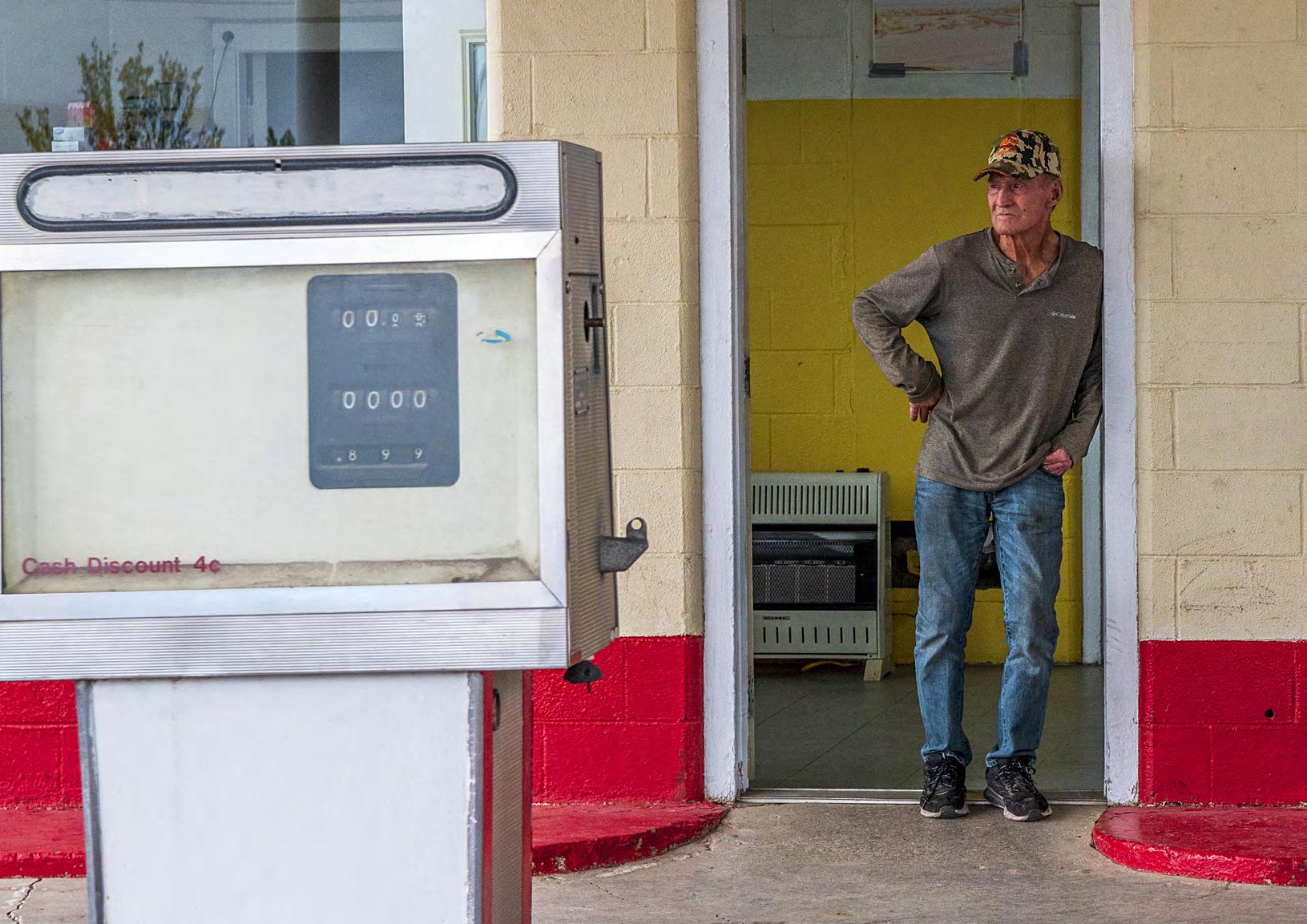
on the U.S. Highways, including Route 66, as a result of Interstates being built, had an extreme financial hit on the family-owned company and by 1985, the brand was almost out of business. Some of the gas stations that were located in sustainable environments were sold to new owners, while many located farthest from the Interstates and on Route 66 were abandoned or torn down.
Today, there is only one existing station operating with original WB signage and it is the one in Moriarty, New Mexico, along Route 66.
“They [the WB brothers] bought the Moriarty property from my husband’s father, Mr. Pogue, almost 70 years ago. They wanted property on Route 66, which was incredibly busy at the time, and this station in Moriarty was the third busiest station in the whole chain,” said Debbie Pogue, Sal Lucero’s business neighbor, friend, and owner of Sunset Motel.
Route 66 in New Mexico was rerouted through Moriarty along Route 6 in 1937, prompting the town’s rapid growth and an explosion of commercial development. Gas stations, diners, vehicle repair service bays, and motels, including the Yucca Motor Court built by Mr. and Mrs. Hubbard C. Pogue in 1939, sprung up to cater to a traveling America. Bill Pogue, Mr. and Mrs. Hubbard C. Pogue’s son and Debbie’s fatherin-law, married Elaine in 1947, and they built their first home on the east side of town, on what is today the location of the
Whiting Bros. gas station. In 1955, Bill and Elaine sold the property to the Whiting family and bought the adjacent land on which they built the iconic Sunset Motel.
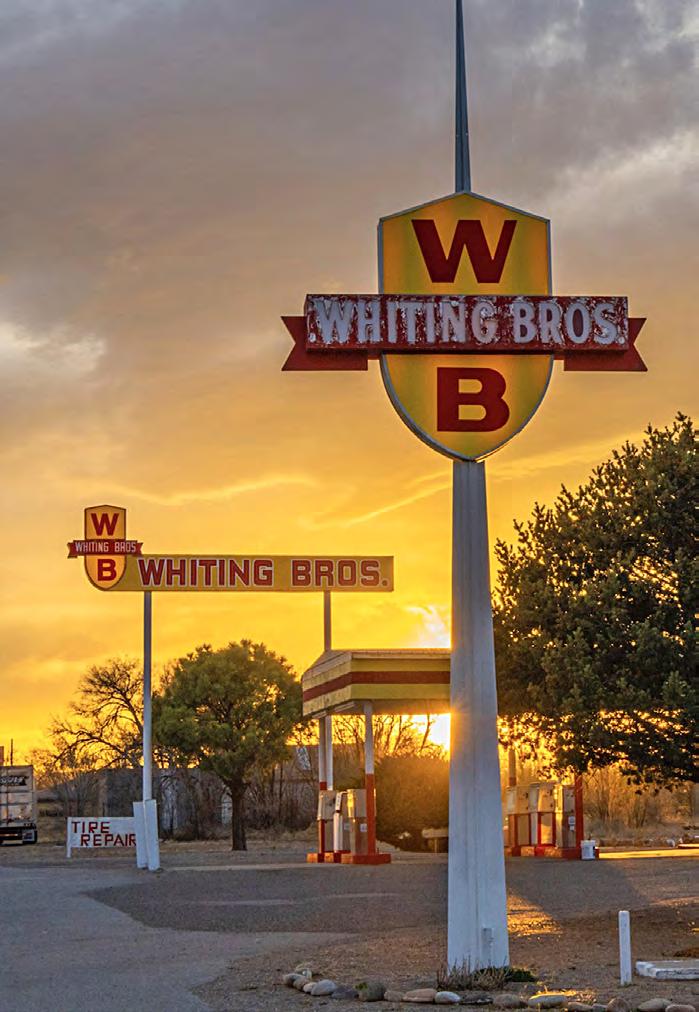
Sal Lucero met his wife Inez Ortiz while she was helping her father at one of the stations in New Mexico and they married in 1959 in Las Vegas, New Mexico. “I first started working with the WB through my father-in-law, [Ciriaco] Ortiz,” said Lucero. “He started working for them in eastern New Mexico. Then he moved and started working here [at] the Moriarty station. I took it over in 1969 because he got hurt and had to retire. At that time, Route 66 kept us busy, and we were open 24 hours, 7 days a week. I was busy, busy, busy.”
During the course of the Whiting Bros. gas station expansion, they started assigning numbers to their growing locations. The Moriarty station was christened station #72. When the stations started shutting down, as a result of the business decline brought on by the Interstate, Lucero bought station #72 in 1985 and has never looked back.
Lucero and Inez were married for 54 years. “We raised our two girls, Theresa and Rebecca, and one boy, Raymond, here on the station’s grounds. I remember they would run around the place as they were growing up.” As adults, Lucero’s children stay involved with the station, keeping the original Whiting tradition of a family business going.
Route 66 was central to the fortune of the WB brand as it carried the warmth and familiarity of forty of the 100+ WB stations for many years and through many states. Station #72 still carries that warmth today, thanks to Lucero and his family.
“My wife, she’s been gone 10 years now. She was 75 when she passed in 2014. It was a tragic moment for me, we had been together all our lives. But then I thought, I can’t close the shop. I thought, if I close, then what am I going to do
with my life? The place keeps me busy. This is the only WB still operating. Most of them are locked-up or being torn down, and this is the only one that’s going, the only one that’s alive! When I first started, when I was young, I didn’t have a home. At the time, the [Whiting] brothers provided me with a home next door and still today, this is my home!”
Unique to the Moriarty station is its iconic Whiting Bros. sign. First erected in 1964, it stood as a familiar beacon to motorists of a brand that they could trust. When Lucero first acquired the station from the brothers in ’85, the property was supposed to be rid of the original sign as the business was to be renamed Sal & Inez’s Service Station. But today, the sign is what makes Lucero’s station famous, as owner of the only “architecturally pure” WB building in the whole country. “There are WB signs in places, there are WB parts of buildings in places, but [Lucero] has the whole package and it is the only one,” said Pogue.
The sign had gone dark sometime early into the new millennium but in 2014, a local non-profit organization, along with members of the local community, spearheaded a campaign to restore it. A Route 66 Corridor Preservation Program cost-share grant of just under $4,000, along with funds from independent donors and investors was able to bring back the delight and glow of the old neon. “They were 85% of the way done with the restoration and the electrician was into the sign to hook up all the neon and carry out the last electricity work. All of a sudden, he comes screaming down the ladder with this huge owl following him out of the sign,” recalls Pogue, who was central to the restoration of the sign as grant writer.
However, it wasn’t just one single owl, but a whole family of them that had taken shelter in the sign. Waiting for the owls to leave on their own accord delayed the relighting for a few months, but in December 2014, the sign glowed once again. “When we were done, we had a huge celebration, and it was great. It was really small-town-cute with fireworks and folk music. This station is Sal’s life and the center of our community,” noted Pogue.
Although the station stopped pumping gas in the early 1990s when it became uneconomical, making only 0.2 cents on a gallon, it is still a popular Mother Road stop, with domestic and international visitors passing through to take photographs and say hello daily. In lieu of gas, Lucero offers vehicle repairs and an opportunity to hear the station’s and WB brand story. “Sal spends his days working and talking to everybody. He has rheumatoid arthritis but that does not stop him, he’s up every morning at 7AM... he says if he ever sits down, he’ll never get back up again,” said Pogue. “I think that’s where he gets his energy from, by telling the story of the Whiting brothers.”
Along the oldest highways in America and across changing landscapes and faces, there are still a few vacant gas stations that bear the original Whiting Brothers branding. These stations are still visible, but have long been abandoned and left to rust, and disappear. Time has not been kind to many stations along Route 66, but some are being restored, if not for use, for recollection and celebration; a celebration of a time when the ma-and-pa petrol station ruled the highway. Sal Lucero’s lonely stop along New Mexico’s serene stretch of Mother Road stands as a perfect tribute to a family’s legacy and a time when familyowned businesses dominated the roadway.




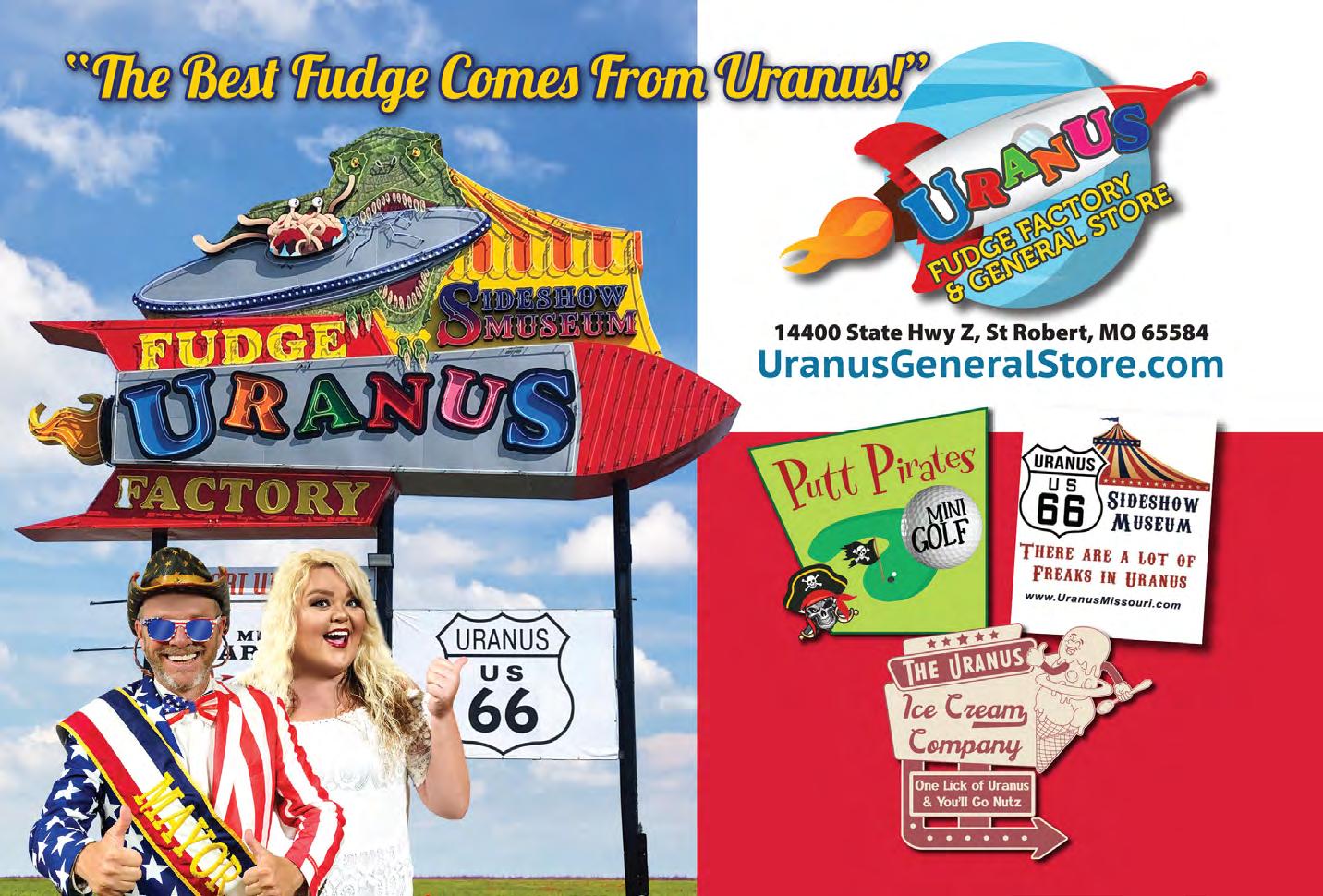

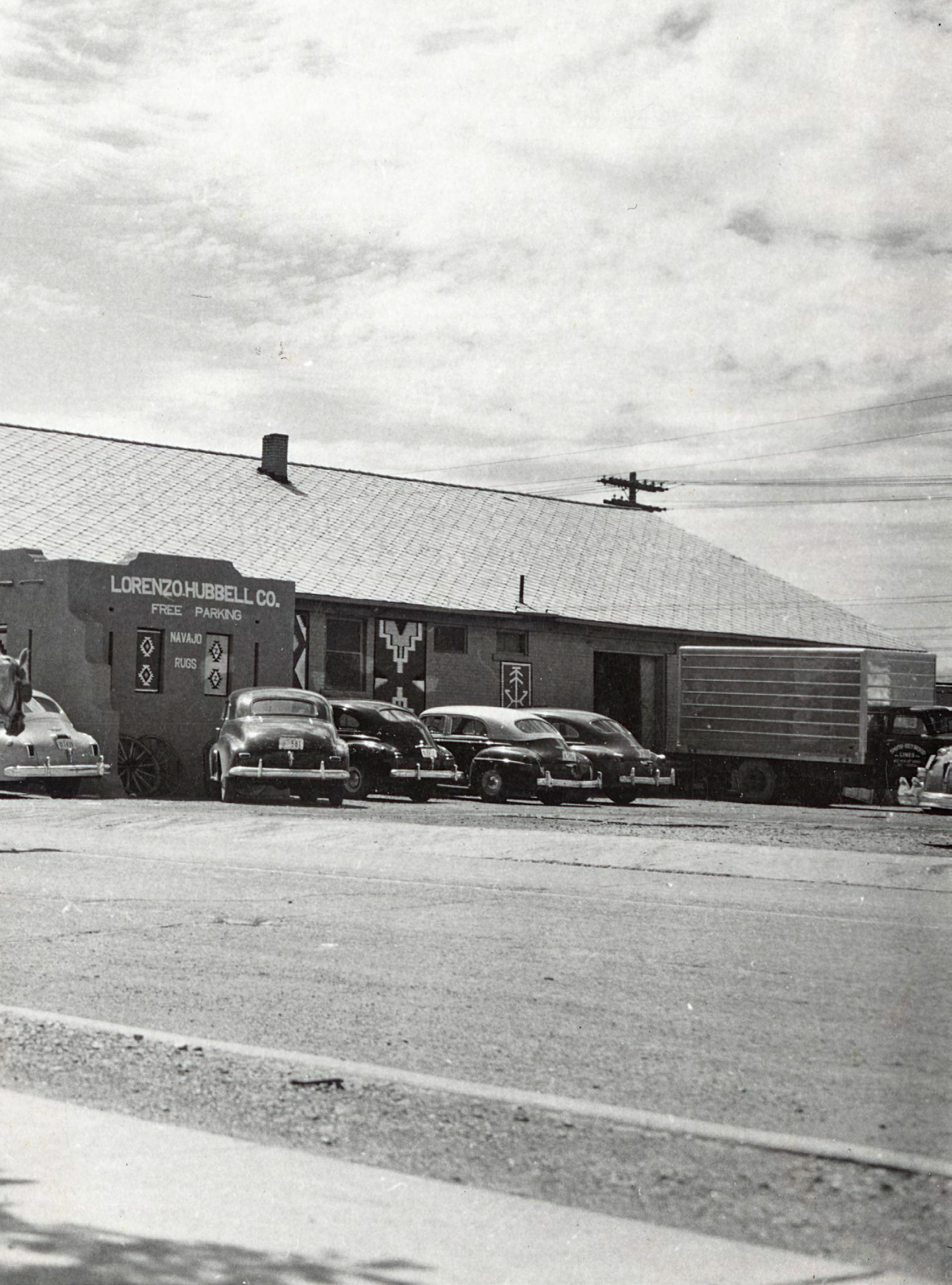 By Kelli Smith
Photograph courtesy of the Greater Arizona Collection
By Kelli Smith
Photograph courtesy of the Greater Arizona Collection
Nestled in the desert are countless towns with stories of the Old West and the establishment of America as we know it today. Winslow, Arizona, with its rich history surrounding its proximity to the Navajo and Hopi reservations and the Mother Road, is no exception. However, over 50 years before the Eagles’ recounted “standing on a corner in Winslow, Arizona,” and gifted the small town its biggest claim to fame, the Lorenzo Hubbell Trading Post came to be on Second Street, aka Route 66. And along with it came a story and a journey that would shape the region for decades.
The Lorenzo Hubbell Trading Post’s existence is the result of two prominent trader families; the Richardsons and the Hubbells. Brothers, Hubert and C.D. Richardson first established their trading post business in Gallup, New Mexico, in 1913, eventually venturing further into the West. Winslow, only 127 miles west of Gallup, was situated perfectly along the Santa Fe railroad, offering stronger connections to the textile mills throughout the country. To expand on their Gallup enterprise, the brothers built the Winslow trading post in 1917 so that goods brought from the reservation by wagon could be traded and shipped by rail. By 1920, the Winslow trading post had become a major shipping center for the Santa Fe Railway and Winslow became one of the fastest-growing towns in northern Arizona.
The Hubbell family also had a long history of trading with Native Americans, starting in the late-1870s when Juan Lorenzo Hubbell opened the family’s first trading post in Ganado, Arizona. In its heyday, between 1896 and 1912, the Hubbell Company owned over 30 trading posts in the area, becoming one of the best-known entities in the entire Southwest. They retained great influence in the region for decades beyond most. But by 1912, Juan Lorenzo retired to work in government and help lead Arizona into statehood. He handed the business over to his two sons, Lorenzo Jr. and Ramon, who divided up the pre-existing locations and maintained ownership for several decades. However, unlike the Richardsons, the Hubbells had yet to acquire any trading posts near the Santa Fe rail line. In 1926, Lorenzo Hubbell Jr., purchased the Winslow trading post from the Richardsons in a move that not only enabled him to ship his goods and wool to the East Coast, but it also began a long and significant relationship between the Navajo, Winslow, and the Hubbell name.
Not only was the Winslow location a major shipping center, but the trading post also became essential to the Navajo people too, serving as a community center where they traded and gathered with friends and family. Hubbell Jr. took their rugs for store credit and offered a one-stop shop for necessities, such as food, gunpowder, and sewing supplies. His hospitality and services garnered him great respect from the Native American community.
“One unique thing about Hubbell was that he spoke fluent Navajo and Hopi,” said Bob Hall, CEO of Winslow Chamber of Commerce. “By doing that, he showed Native Americans a great deal of respect. He never tried to change them.”
Hubbell’s understanding of Native American culture and thinking guided his appraisals and interactions. He assessed rug value based on design rather than size. “[Native
Americans] tell a story in their rugs,” said Hall. “A small rug might be much more valuable than a big rug because it’s telling a more important story.”
The Lorenzo Hubbell Trading Post operated successfully for over a decade, but the increasing prominence of motor vehicles and the changing times eventually caused business to wane. “[Cars] changed the way America operated,” continued Hall. “Social norms were changing. [Native Americans] were allowed to go into the bank and mercantile in town. They were integrating into society more by the 30s and 40s.”
And with all of the changes taking place, many trading posts closed due to a lack of customers, but Hubbell had one crucial advantage: his location was on Route 66, the perfect spot to be highly visible to the endless traffic passing by each day.
Hubbell shifted his focus, selling Native American goods like baskets, rugs, jewelry, and pottery because these items caught the attention of travelers. In yet another effort to keep the business going, Hubbell commissioned a Navajo woman named Julia Joe to weave a 22 x 32-foot rug in 1932 that he hoped would stimulate tourism revenue. Joe took five years to complete what was and still is the largest seamless Navajo rug in existence, with a loom that was specially built for the project. Hubbell installed a striking advertisement to generate interest in his business and promote the spectacle.
“If people were driving down Route 66, they’d see a big sign,” said Hall. “It says, ‘The Lorenzo Hubbell Trading Company and Museum,’ and at the bottom of it, it says ‘Home of the World’s Largest Navajo Rug.’” It helped the Lorenzo Hubbell Trading Post remain one of the nation’s most successful and enduring trading stores. The rug remains in Winslow today, at the Route 66 Art Museum at the historic La Posada Hotel, where it has undergone intense care to protect its colors and cleanliness.
Lorenzo passed away in 1942 at the age of 58. His brother Ramon took over the family business until eventually declaring bankruptcy in 1952. Kyle Bales, a Phoenix real estate developer, purchased the building along with its inventory and operated it as the Hubbell Trading Post. However, by the late-1960s, like most other businesses in the region, the trading post once again fell on hard times, due to the integration of Interstate 40. Bales officially closed the trading post in 1972. His daughter, Patricia deeded the building to the Arizona Historical Society who rented it out to various businesses until the City of Winslow took possession of it in 1998.
In 2005, Bob Hall spearheaded its restoration, and it reopened as the Winslow Chamber of Commerce and an official Arizona Welcome Center in 2009. Despite years of neglect, the original flooring, vault, and windows remain intact. This building remains true to its story and delightfully nods to its origins on Route 66 for travelers and locals to enjoy.
The Hubbell Company’s importance to the region cannot be overstated. They paved the way for the trading post industry in the early decades of the 20th Century and became the best-known traders in the Southwest. Today, few historic trading posts still operate along Route 66, but Hubbell began a tradition that in its own small way, still endures.
The beautifully restored Plaza Hotel has presided in Victorian splendor over Plaza Park since 1882, when Las Vegas was the richest and biggest city in New Mexico.
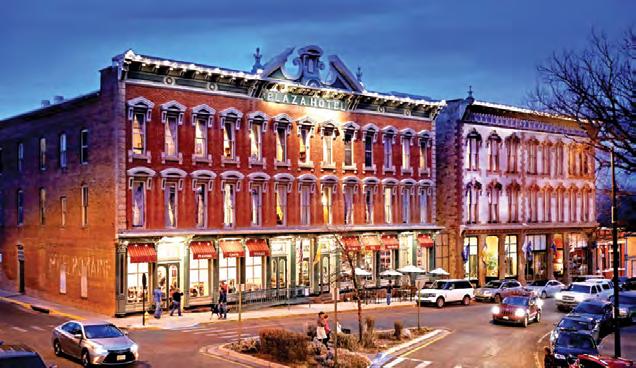
Just one hour from Sante Fe, come discover Las Vegas—one of the prettiest small towns in the Southwest!
230 Plaza Street • Las Vegas, New Mexico 505.425.3591
plazahotellvnm.com
prairiehillcafe.com
From 1930 to 1935 Julia Joe and her family made the world’s largest and most famous Navajo weaving. This legendary masterpiece has not been on display for decades. In the 1930’s it was stored at the Hubbell Trading Post in Winslow, and shown at La Posada.
Allan Affeldt found and purchased the rug in 2012 and donated it to the Winslow Arts Trust. A special gallery has been built in the depot at La Posada. In June of this year we will open that gallery and bring this amazing weaving back to the public.


COMING TO THE MUSEUM
AT LA POSADA in Winslow, Arizona winslowartstrust.org
This was Fred Harvey and the Santa Fe Railroad’s first track-side hotel— the beginning of an empire!
Closed for 70 years, the Castañeda was lovingly restored and reopened in 2019. Join us for one of the finest dining and historic hotel experiences in New Mexico!

524 Railroad Ave • Las Vegas, New Mexico 505.425.3591
castanadahotel.org
kinlvnm.com
La Posada Hotel (The Resting Place) was Fred Harvey’s last great railroad hotel. Designed by architect Mary Colter in 1929, it has been restored to its regal and charming hacienda style.
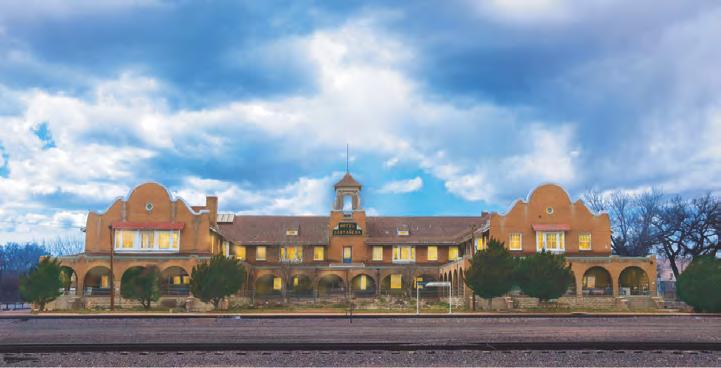
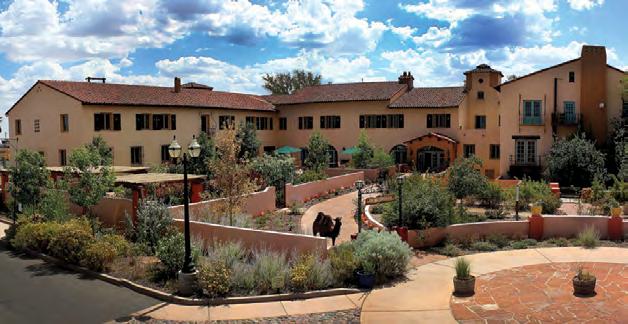
Stay with us and enjoy an unparalleled fine dining experience in Southwest inspired cuisine on historic Old Route 66.
303 E Second Street • Winslow, Arizona 928.289.4366
laposadahotel.org
tehturquoiseroom.com
On South Carson Street (Federal Highway 395) in the historic downtown district of Carson City, Nevada, stands a three-story, red brick building positioned right across from the Nevada Legislature. Standing impressively on this same spot since 1862, its well-preserved Italianate style harkens back to an era of gracious hospitality. This is the historic St. Charles Hotel, an establishment with a long and illustrious history as the oldest continuously operating hotel in the State of Nevada.
In 1862, Carson City was still in its infancy, but Congress had passed a bill establishing a branch mint in the Territory of Nevada. With the discovery of gold and silver, the economy boomed and Carson City quickly became a thriving commercial center. It was in this setting that two visionary twenty-year-olds, Albert Muller and George Remington, embarked on a daring business venture, betting on Carson City becoming the Nevada Territory capital.
In an effort to be ahead of blossoming opportunities, Remington and Muller, later joined by baker Daniel Plitt, set out to build the first grand brick building in Carson City — two hotels built side by side on a plot of land near where they anticipated the Nevada State Capitol would eventually reside. The northern building held three stories and opened on April 1, 1862, as the St. Charles Hotel, so named after many fine hotels in the East with the same name. An 1862 edition of the Silver Age newspaper described it as “the most desirable and commodious first class house in Carson.” The construction of the smaller hotel — the Muller — began in May 1862.
The St. Charles boasted of being the first building in town to have electricity and gas utilities, and it soon became one of the hottest places in town, attracting the crème de la crème of society. The Pioneer Stage Company had its offices in the building and the famous stagecoach driver Hank Monk was a frequent guest. Other noted patrons included author Mark Twain, who was possibly a regular.
“I haven’t seen any specific documentation, but Mark Twain arrived in Carson City in late July 1861 as the hotel was under construction,” said current St. Charles Hotel co-owner Jenny Lopiccolo. “It would be hard to imagine that he didn’t frequent the hotel during his years in Carson City, as well as the restaurant, and especially the bar, as he was well-known
as a drinker in the town. The hotel is also within blocks of his brother’s [Orion Clemens] home on Division Street.”
When the State Capitol was completed on May 1, 1871, the ground floor bar of the St. Charles Hotel became a renowned watering hole for lawmakers when the legislature was in session, since it was just across the street.
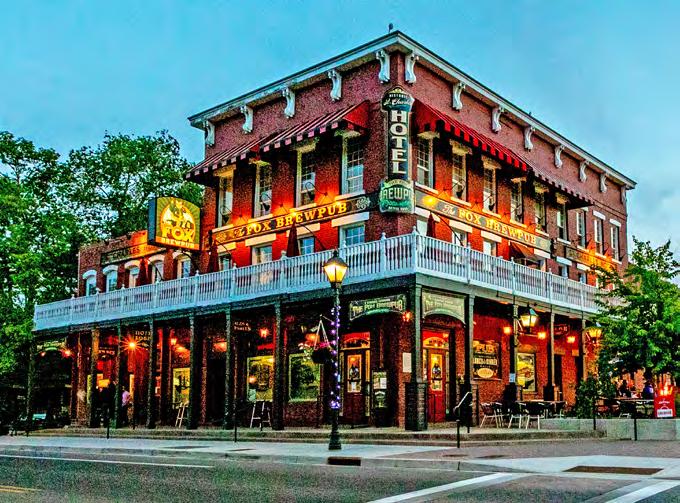
The two adjoining hotels merged in 1894, and were renamed the Briggs House when Gilbert and Dorcas Briggs purchased the properties. This was followed by fourteen different ownerships and name variations that included the Golden West Hotel and the Pony Express Hotel. Throughout the 20th Century, the St. Charles underwent a period of deterioration characterized by cheap rent and structural neglect. That is, until 1993, when local businessman, Bob McFadden, bought the decrepit property and invested a quarter of a million dollars into renovations and restored the hotel’s original name.
Realtor Jenny and construction company owner husband Mark Lopiccolo, current and owners number 16, bought the hotel in 2004. The Lopiccolos share a passion for historical buildings, so when the St. Charles went up for sale, they couldn’t resist. In 2007, they partnered with Jim Phalan of High Sierra Food & Beverage to renovate the downstairs restaurant into the Firkin & Fox Pub, now titled the Fox Brewpub. They then undertook a major restoration, bringing back the hotel’s original splendor. They installed new awnings, new signage, replaced the wooden boardwalk, and updated the rooms with modern amenities and conveniences.
“Restoring it has been a labor of love for my husband and I, and we love sharing it with our guests,” said Lopiccolo. “We are frequent travelers and history buffs and love to stay in historic hotels, so we’ve worked to create spaces that we would enjoy staying in ourselves.”
One hundred and sixty years after its construction, business is better than ever, and this old relic has earned its rightful recognition. “To my knowledge, it’s the oldest continuously run hotel/bar/restaurant in Nevada,” Lopiccolo said. “It’s listed as a landmark on the National Register [of Historic Places], and our government has always been supportive of restoring and rejuvenating our downtown corridors.”
This hotel isn’t going anywhere, anytime soon.
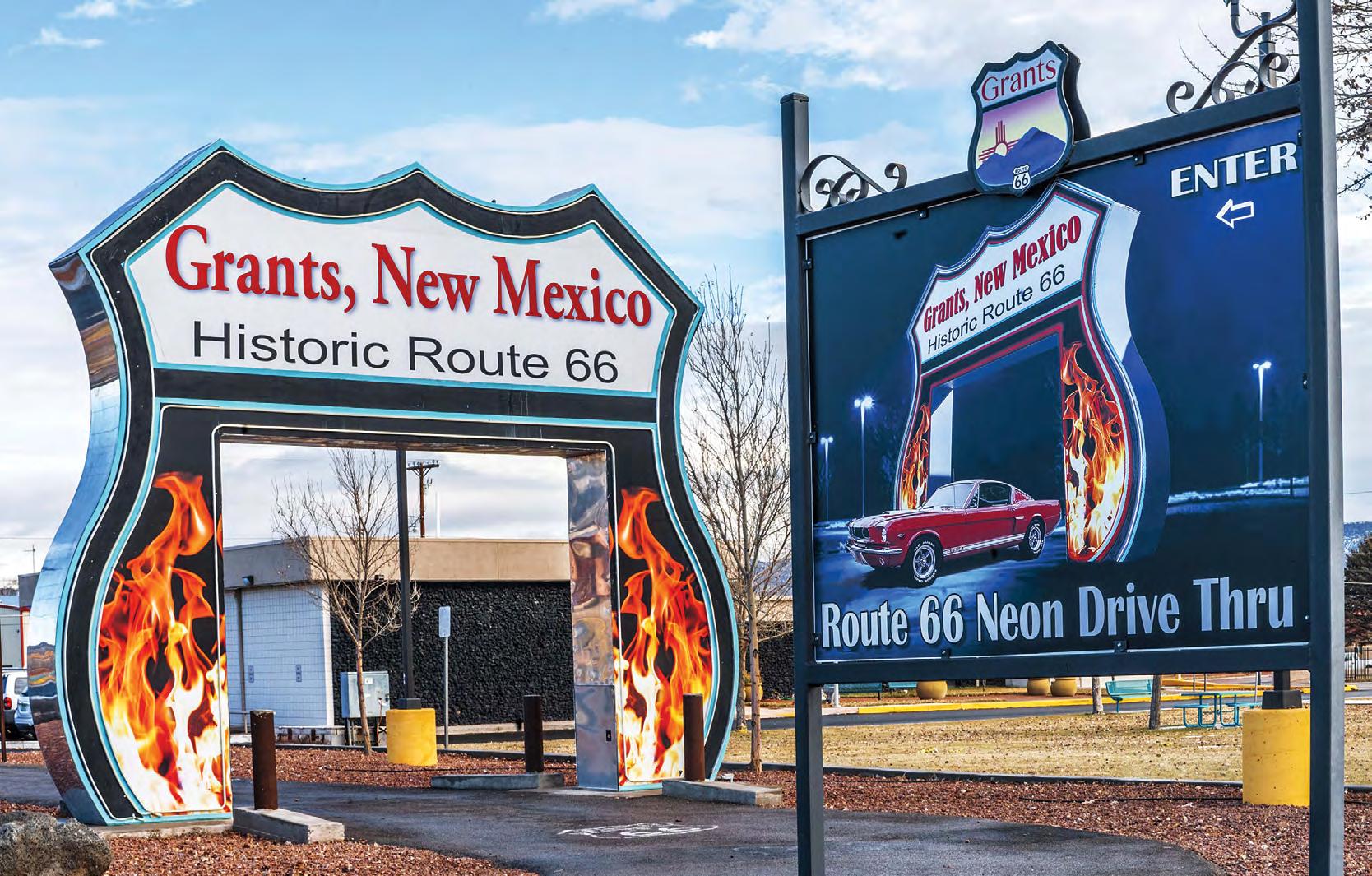
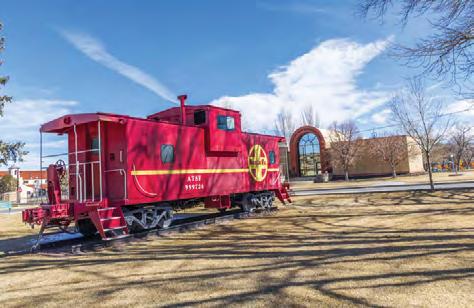
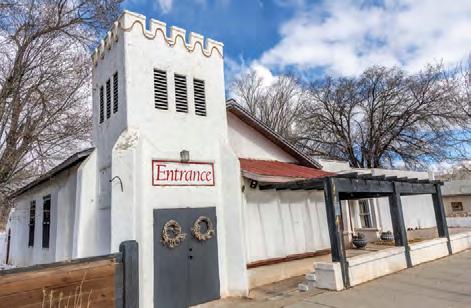
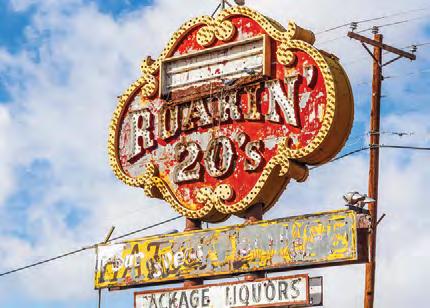









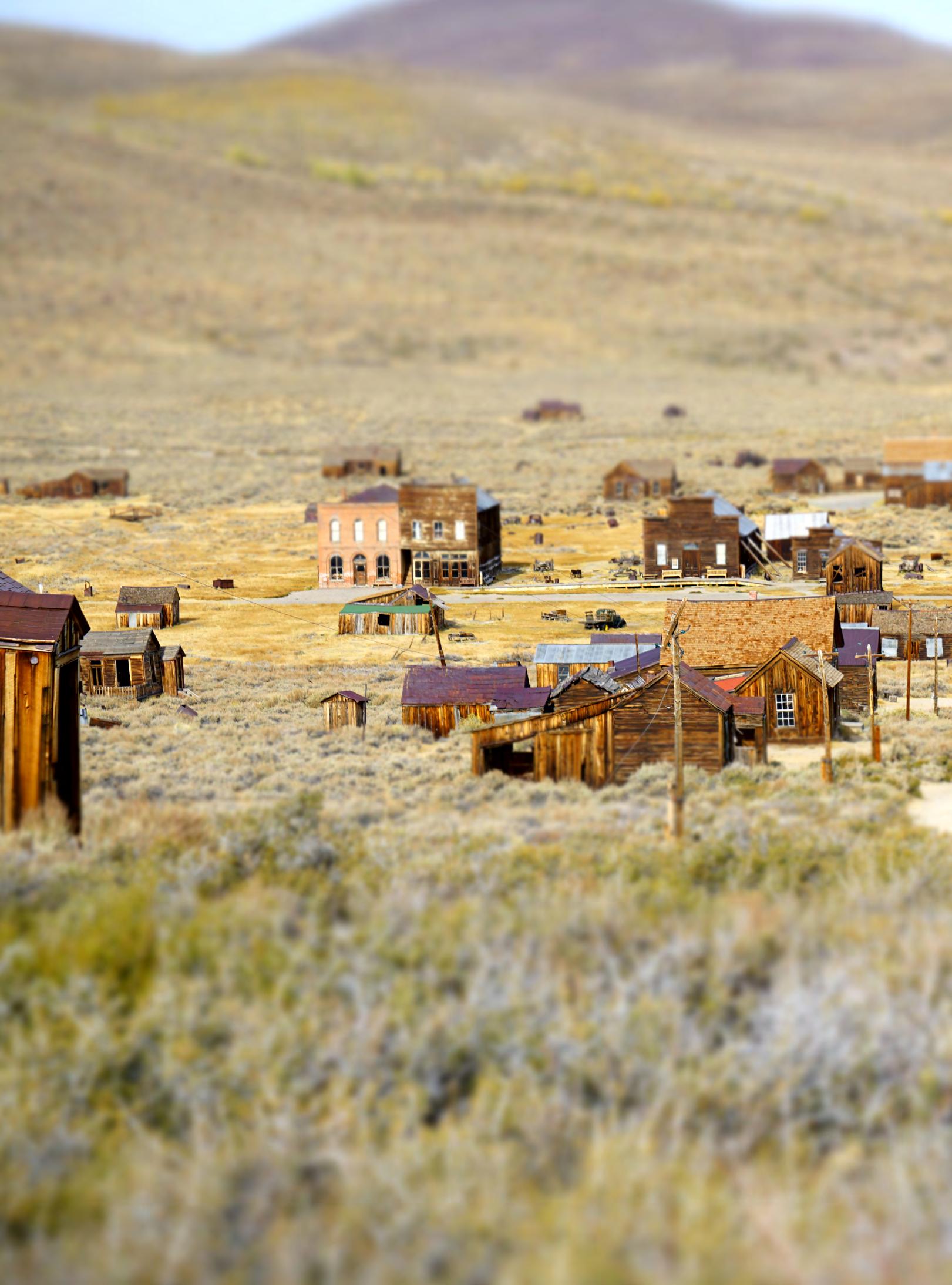 Opening photograph by Oscar Vasquez
Opening photograph by Oscar Vasquez

efore Route 66 — or any interstate highway for that matter — was built in the United States, pioneers packed up their belongings on the East Coast and set off west. Hoping to find lush land for farming and a place to begin new settlements, the 1800s brought forth a rush into the wilds of a young America, a fledgling nation eager to claim the land as their own. Covered wagons full of families, pioneers, ranchers, and cowboys made their way west, to explore what the land had to offer.
One man by the name of Johann Augustus Sutter famously planned on building a town called Sutterville that would be suitable for those making the treacherous journey, but plans changed in 1848 when Sutter’s partner, James Marshall, spotted gold in the American River near what we know today as Sacramento. He might not have known it then, but this began one of the most influential periods of history for the United States. A new influx of pioneers began to flock to the river and surrounding areas, hungry for gold — leaving behind Sutter’s sawmills and reshaping the future of the country. During this time, the United States had just signed the Treaty of Guadalupe Hidalgo, an agreement that declared an end to the Mexican-American war. And fortuitously, for the Americans anyhow, this meant that the land of California now belonged to the United States — as well as all the gold that came with it.
By 1849, as news spread of the discovery of gold, a frenzy ensued, attracting no less than 100,000 eager miners. The population of non-natives in California a mere year prior was only 800. This rush of people searching for gold became known as the 49-ers, and the combination of gold fever and the lack of government on the West Coast led to a duplicitous and raucous environment in these mining towns. While the rush was thrilling for newcomers, it had undeniable detrimental effects on the indigenous communities in the area. General lawlessness spiked in these boomtowns and created a truly wild and disordered culture. Mark Twain famously said of his experience with a mining town: “A mine is a hole in the ground with a liar standing next to it.” Those who didn’t mine were able to make a living profiting off of miners who were eager to spend their newfound wealth. Restaurants, saloons, and brothels opened up in towns and added to the famously unruly nightlife during the Gold Rush. Throughout the years, the methods for mining evolved. Early settlers panhandled, which involved one man sifting through river water with a pan and sieve. Once more people arrived, small machines worked by a team of men came along which sped up the process tenfold. This team mentality led to the creation of the first small mining companies in the States. It is reported that the gold and silver mined during the rush hit nearly $2 billion. California earned the nickname “The
Golden State,” but the golden days didn’t last forever. After a boom, dust starts to settle. The rush peaked in 1852 and, like all good things, the California Gold Rush came to an end. End dates varied across towns, but by the early 1900s, many inhabitants of these boomtowns were off to make a living elsewhere. Resources slowly diminished, and those who made a living off providing for the miners moved away to find customers with a steady inflow of cash. When they were sure that the jig was up, miners also left the towns behind forever. Places that were once thriving with townspeople were now left without a heartbeat. All that was left was evidence of lives lived and left behind. Forever.
The result was a multitude of deserted towns — roughly three hundred — throughout the state of California, alone. Today, these long forgotten towns contain a lonely, at times eerie atmosphere, albeit one that now attracts tourists. While nobody lives in these boomtowns-turned-ghost towns, visitors come to reminisce on this brief but important part of our nation’s history. At over a hundred years old, a lot of ghost towns have naturally deteriorated, and many have fallen to the dry earth, but one very special spot is still preserved in unique splendor, thanks to the Parks department.

In 1859, W.S. Bodey from Poughkeepsie, New York, along with three other companions, struck luck and gold in eastern California, only seven miles from the California-Nevada state line, and just northeast of today’s Yosemite National Park. They set up a cabin near their find and began working their claim. Within the next twenty years, the town of Bodie, which had sprung up as a result, had its population skyrocket to an estimated 10,000 people. Where there used to be nothing, there was now a bustling community full of very eager fortuneseekers. Between 1877 and 1881, considered the town’s heyday, miners had gathered gold and silver worth over $38 million.
W.S. Bodey however, did not live to see the town that bears his name, nor profit from it. Being an easterner, Bodey underestimated the California winter. On November 20, 1859, Bodey
and his mining partner E.S. “Black” Taylor were caught in a severe snowstorm while on a supply run. While Taylor survived and made it back to their camp, Bodey did not. His bones were found several months later, when the snow had melted.
The proceeding years saw the town stay relatively small with various prospectors coming and going. By 1868, the return on investment on the mines was so low that some companies that had set up shop lost interest, packed up and left, leaving just a handful of individual prospectors who still had hopes of striking it rich. But things were about to change. Again.
In 1875, the Bunker Hill, aka Bullion Mine, collapsed, revealing a rich ore vein that spurred a new frenzy. A group of investors bought out the whole claim and formed the Standard Mill Company. In 1877 a full-scale mining operation began, and the town’s fame and fortune exploded. A further discovery of the reportedly bountiful Fortuna Lode
in 1879 brought another flood of eager investors with the promise of riches. The boomtown attracted people from all walks of life; as much as it drew law-abiding, hard-working citizens, it also lured many colorful and often disreputable characters, making for a chaotic and unruly place, much like in other wild west towns. Bodie’s streets were full of brothels, gambling halls, a thriving red-light district, and more than 50 saloons. Yes, fifty! Recurrent barroom brawls, shootouts, and even stagecoach hold ups earned the town a reputation for ‘bad men and wild times’’ rivaling Tombstone, Deadwood, and Dodge City. Crime was so high that people in the town got in the habit of asking daily if any man had been killed the night before.
“When it boomed, it had like seven or eight thousand people. [But] it had about an 80% unemployment rate,” said Kieran Silva, employee at the Bodie State Historic Park. “A lot of people heard of Bodie, and they were like, ‘This is the next Comstock [Lode]!’ They all flocked here to get the jobs
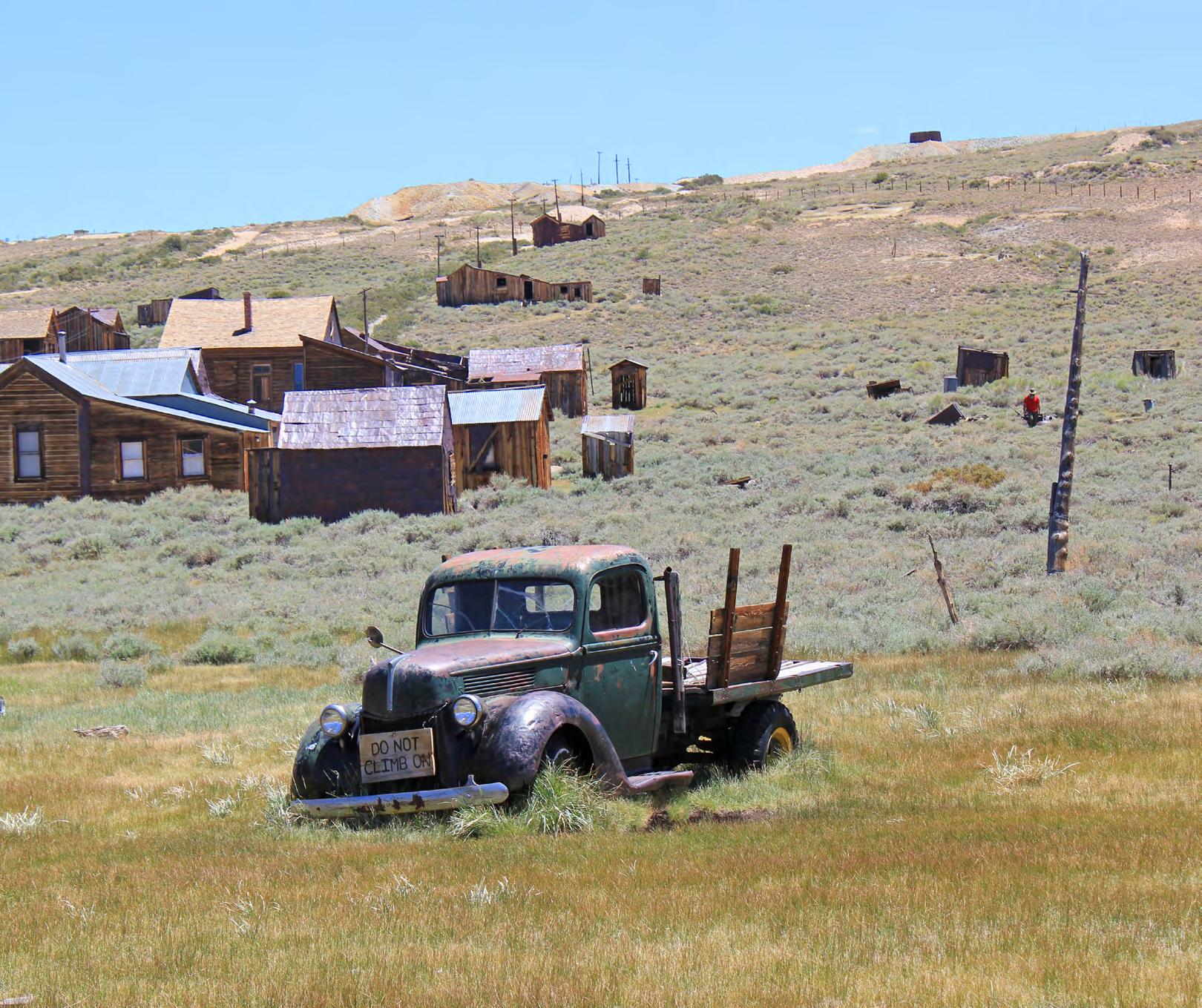
that did not exist. That really caused the population to go up and it snapped back down … from that initial rush. A lot of people that came here did not participate in the gold mining. Once the excitement calmed down, it quickly fell apart.”
During the town’s peak, there were 30 different mines — the Standard Mill being the most successful — five newspapers, including four dailies, a Bodie baseball team, a Methodist and a Roman Catholic Church, several stores, a narrow-gauge railroad called the Bodie Railway & Lumber Company, and many other enterprises making up almost 450 places of business and about 2,000 buildings. The fortunes of the town were riding high.
But the golden days were short-lived. Bodie’s gold reserves started to dry up. It became expensive to run and upkeep the mining machines. A few mines were abandoned, and people started leaving. A fire in July 1892 destroyed a large section of Main Street. Decline set in. By 1913, the Standard Mining Company ceased its operations, another proverbial nail in the town’s coffin that obliterated one of the town’s main sources of income. Residents started to flee en masse. Some left with only the belongings they could carry. Others just up and left, abandoning their homes, along with almost everything in them. The town’s population dwindled fast to a mere 800 people. By 1915, Bodie was declared a ghost town; a mere 30 years after its boom.
“Mining continued until about 1942 when the Essential Mining Act went into play,” said Silva. “That halted all gold and silver mining because you can’t build a warship out of
[those]. So, all the miners went off to iron and copper mines. After the war, in 1946, they tried to get the operation back up and running, but before they could, the mill burned down. 1942 was the last time hard rock really came out of the ground here and was processed for gold extraction.”
One of Bodie’s most prominent residents was James Stuart Cain. Cain had arrived in Bodie in the 1890s seeking fame and fortune. He was only 25. He started barging timber, took up mining, bought a bank, and ventured into real estate, eventually buying many of the properties around town. By the time mining ceased, Cain’s family owned a majority of the town. By 1920, the U.S. Federal Census recorded a total of 120 people. In due course, that number dwindled to three, with the Cain family hiring caretakers to look after the town’s buildings. Eventually the population dropped to zero. In 1962, the California State Park purchased the town from Cain’s family.
In 1962, Bodie became a Historic State Park and National Historic Site, with nearly 200 buildings from the town’s heyday still standing. Unlike other ghost towns, the Park does not aim to restore the buildings, but instead to preserve the wood and old relics in the state in which they were found.
Walking through the town, it is easy to picture Bodie at the peak of its boom town status, a step back in time to the days of the California Gold Rush. The town’s isolated location from the outside world helped preserve most of what was left. Everything is in what the Park calls a state of “arrested decay” where each building and the items in them have been left exactly as they have been since the residents up and left close to a century ago. Old utensils, cups and saucers are still on tables, calendars from the early 1900s are still on the walls. Scales and products from well-known brands such as Colgate, Kellogg’s, and Aspirin are still on shelves at the Boone Store and Warehouse. A peek through the windows of the schoolhouse reveals chairs, desks, and opened notebooks with layers of dust built up over decades, still intact. There is a somber, somewhat spooky
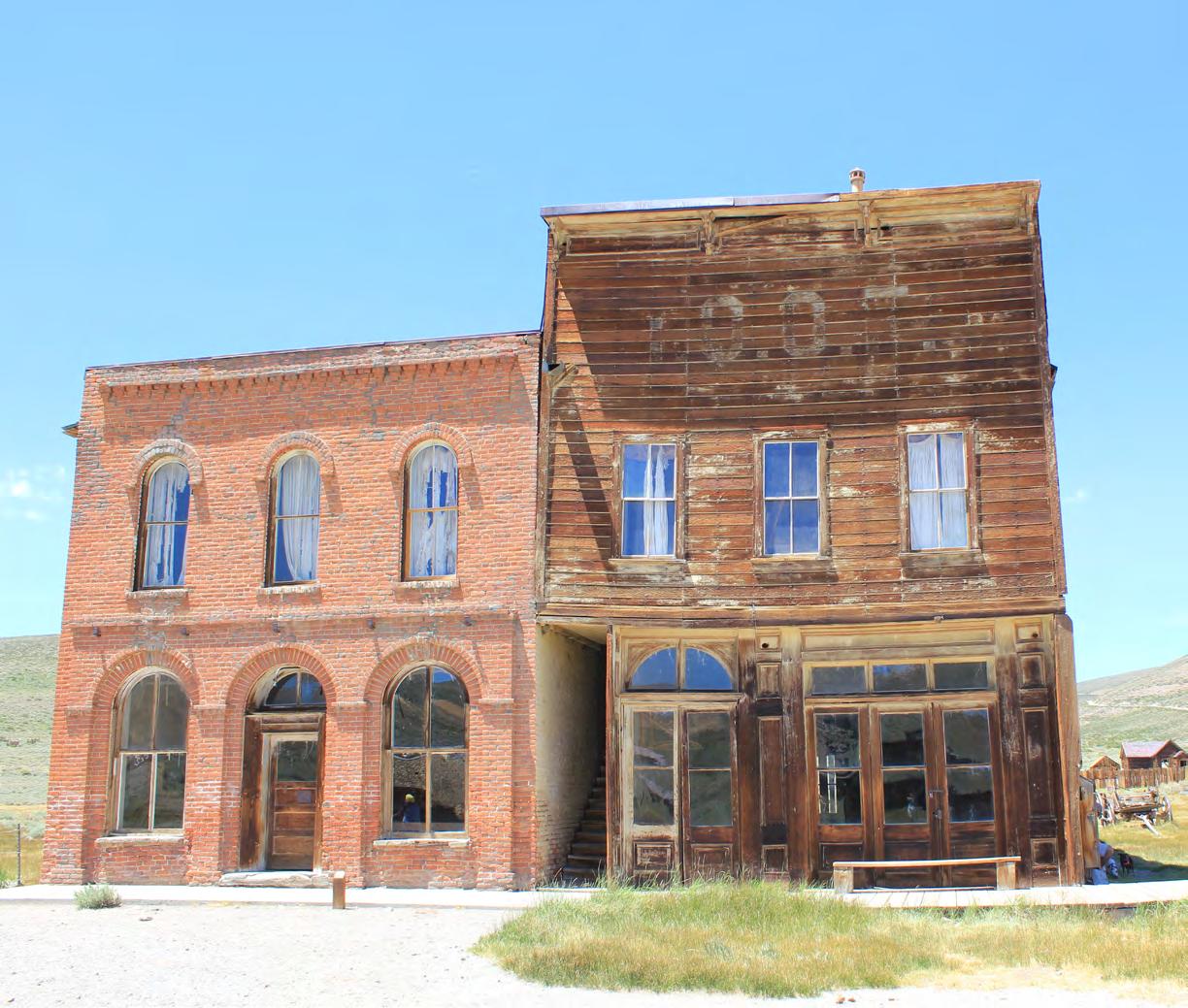
feeling, a sense of this pocket in time, with its memories, held silently still.
“The Boone store has a variety of products that rangers have found from the 1870s all the way to the 1850s,” said Silva. “You get to see products that people consumed during the duration of [Bodie] as a functional town. It’s fascinating to me because some of it is the garbage from the back of the store. Across the street from it is what had once been a department store, but then in later years it turned into a bar and hotel and a substation for the hydropower coming into the town. It really shows how these buildings were changed and adapted as demands changed for the town. People find Bodie more authentic because it’s not like other ghost towns that have a particular, overt commercial aspect to them,” Silva said.
“I always find it kind of funny, because back in the boom, that would’ve been the experience that you’d have with a massive commercial strip. Bodie [today] is about as far as you can get from that. But there is a particular beauty to watching buildings sit in arrested decay. The wood changes in the most stunning way. The textures of the town and the way that the furniture and objects in the buildings react to time has a particular beauty that I don’t know is mirrored in other ghost towns that have restored or ‘taken care of’ their things.”
The upkeep to the buildings is done by a core group of staff who work year-round. Re-roofing is done mainly during the summer, while in the winter, the staff focus on general maintenance to ensure that nothing disastrous happens. “The key to saving these buildings, in a lot of ways, is just keeping water out of them. There is so much work that goes into keeping these buildings upright. It is really a labor of love,” added Silva.
Each building tells its own stories, with weathered wood, old, discarded relics, and evidence of lives left behind. The town’s cemetery on the outskirts of Bodie contains even more history as it connects us to those who came before, whose remains have been forever left behind, and allows visitors to imagine the lives of those who dwelled in Bodie in the years that it flourished.
Today, the town lies down a bumpy slow 13-mile drive off of State Highway 395 in Mono County. Its preservation and authenticity offers people of all ages and backgrounds a chance to learn about the unique history of the United States and the Gold Rush period. While many ghost towns have fallen by the wayside, forgotten in time, Bodie State Historic Park allows us a chance to step into the shoes of the dreamers of the past, and to understand how their actions shaped both their society and ours, to this day.

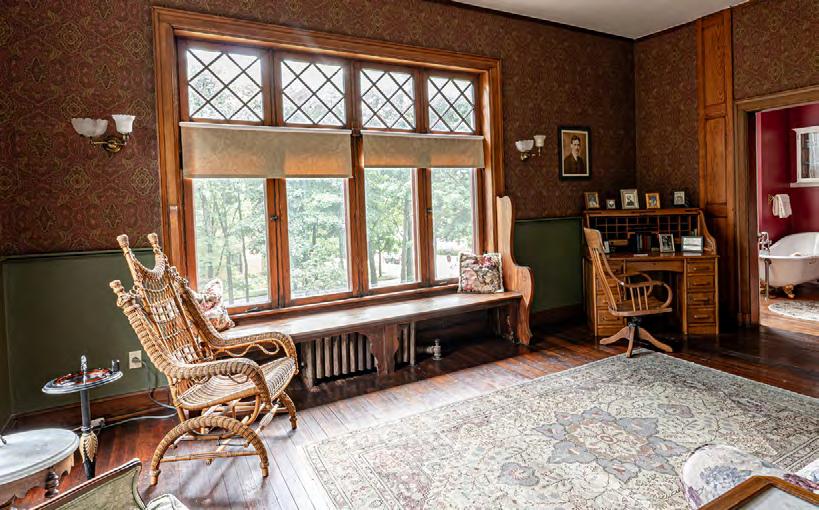

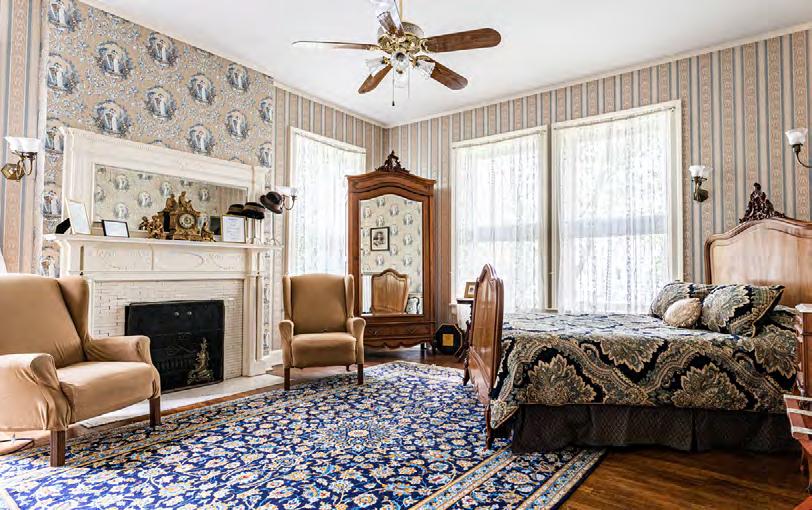


Built in 1869, the historic Vrooman Mansion is where vintage greets modern with vibrant majesty. Choose from 7 luxurious rooms featuring private baths, endless tea & coffee, free WiFi, and gourmet breakfast included. For an experience that leaves a lasting impression, don’t stay at a hotel. Stay in a Mansion. Book now and come make history.
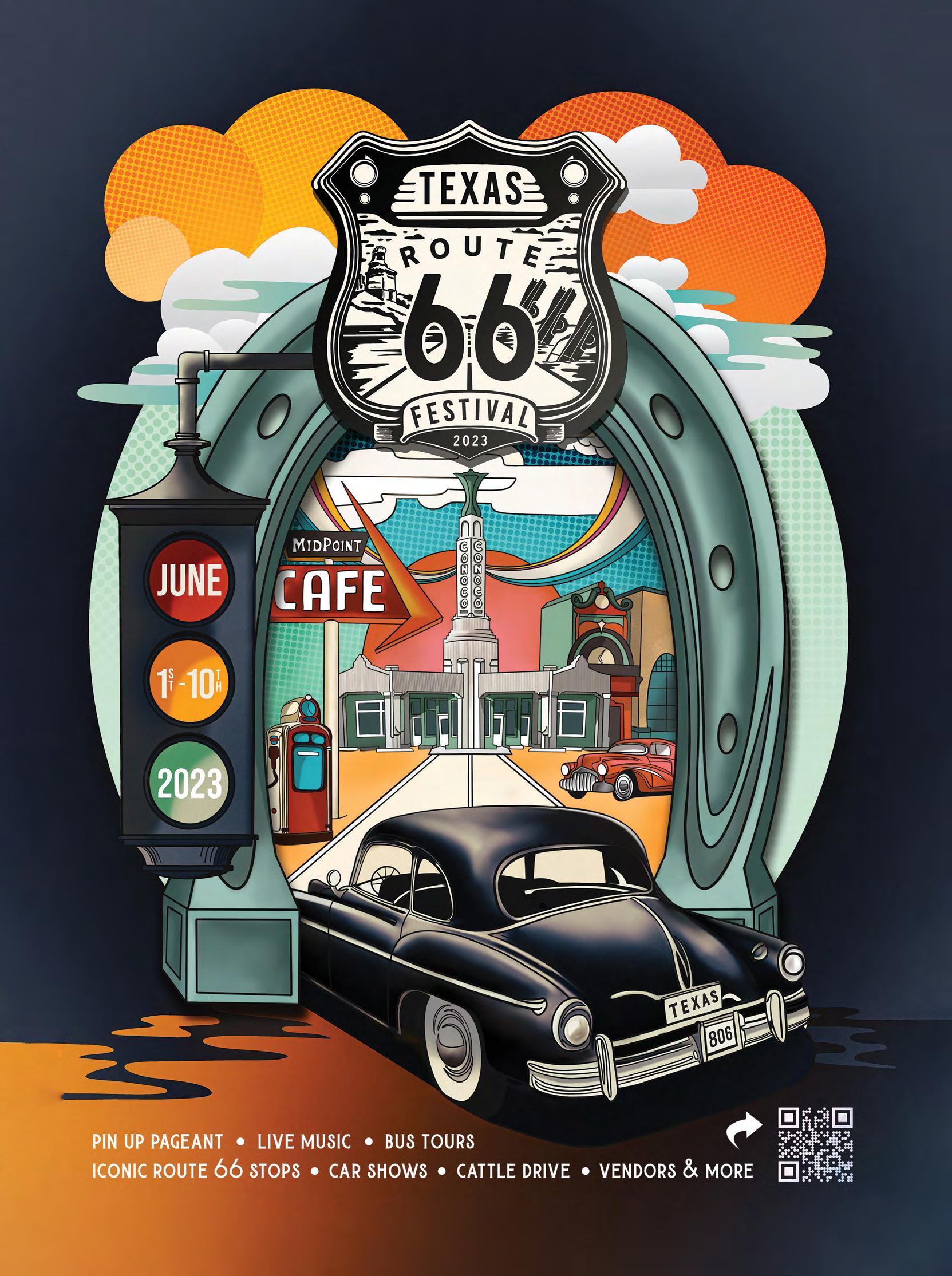



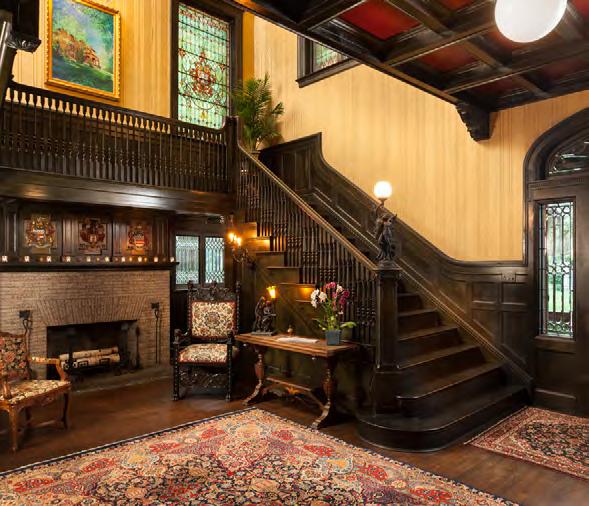
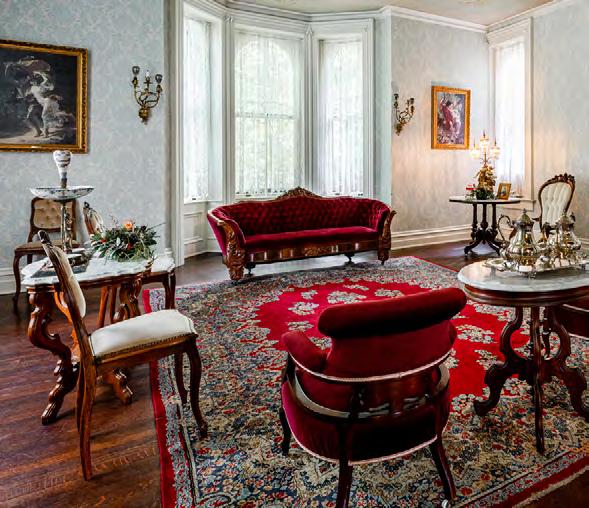

vroomanmansion.com
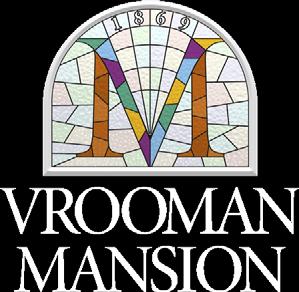


 Photograph by Jim Luning
Photograph by Jim Luning
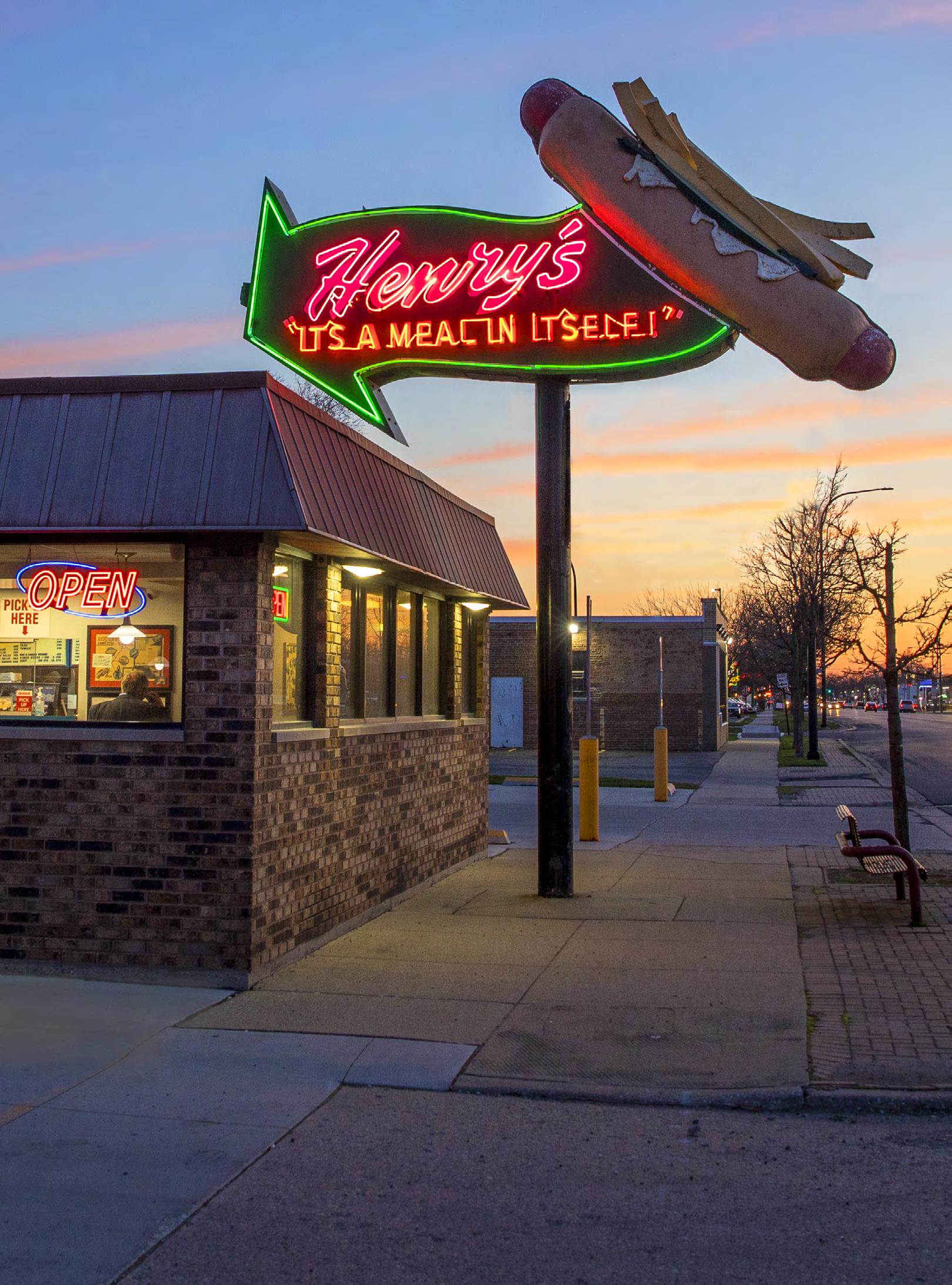
In the 1840s, German immigrants relocated to Midwestern farms and industrial cities like Chicago, Illinois, and introduced residents to one of their culinary traditions: the hot dog. These “dachshund sausages,” so referred due to their shape, consisted of beef, pork, and spices and were commonly eaten with bread. Hot dogs and Chicago, the meatpacking capital of not only the United States, but the world, were a match made in culinary heaven. Granted, Chicago is also well known for its deepdish pizza, but the hot dog came first — by 100 years. Jewish immigrants, following their dietary law, and recognizing the questionable health standards of Chicago’s meatpacking industry, nixed the pork and began to produce all-beef kosher hot dogs. The business savvy immigrants started selling the kosher dogs on carts throughout the industrial city, and residents quickly fell in food-love. Not only were hot dogs inexpensive, but they can be eaten on the go, which fit the city lifestyle perfectly.
Hot dogs became even more popular during the Great Depression, a bleak period in United States history from 1929 until 1941. Nicknamed a “depression sandwich” or a “depression dog,” vendors topped hot dogs with various vegetables, which were cheap, filling, and nutritious.
The traditional Chicago-style hot dog is a steamed, beef hot dog with celery salt, mustard, pickled serrano peppers, diced onion, relish, tomato wedges, and a dill pickle spear on a poppy seed bun. In Chicago, if customers, aka tourists who don’t know any better, request ketchup on their hot dogs, they may be given the side-eye.
Regardless of condiments, it didn’t take long before hot dogs became popular in the Chicago suburbs, collectively called Chicagoland. The suburb nearest to downtown Chicago is Cicero, which in 1848 became the first western suburb connected to the city by rail. Cicero has a rich history, including that of Chicago gangster Al Capone and his mobster buddies wreaking havoc on the once peaceful town during the 1920s. Cicero is also well known for its location on Route 66 and its colorful roadside attractions, including the Shamrock Motel, the Cindy Lyn Motel, the Castle Carwash, the original site of the hot dog holding Muffler Man (now in Atlanta to the south), and of course, Henry’s Drive-In.
William (Bill) Henry, who founded Henry’s Drive-In, was born in Winamac, Indiana, in 1912. In 1937, he married Violet Arandarchek, and the couple lived on the west side of Chicago before moving to Cicero. Although Henry worked at Crane Manufacturing, he clearly had an entrepreneurial spirit. In 1946, he sold hot dogs from a food wagon on Austin Boulevard until he was able to purchase property at the corner of Ogden Avenue and 60th Court in 1950.
The original diner was a red brick building with six outdoor stools and walk-up windows. Simple signs on the roof featured menu items, including hotdogs, French fries, chocolate malts, hot tamales, and beef barbeque.
A couple of years later, a McDonald’s opened nearby. The chain was new to the nation and was about to begin growing quickly. To stay ahead of the competition, and in a make or
break marketing move, Henry added ceramic stripes to the building and a green neon sign that said, “Henry’s…“IT’S A MEAL IN ITSELF,” attached to a giant hotdog topped with French fries. The elaborate neon sign made Henry’s instantly recognizable, cementing the diner as an iconic Route 66 landmark.
The Henrys ran the business along with their three sons (William, Robert B., and Donald). When Henry retired in 1970, his son Robert B. took over. Like his dad, Robert B. ran the business along with his wife, Lorraine, and their three children (two daughters and a son). His son, who is also named Robert, vividly remembers cutting pickles, mopping floors, and serving the daily lunch rush, which was their busiest time of day.
“I’m not sure whose idea it was to top the hot dog with fries, I just liked having a hot dog, but without the hot peppers,” said Robert.
Between 1982-83, Robert helped design a new layout for the restaurant. A new addition was built, which included a foyer, booths, and a walk-in cooler. Stools and a counter were removed which provided more space for the customers. During a windstorm in the late 1970s early 1980s, the original signs on the roof blew off and were not replaced.
In 1990, with his children all pursuing their own dreams and ventures, and not having anyone to take over, Robert B. Henry decided to sell the diner and retire to the state of Wisconsin. “We all decided to pursue other careers and job paths. Only one of my sisters still lives in the area, actually in Joliet, in between the two alignments of 66. The other lives in Idaho and I currently live in Wisconsin,” added Robert. “I can say that sometimes [my dad] regrets selling it, but he wanted to leave the Chicago area, and this was just before the renaissance of the route and the posting of the Historic Route 66 signs in Illinois.”
Henry’s Drive-In was purchased by Anthony Rotolo, who once owned a hot dog restaurant called the Dog Hut, and currently owns an ice cream shop called The Freeze (formerly known as Tastee Freeze).
Henry’s continues to be a family-run eatery — Anthony’s sister, Sue Biernacki, helps manage the business, his mother, Florence helps out as much as she can, and his daughter, Nicole, an assistant school principal, also works at the restaurant.
“When my dad was a kid, his family visited Henry’s DriveIn a lot and were close with the Henry family,” said Nicole. “Mr. Henry asked my dad if he wanted to buy the business from him. The goal is for me and/or my brother, Anthony, (AJ) to run it in the near future.”
What began as a small simple roadside hotdog stand became legendary as the only surviving diner still in business on Cicero’s stretch of Route 66, where its hotdogs continue to be “a meal in itself.” Henry’s has continued to welcome locals, global travelers, and even celebrities, including Joe Mantegna from Criminal Minds , Tim Allen from Last Man Standing, and Bob Odenkirk from Better Call Saul , offering a simple hand-held meal and a nostalgic trip into classic Americana, just as they have been doing for nearly 80 years.

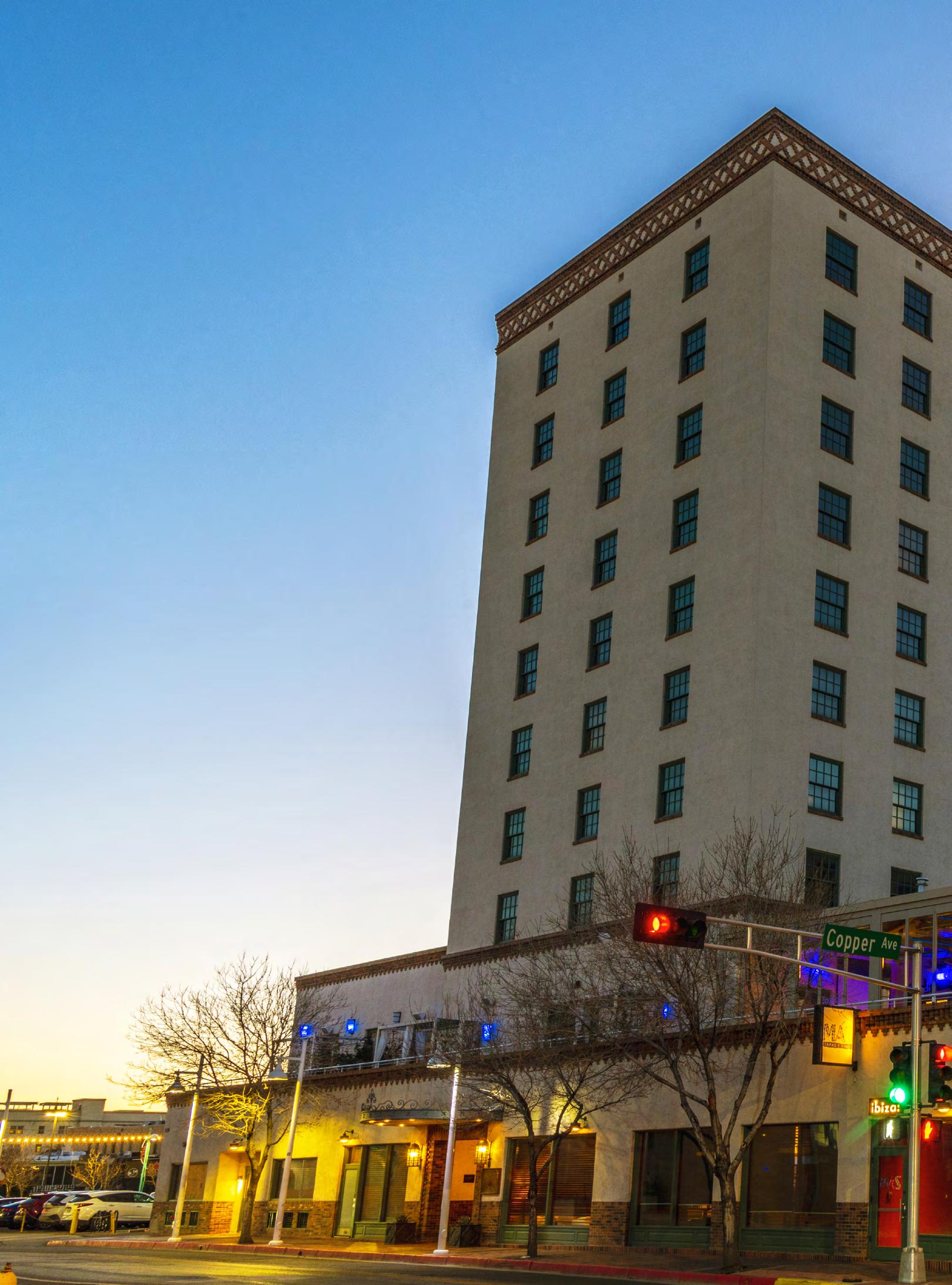
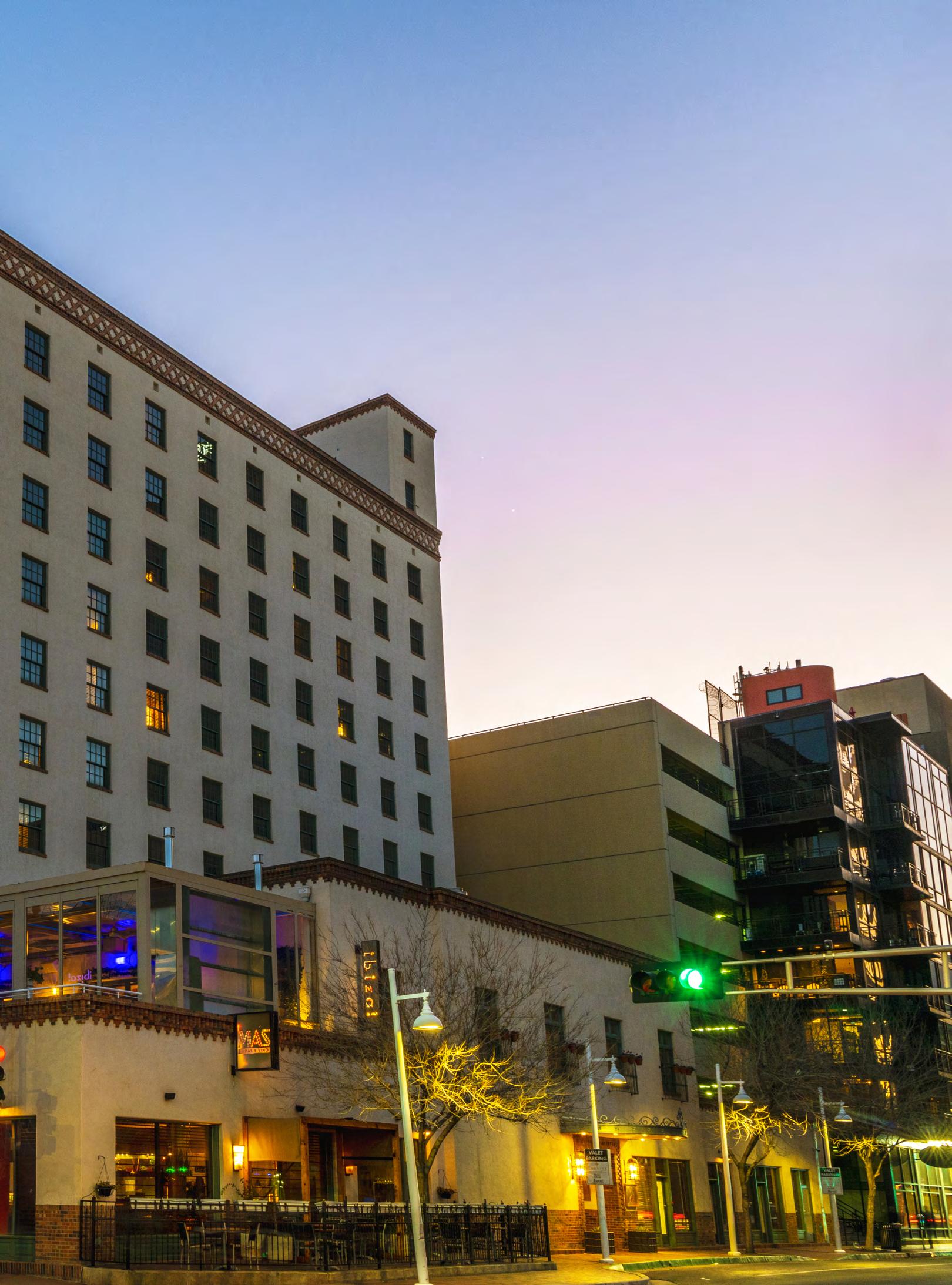 Photographs by Efren Lopez/Route66Images
Photographs by Efren Lopez/Route66Images
he beauty of a Route 66 adventure is being able to do it your way. Dates, distances, destinations, and details are discretionary, meaning that no one person has to conform to anyone else’s expectations or norms. There are mom-and-pop diners, but there are also fancy, elegant restaurants along the way. There are vintage roadside motels, but there are also historic hotels.
Regardless, it is an experience that can be crafted as the traveler and their pocketbook decide. Mid-century cafes and quaint motels where you can park in front of your room? Or white linen and fancy place settings followed by posh, top shelf digs more typical of Route 66’s early years? Either way, each is a legitimate option.
It is the latter path that in 1939, an unwitting hotelier found himself building an impressive hotel in downtown Albuquerque, New Mexico, only one block north of Route 66.

The Dust Bowl was winding down, and the flow of refugees passing through had subsided. The nation was able to catch its breath, if only for a brief moment, before finding itself plunged into war. It was a time when America had reached a transition point, when roadside motels started to gain traction, and landmark downtown hotels had already reached their zenith. And it was into this landscape that Conrad Hilton opened his first non-Texas based hotel on the corner of 2nd Street NW and Copper. Today, Conrad Hilton’s contribution to lodging in the center of the Duke City is still standing, beckoning travelers, just as it has for nearly 85 years.
Conrad Nicholson Hilton was born on Christmas Day, 1887 in San Antonio, New Mexico. Unlike its namesake a state to the east, this San Antonio is much smaller, and numbers only nine residents today. It is no boast to say that Hilton is the town’s most celebrated child.
While his childhood may have been unremarkable, at least given the dearth of information about his earliest years, it did not take long for young Conrad to cut his teeth in both business and politics. By the age of 21, he had taken over his father’s general store in nearby Socorro — both towns are located in the Rio Grande Valley — a little more than an hour south of Albuquerque.
Then from 1912, with statehood just bestowed upon New Mexico, Conrad was elected as a Republican representative in the state’s first legislature. It did not take him long to become disillusioned with the inside deals of that world and he quickly resigned from politics. Hilton was then off to do his part in World War I in the U.S. Army, and upon his return stateside, went to New Mexico for a brief time. With his military, political, and commercial experiences packed alongside his personal effects, he set off for Texas in 1919, at the height of the oil boom, to find fortune and fame, something he felt he could do by purchasing a bank.
TAnd perhaps he would have found this deeply desired success, however, fate dealt him a very different card upon his arrival in the Lone Star State.
“Originally, he was planning to buy a bank in Cisco, Texas, to capitalize on the oil boom there, but instead he bought the modest Mobley Hotel and quickly transformed it into a reliable money maker,” said historian Brian Ingrassia. “From those small beginnings, Hilton later built the world’s first international hotel chain and created an enduring hospitality brand.”
Business was so good and demand so high that Hilton converted the 40-room Mobley Hotel’s dining room into additional accommodation. He soon added more hotels to his fledgling enterprise: the Dallas Hilton, in 1925 — the first to carry the Hilton name — the Abilene Hilton, in 1927, the Waco Hilton, in 1928 — the first to have cold running water and air conditioning — and the El Paso Hilton, in 1930. In 1925, he married Mary Barron, with whom he had three sons: Conrad Nicholson “Nicky” Hilton, Jr., William Barron Hilton, and Eric Michael Hilton. The Great Depression then befell the nation, and nearly took Hilton’s hotels with it. He hung on for dear life, and while he suffered significant financial losses like so many other firms of the day, he managed to build on the foundation that he had first laid with the Mobley.
The stresses of the time, though, certainly weighed heavily on his family life. He and Mary divorced only nine years into their marriage. Undeterred, Hilton soldiered on. In 1939, he ventured across the state line to build his first Hilton hotel outside of Texas, in downtown Albuquerque, just steps from America’s Main Street. His firm belief that each hotel should be unique and not follow a cookie cutter formula ensured that each property offered something special to travelers.
While the U.S. and its allies were focused on another world war in the early 1940s, Hilton had his eyes on Hungarian actress Zsa Zsa Gabor, whom he married in 1942. They stayed in a flashy 10th-floor room at his Albuquerque property that would one day become known as the Zsa Zsa Suite. There are uncertainties as to whether they stayed there before or after their wedding, but one thing is certain: they enjoyed the hospitality for which Conrad had already become renown.
Their union, which was perfectly apropos given their statures, produced a daughter, Constance Francesca Hilton, but sadly, the marriage only lasted four years. The same year, 1946, he formed the Hilton Hotels Corporation, which soon found the famed Waldorf Astoria under its umbrella in 1949.
Shortly afterward, with World War II in the rear view and domestic economic growth at unprecedented levels, Hilton decided to expand beyond the U.S. border by growing internationally. He renamed the business Hilton International Company. He even extended his prowess into credit cards and car rentals. Hilton was an entrepreneur at heart and understood the role — and influence — of money.
“We might think of hotels merely as places to house people, but we can also think of them as structures designed to extract capital from travelers, or even the temporarily homeless. Conrad Hilton knew this,” Ingrassia continued.
By the 1960s, Hilton was ready to go into semi-retirement, and handed over the reins to his son, Barron. He remained on as chairman of the Board, though. Much later in life, in 1976, Hilton married a third time, to Mary Frances Kelly. This marriage, though, was the shortest of his three. Hilton passed away in 1979. At the time of his death, 3600 hotels worldwide bore the Hilton name in one way or another. That was quite a success story.
“Hilton was such a pioneer. When you look back over the history of Hilton Hotels, you see the things that have been done over the decades,” said Phillip Snyder, former General Manager at the Andaluz. “He introduced room service. He introduced the airport hotel. When you start going back at everything he did, he changed the industry multiple times.”
When the Hilton Hotel in Albuquerque opened in 1939, it had a trio of superlatives behind its name. At ten stories, “It was the tallest building in New Mexico, the first one with an elevator, and the first one with air conditioning,” said Misty Jester, Director of Sales at the venue. “This was Conrad Hilton’s fourth property [that he built himself]. The hotel has always been the cream of the crop for the city.” It cost $700,000 to build ($15.3 million today), and originally had 176 rooms.
Inside and out, the hotel’s architecture and decor were inspired by the Andalusian region of Spain, the southernmost portion of the nation that borders the Mediterranean.
Moorish influences abound, reflecting the cultural flourishes of that region.
“When the hotel was designed it was modeled with a Spanish-Moroccan influence. The bottom floor is the gathering area, where people celebrate and come together,” Snyder continued. This Spanish influence is only fitting in a city named both for Spain’s Duke of Alburquerque as well as their tiny town of Alburquerque. The two “Rs” is no mistake, but the city in New Mexico eventually dropped the first of the two.
The hotel brought glitz and glamor to downtown Albuquerque and became a place to see and be seen, entertaining the likes of Lucille Ball, James Stewart, and of course Zsa Zsa Gabor, among others. The Hilton name remained on the property until 1969, when it was sold and renamed Hotel Plaza. This lasted for a dozen years when it was resold and rebranded as Hotel Bradford, although it never opened. A couple of years later, the hotel was sold to Southwest Resorts, who embarked on a comprehensive renovation. They reduced the room count to 114, four of which were suites. It reopened in 1984 as La Posada de Albuquerque (“The Resting Place,” and no relation to other hotels in the southwest bearing the same name). That same year the property was placed on the National Register of Historic Places.
In 2005, the hotel once again changed hands, purchased by real estate developer Gary Goodman who undertook a $30 million renovation that recovered and retained some of the authentic features. In 2008, it was christened Hotel Andaluz,
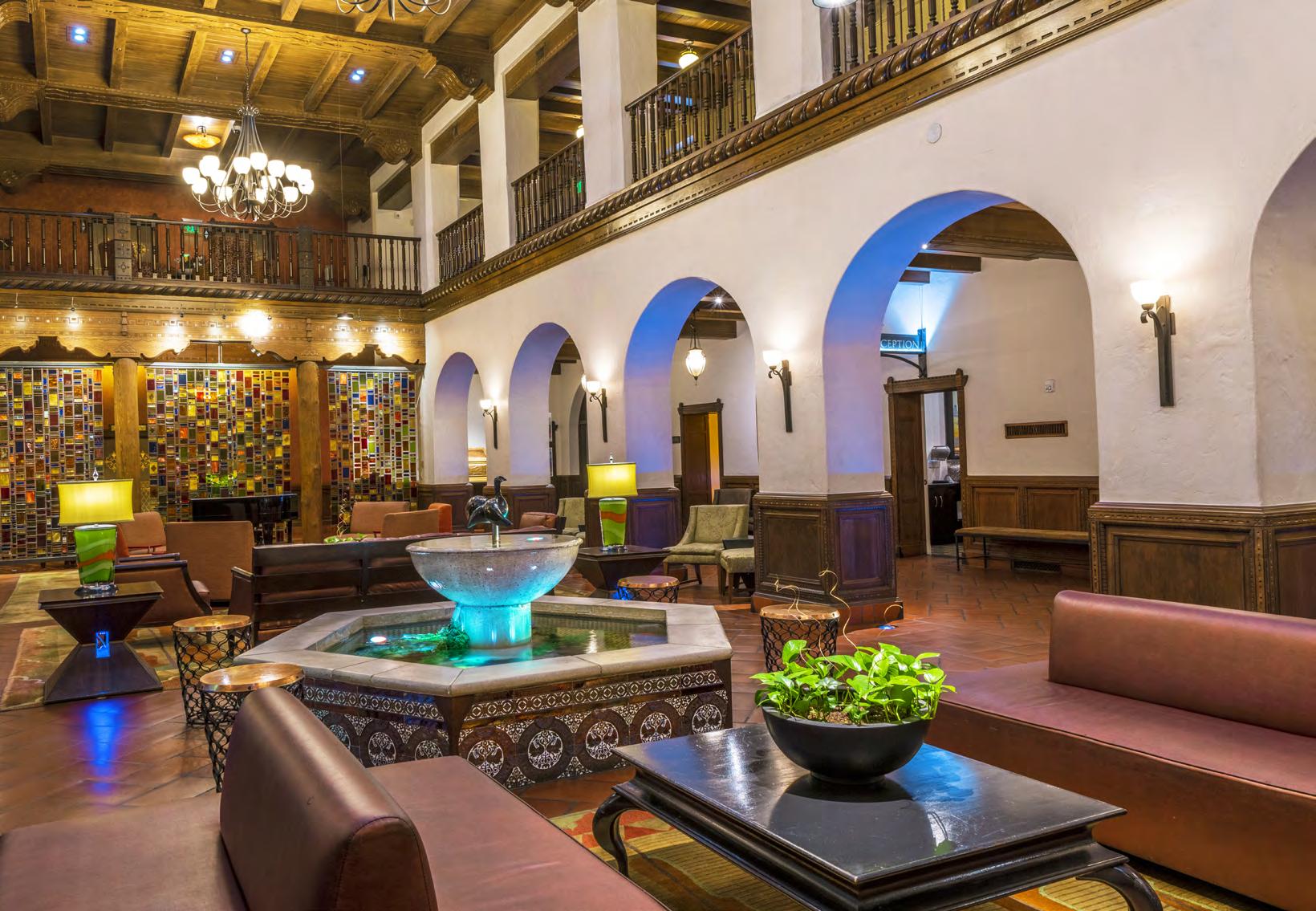
a tribute to its Spanish heritage, and officially reopened in 2009. A decade later, in a full circle moment, Hotel Andaluz once again came under the Hilton umbrella, its full name now Hotel Andaluz Albuquerque, Curio Collection by Hilton. More recently, the hotel was sold to Legacy Development in November 2022.
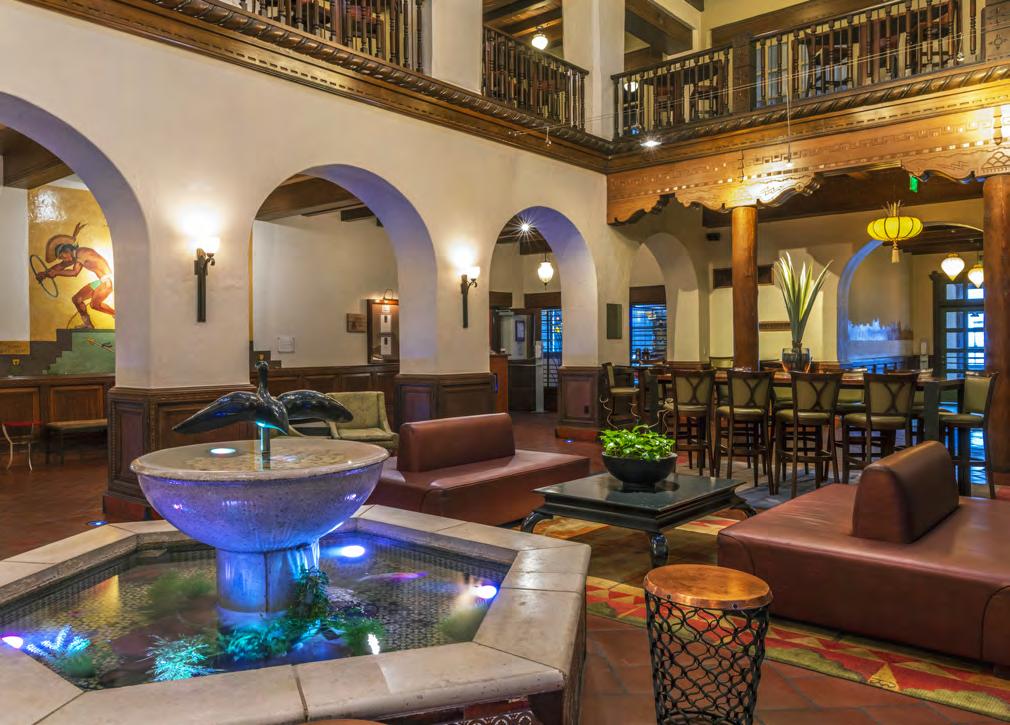
Over time, the property has continued to evolve and be reconfigured. “The hotel has 107 guest rooms and 7200-square feet of meeting space. The rooftop bar, the lobby bar, and the individual casbahs on the first floor are all appealing,” noted Jester.
The Curio Collection is Hilton’s rarified air, as it is ensconced comfortably beneath only a handful of other Hilton properties, like the Waldorf Astoria in New York and the Conrad Hilton in Chicago. It is an honor that management does not take lightly.
While the property had changed a lot over time, its legacy and the grandeur of the building have never faded. “There is so much history to the hotel. It is part of Albuquerque’s history,” Snyder remarked. Better yet, the hotel today is a modern rendition of Hilton’s original. Environmentally friendly nuances have been added that may not be visible to the average guest. “Andaluz was the first Gold-LEEDcertified hotel in the nation,” said Snyder. LEED stands for Leadership in Energy and Environmental Design, and Gold status is an honor bestowed only upon a few.
No story about a historic hotel is complete without ghost tales, and Hotel Andaluz does not disappoint. It’s almost as if this were a chapter in a basic Hospitality Marketing textbook, a vital component in any hotel’s marketing plan. To satisfy public curiosity, there are a number of organized ghost tours in Downtown Albuquerque and the Old Town area, and Hotel Andaluz is typically included on the list. Furthermore, management does not shy away from a good story, and happily shares with clientele what it contends to be the most vital elements.
“I have heard quite a few,” said Jester. “One lady came into my office and said, ‘I just have this really weird feeling…’ She obliged the woman by listening, before
swapping ghost stories with her. “It’s all kind of fun, but sometimes you worry about saying things about these stories. Most people, though, are like, ‘Heck yeah, I’m ready’.”
As with many ghost stories, details are sketchy and often differ from one telling to another. But perhaps the most popular tale from Hotel Andaluz centers around a young girl who frequents the property, specifically appearing on the 2nd, 4th, and 9th floors, with reports of people who have actually seen her, spoken to her, and seen her come down to the lobby. The story goes that there was a fire or explosion of some sort downstairs many years ago, and it killed three people, two of which were adults, and one was the little girl. Now she haunts the hotel, perhaps forever stuck in the walks of the iconic venue.
Another rendition tells that, before the hotel was built, there was supposedly a horse stable on the land, and there was a fire that blazed out of control from a coal stove, killing the family who resided in the home. The tale includes a little girl named Emily, and a gentleman assumed to be her father. This man is apparently known to wear a black suit and black top hat and hide in the basement. The father/daughter duo harken back to a time long before Hotel Andaluz, occupants of the land in a much simpler time.
These tales add to the allure of a night in a historic hotel, regardless of their veracity. No charge for the added intrigue.
When Conrad Hilton built what is known today as Hotel Andaluz at the close of the decade, it was sort of a homecoming for him. While 20 years had elapsed, he had honed his skills in hospitality, and his already respected name was well on its way to being renowned. That his New Mexico masterpiece be located so near Route 66 was almost divine providence.
“The property itself is unique and full of history. It is one of the few properties you can go into and learn how it has been connected to the city throughout the years,” Snyder reflected. “The associates know all of that history and share it. It creates a historical destination in itself.”
And just as previous new owners took the time to conduct renovations, the current owners are about to engage in their own. It’s all part of keeping the hotel relevant, but more importantly, to keeping it true to its origins. Stylistic drift happens without conscious thought sometimes, as evidenced by Conrad and Zsa Zsa’s nuptial nest having been renamed the Penthouse Suite.
“When we are renovating the property [later this fall] and returning its historic nature, we’re going to rename it the Zsa Zsa Suite,” Jester added. “It’s been since 2009, since the last renovations. It’s time for a bit deeper dive.”
And were Mr. Hilton alive today, he would no doubt smile at the preoccupation with detail and commitment to history, as he himself valued such aspects. The efforts afoot in 2023 will ensure that guests will enjoy a night in the Duke City for many years to come, just the way he planned it: YOUR way.
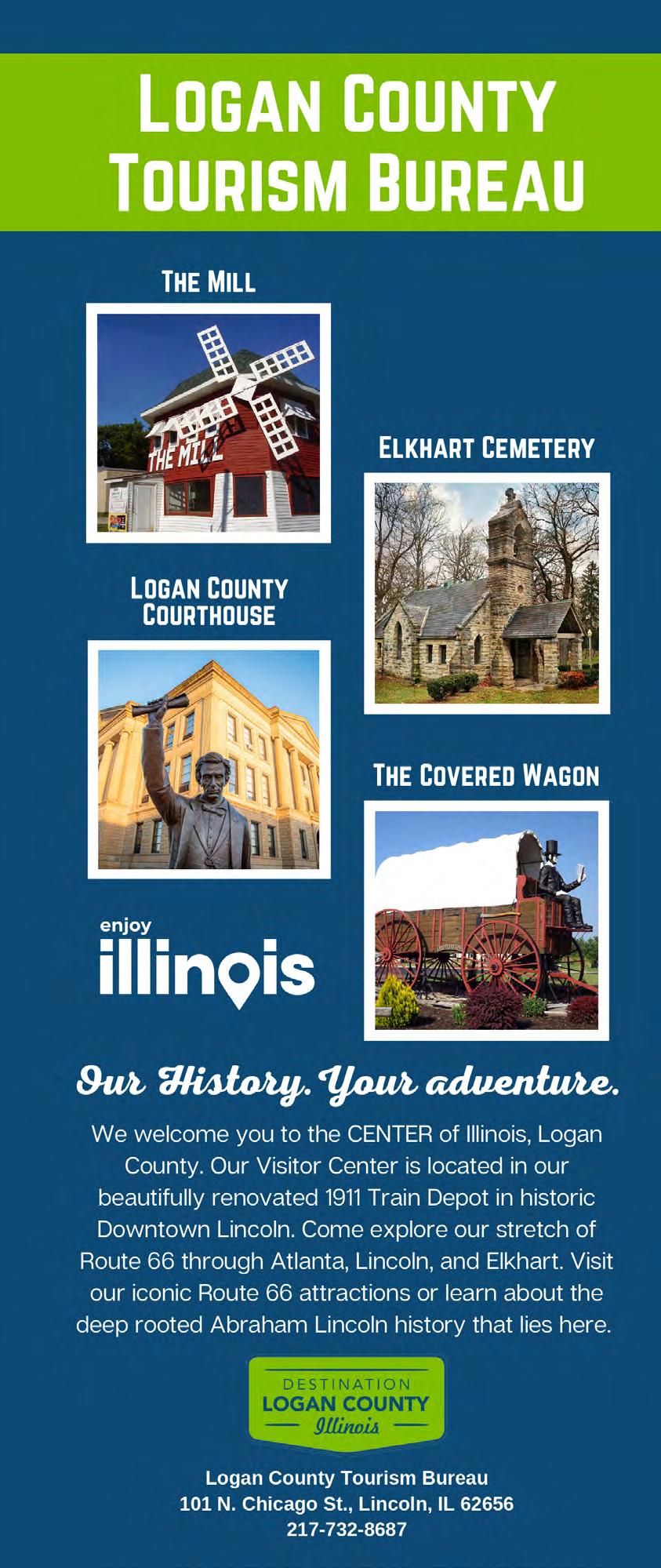
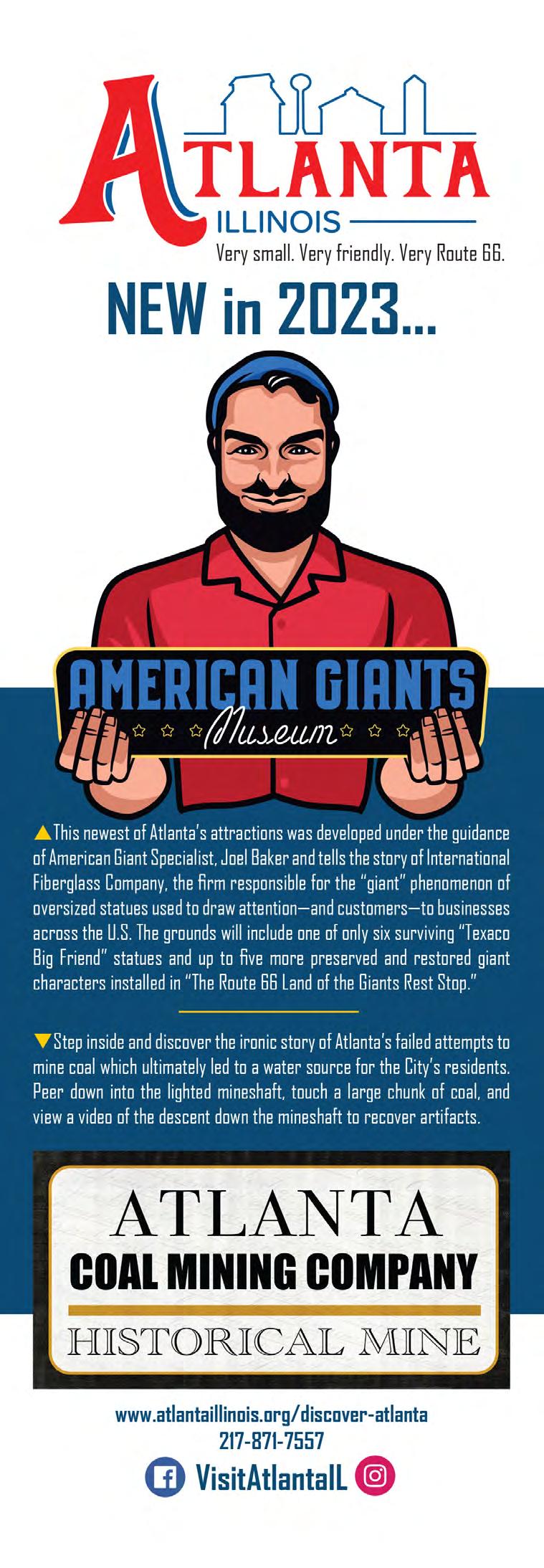



























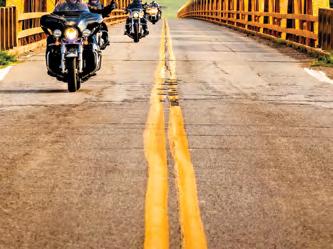














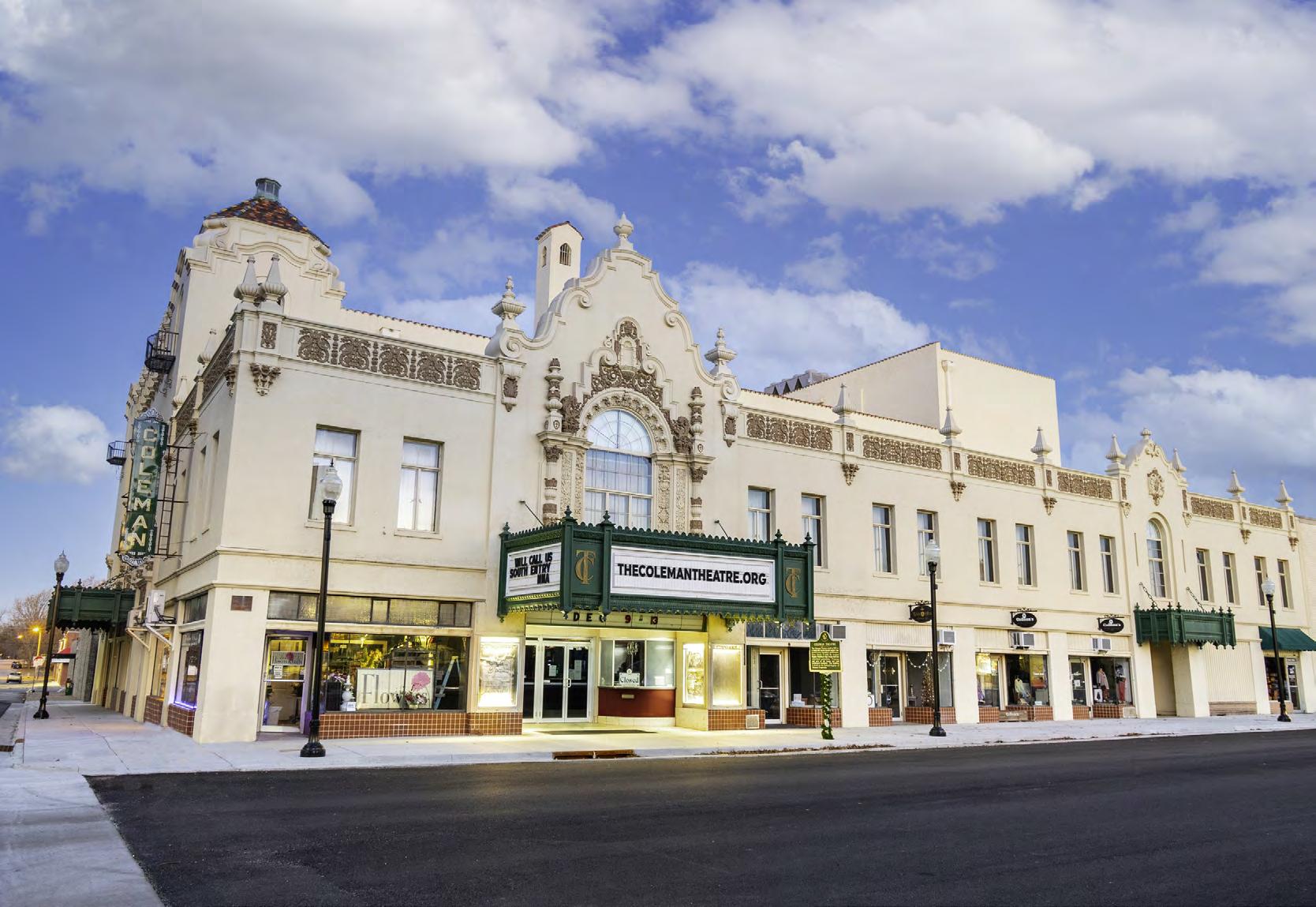

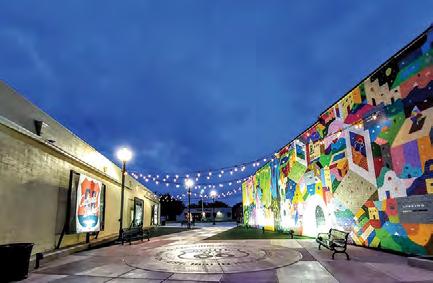
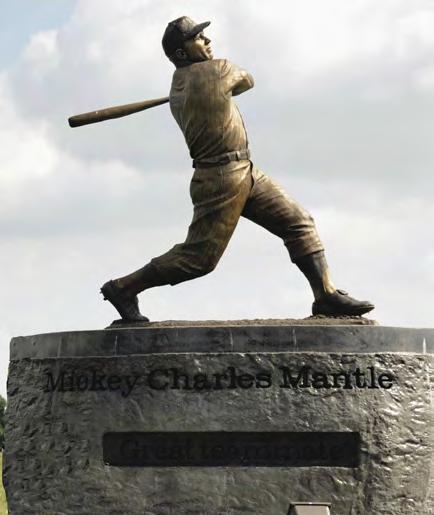
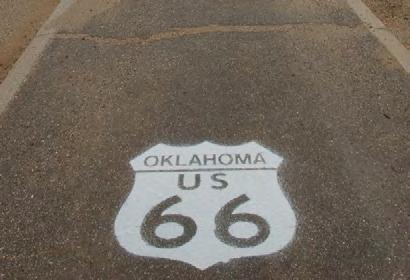




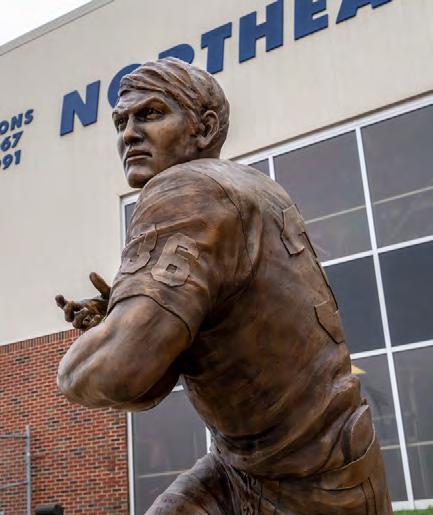






particular jail sits in the middle of the village of Gardner, Illinois. It’s one that onlookers and weary travelers make an effort to see with their own eyes while traveling along Route 66. Is it because it has a dark and lurid history? Not exactly. Does it have a long list of notable past inmates? Not particularly. Quite the opposite actually, this is Gardner’s famous Two Cell Jail. It’s a quaint little lockup that charms those who come across it. For nearly sixty years, its compact size has made it a popular tourist site and photo opportunity for travelers along the Main Street of America.
The Two Cell Jail was commissioned on July 1st, 1904, through a joint effort between the village of Gardner and the Hunter Lumber Company. It was agreed to be completed by August 10th with a construction budget of $550. It’s a minuscule amount by today’s standards, but when accounting for inflation, it calculates to roughly $19,000. They met the deadline, developing the sixteen-by-twentyfoot building with concrete floors, walls, and a wooden ceiling. The choice to use concrete was likely due to the town’s previous jail being burnt to the ground by a town drunkard who set it on fire with a mattress, which is ironic, considering that the former jail was located behind the village fire department.
While a jail is certainly a necessity in a community, Gardner, incorporated in 1867, has never been known to have a notable crime wave. It didn’t even have a police officer until Mike Likeness was appointed its first in 1898. “In the time I’ve grown up in Gardner, there’s always been only one officer in the town,” said Tom Perkins, Village historian and owner of The Shop on Route 66. “Nothing great or violent ever occurs around here besides the occasional kid speeding down the street.” The year that the jail was built, Gardner had roughly 1,000 people living in the community. Most of whom were farmers and miners. Any grand expectation of high-profile criminals like John Dillinger or “Pretty Boy” Floyd was not in the cards for the town.
Even calling it a jail is somewhat of a misnomer. “It was mostly used by the vagrants that would get off the train into Gardner. They didn’t want them roaming around at night, so they would put them up so that they would have a place to sleep,” said Perkins. “I don’t think it was ever a question of major crime; I think it was just in case that they needed a place to put people. It wasn’t a cowboy shoot-out town; it was a farming and mining community.” If it were necessary to lock someone up for criminal charges, they would be taken to the county jail in Morris, Illinois.
By 1951, the tiny prison was shut down as a functioning jail, and for an extended period of time, it was used as a storage facility for odds-and-ends items like the town lawnmower. That was until May 1970, when it was renovated. “The Gardner Junior Women’s Club restored the building as a historic preservation project. The inside walls were cleaned and redone by local plasterers. The old roof was replaced, new wiring installed, and a little potbelly stove was put in for authenticity,” said Deborah Steffes, Curator of Grundy County Historical Society & Museum. Whether intentionally or coincidentally, the restoration timing turned out to be ideal for catching the attention of travelers along the Mother Road.
The jail breathed new life into the small Illinois town as its popularity with Route 66 travelers grew. It’s estimated that the village now gets around 20,000 visitors a year who come from all over the world. Possibly the most famous visitor of the jail to be documented was Paul McCartney. Back in 2008, when he did a tour of Route 66 on his 66th birthday, McCartney stopped in to see the jail and even signed their guestbook. You’re unlikely to find the page, however, because it was promptly stolen sometime after. Even though the jail is one block south of where the historic road passes through Gardner, it’s become a staple of the town, where, to this day, people take the long way around to catch a glimpse and a photo of the miniature detention center. Route 66 really has always been the road of the unexpected.
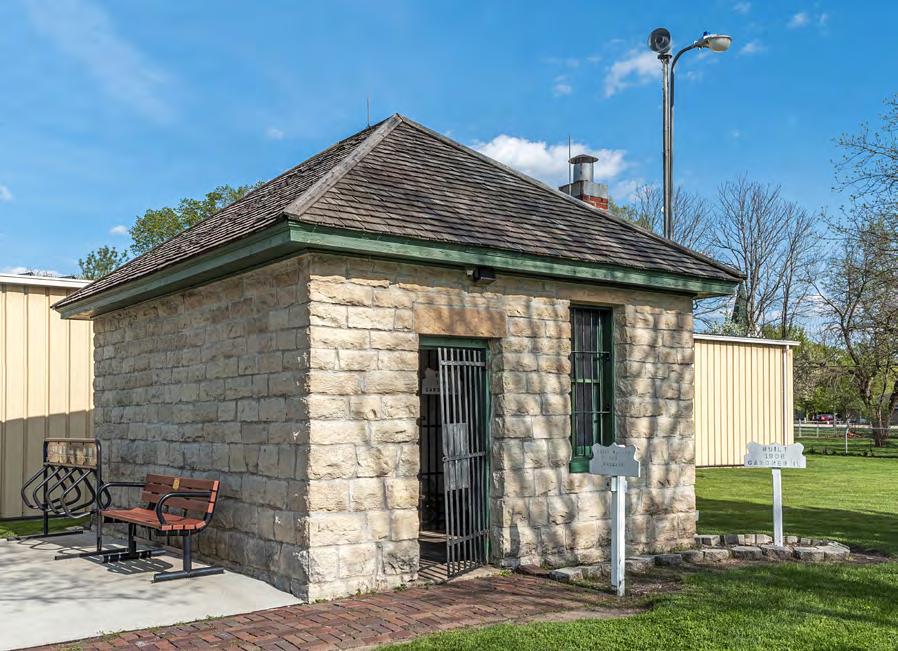


“In telling the story of his African family’s journey on Route 66, Brennen Matthews has made an important contribution to the legacy of the highway. He offers both a new voice and a new look at the Mother Road.”
—from the foreword by Michael Wallis, New York Times bestselling author of Route 66: The Mother Road
“Hop in and buckle up. Brennen Matthews’s Miles to Go is a ride you won’t soon forget.”
—Richard Ratay, author of Don’t Make Me Pull Over! An Informal History of the
Family Road Trip“Miles to Go awakens fond memories of my many road trips by car and Greyhound bus along the ‘Mother Road,’ Route 66!”
—Martin Sheen

“In Miles to Go, we don’t just drive the highway looking out the window. We stop, interact with people, and learn things we were not expecting. . . . This Route 66 journey doesn’t just immerse us in the sights, sounds, and experiences of the road. As guests on the journey, we’re encouraged to think about what it means to live in America and be an American.”
—Bill Thomas, chairman of the Route 66 Road Ahead Partnership
Miles to Go is the story of a family from Africa in search of authentic America along the country’s most famous highway, Route 66. Traveling the scenic byway from Illinois to California, they come across a fascinating assortment of historical landmarks, partake in quirky roadside attractions, and meet more than a few colorful characters.
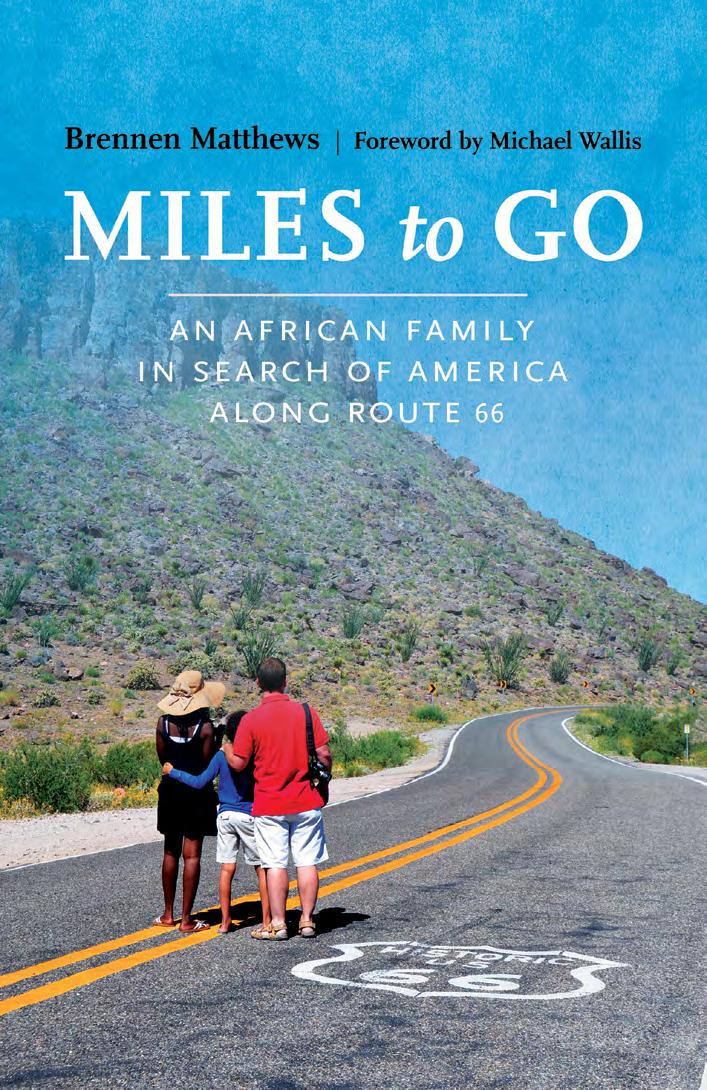
Brennen Matthews, along with his wife and their son, come face-to-face with real America in all of its strange beauty and complicated history as the family explores what many consider to be the pulse of a nation. Their unique perspective on the Main Street of America develops into a true appreciation for what makes America so special. By joining Matthews and his family on their cross-country adventure, readers not only experience firsthand the sights and sounds of the road, but they are also given the opportunity to reflect on American culture and its varied landscapes. Miles to Go is not just a travel story but a tale of hopes, ambitions, and struggles. It is the record of an America as it once was and one that, in some places, still persists.
VISIT AMAZON.COM AND ORDER A COPY OF MILES TO GO NOW AND JOIN BRENNEN MATTHEWS AND HIS FAMILY AS THEY SET OUT TO DISCOVER AMERICA ALONG HISTORIC ROUTE 66
Experience America and Route 66 through a lens never seen before.
With more than 300 days of sunshine a year – and a unique mix of tranquil waters, rugged mountains, and tons of fun – it’s hard to stay inside. Discover Lake Havasu City – just a short drive from Route 66 – and play like you mean it.®



